
- Aviation History

Aviation In The 1920’s – 1930’s
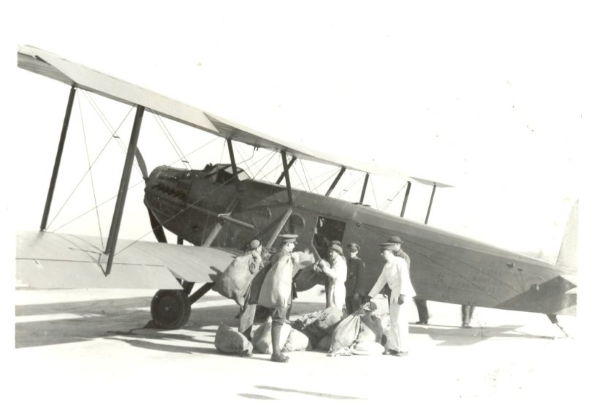
It is unknown when the first passenger aircraft services took place in the United States, but one of the earliest recorded instances was in 1913.
Sular Christofferson transported passengers between San Francisco and Oakland harbours by hydroplane.
Another early instance was in 1914 when passengers were carried from Tampa and St. Petersburg, Florida by a Benoist airboat.
One of the first steps in commercial aviation was the development of the multi-engine airplane by Alfred W. Lawson after WW1.
The Lawson C-2, built in 1919, was created specifically to carry passengers.
Related Article – Instrument Proficiency Check (IPC): 4 Things You Need To Know
The plane was somewhat a failure; the price of military aircraft was much cheaper, so the C-2 was not worth the price to buy.
Lawson went on to build the L-3 and L-4, both larger aircraft that were capable of carrying 34 passengers and up to 6,000 pounds of cargo.
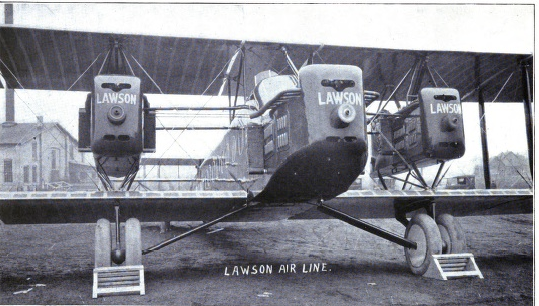
Problems arose once again, this time after the plane crashed on its first flight, causing the development of the L-4 to come to a halt.
In 1920, a Florida entrepreneur by the name of Inglis Uppercu started to offer international flights from Key West, Florida, to Havana, Cuba.
The service was eventually extended to other parts of the country, and there were flights between Miami and the Bahamas, New York and Havana, and the Midwest states of Cleveland, Ohio, and Detroit.
Uppercu’s Aeromarine Airways’ “airborne limousines” were going strong until one crashed off the coast of Florida, resulting in the death of four passengers and the company going out of business in 1924.
One of the big moments in commercial aviation came when mail began to be delivered by air.
In the early 1900s, the common means of transportation for mail was by railroad systems connecting cities in the country.
The first official airmail flight took place in 1918, and it rapidly increased after that.
Related Article – Airline Transport Pilot Certificate (ATP): 4 Things You Need To Know

By 1925, the U.S. Post Office was delivering 14 million pieces of mail per year by airplane.
This new mailing method was especially popular among those in the financial industry who wanted a quicker way to mail checks and documents.
Airmail was eventually transferred to private companies from the government, and the Contract Air Mail Act of 1925, known as the Kelly Act, was sponsored.
The act was the first big step in creating the private U.S. airline industry.
Soon after the establishment of the Kelly Act, the Post Office began to give out contracts to private companies after they bid on certain routes.
This continued to expand for almost a decade, and the private companies went on to become the major transportation players in commercial aviation.
Henry Ford was awarded the Chicago-Detroit and Cleveland-Detroit routes after obtaining the Stout Metal Airplane Company in 1925.
He went on to establish the Ford Air Transport Service, and he developed the “Tin Goose,” an all-metal Ford Trimotor.
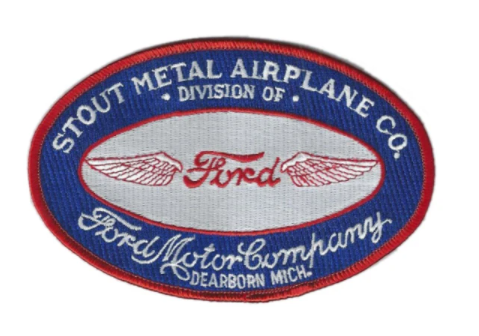
Ford was involved in the mailing industry for a short three years before going back to manufacturing.
The government created a national aviation policy in 1926 after President Calvin Coolidge appointed a board headed by Dwight Morrow, a senior partner in J.P. Morgan.
Morrow was not supportive of directly subsidizing airlines.
Instead, he wanted the government to fund a national air transportation system, which was taken up and recommended by Congress in the Air Commerce Act of 1926.
Related Article – 12 Runway Markings and Signs Explained By An Actual Pilot
The act gave a lot of authority to the Secretary of Commerce, who then had a role in the development of air navigation systems, air routes, the licensing of pilots and aircraft, and investigations surrounding accidents.
The Kelly Act was eventually amended by Congress, and the government carriers were paid based on the weight of the mail they were carrying.
These changes played a big role in the financial success of the airlines.
Research and training were also going through changes in the 1920s, especially with the establishment of a foundation by Harry Guggenheim.
His foundation aimed to develop flight instruments and educate aeronautical engineers at universities.
Besides his foundation, Guggenheim was involved in funding the Western Air Express, which included a $180,000 experiment to know if airlines could profit solely from passenger transportation.
The experiment failed after they were not able to make sufficient money without the subsidies.
The Western Air Express experiment was one of many that failed.
This changed in May of 1927 when Charles A. Lindbergh flew solo to Paris.
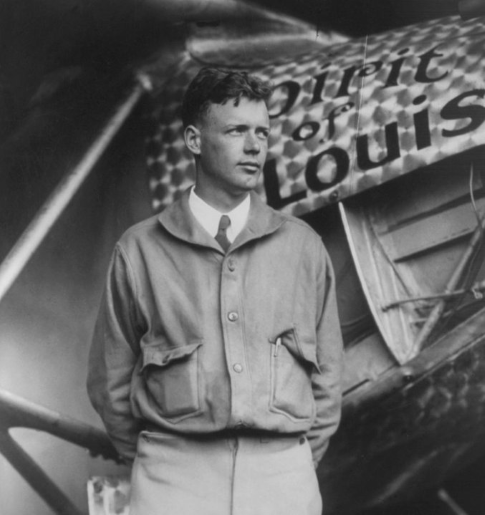
After the successful flight, investors were excited, and aviation stocks tripled between 1927 and 1929.
This helped propel the commercial aviation industry forward.
Even with all of the developments in commercial aviation, passengers could still get to their destination faster by train in the late 1920s.
There were too many limitations with planes compared to trains, which were able to travel through mountains, could run at night, and did not have to land and refuel like aircraft.
On top of that, trains were more comfortable than planes.
Passengers in the air dealt with loud noises, forcing them to put cotton in their ears, and the cabins were un-pressurized.
Despite all of the uncomfortable and limiting aspects of air travel, air travel grew in popularity.
The number of airline passengers in the United States went from less than 6,000 in 1926 to about 173,000 in 1929.
The passengers mostly consisted of businessmen, who increasingly had their tickets paid by employers.
The Ford Trimotor 5-AT, introduced in 1928 and produced through 1932, was popular among most U.S. airlines.
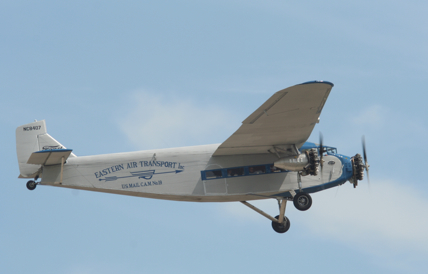
It carried up to 15 passengers, and there was one still being used all the way up until 1991 in Las Vegas.
The aviation industry continued to grow with the creation of jobs, airports, warehouses, aeronautical schools, and new technology.
The first instrument navigation package was used by U.S. Army lieutenant James Doolittle in September 1929.
Related Article – 5 Best Low Time Pilot Jobs With 250 Hours
Research at the Full Flight Laboratory, established by Harry Guggenheim, helped create an extremely accurate barometer, a radio direction beacon to help land, and a Sperry artificial horizon and gyroscope.
These allowed Doolittle to fly 15 miles without having to look outside his cockpit, revolutionary for air travel.
Even with all of the advancements and excitement in commercial aviation during the 1920s, the part of the industry dealing with passenger-only routes failed to make a profit.
It wasn’t until the 1930s that these airlines began to make financial gains.

Aviation in the 1920's
4.5 out of 5 (111 ratings), related articles you might be interested in:.
Leave a Reply Cancel reply
Your email address will not be published. Required fields are marked *
Notify me of follow-up comments by email.
Notify me of new posts by email.
- Publisher’s Message
- Editor’s Notebook
- Airline News
- Airport Community
- Airport Employment News
- Airport Safety & Security
- AOA Reflections
- Company Spotlight
- Ground Services
- New York Aviation History
- Non-Rev Traveler
- Airport & Aviation Events
- Airport Employment
- Latest Issue
Subscribe for Updates
Get the latest local airport and aviation news delivered right into your inbox each week!
By signing up, you agree to the our terms and our Privacy Policy agreement.
News Updates

Aviation Day at CUNY York College

Managing the Risks to Our Fragile Global Supply Chains

Queens Business Expo 2024

Travel By Air, The Golden Years: 1920s-1960s
The story of commercial air travel, in a heavier-than-air, winged aircraft, began on January 1, 1914, when the world’s first scheduled passenger service took to the skies in a single-engine Benoist flying boat piloted by pioneering aviator Tony Jannus for the St. Petersburg-Tampa Airboat Line. That morning, as a crowd of 3,000 gathered at St. Pete’s municipal pier, a ticket for the inaugural round-trip flight to Tampa was auctioned off, and former mayor Abraham Pheil won the honor with a bid of $400. Prior to lifting off from the St. Petersburg waterfront, Pheil climbed aboard the open cockpit biplane and squeezed onto a single wooden seat beside Jannus. Flying no higher than fifty feet over the water, the flight across the bay to Tampa took 23 minutes, as opposed to the two hours it would take by steamship, or the nearly 12 hours by railroad. Henceforth, the St. Petersburg-Tampa Airboat Line made two flights daily, six days a week, and charged a regular fare of five dollars per passenger. While the Airboat Line only operated for four months, it carried more than 1,200 passengers across the bay, and led the way for regularly scheduled trans-continental flights.
The Golden Age of Flight
In post-World War I, as the aviation industry grew, several commercial airlines began operations delivering U.S. Airmail, and then carrying passengers. In the 1920s and 1930s, the period between the two World Wars became known as the Golden Age of Flight. Many of the most notable early airlines were founded during this time period; Western Air Express and Ford Air Transport Service in 1925; Pan American Airways in 1927, which flew airmail from Key West to Havana, and Transcontinental & Western Airlines in 1930 (later TWA), when Western Air Express merged with Transcontinental Air Transport.
Life aboard a 1920s airliner was quite different from what it is today. Flying was a novel, upscale experience reserved for the wealthiest members of society and business travelers. Airliners carried less than 20 passengers and flew at lower altitudes in unpressurized cabins, frequently landing to refuel. Air travel was noisy and cold, and passengers wore their coats and hats to keep warm. In order to accommodate their every need, uniformed air stewards assisted passengers with their baggage and helped them board the aircraft. Onboard amenities included meals that typically included fruit compotes, cold fried chicken, and elegantly composed sandwiches served on lightweight dishware or wicker baskets. Before the advent of instrument flight in 1929, airplanes could not fly safely at night and had to circumvent mountains. Turbulence, lengthy flight times, airsickness, and other flight-related discomforts often resulted in travel anxiety. In order to keep air travelers at ease, airlines hired nurses to attend to passengers. In 1930, Ellen Church, a nurse and licensed pilot, was hired by Boeing Air Transport (now United Airlines) as the first female stewardess. Despite these discomforts, service evolved quickly in the 1930s. According to the Smithsonian National Air and Space Museum, the airline industry expanded from transporting 6,000 passengers in 1930 to over 450,000 by 1934, and 1.2 million by 1938.
The Douglas DC-3 would revolutionize commercial air travel when it had its first flight in 1935. Faster, larger, and more comfortable than its predecessors; the first DC-3, the Douglas Sleeper Transport, was the pinnacle of luxury, with plush seats in four main compartments designed to fold down from the cabin ceiling into sleeping berths. The aircraft could accommodate up to twenty-eight passengers for shorter day flights and fourteen overnight. As a reliable, economical, and profitable airliner, commercial aviation industry giants such as American, United, and TWA ordered the DC-3 for their fleets in 1936 and many other airlines followed suit in the next two years.

The 1930s heralded in many of the earliest commercial trans-Atlantic flights. Pan American Airways was a forerunner, carrying passengers across the Atlantic in their fleet of flying boats, or ‘Clipper’ aircraft. Transatlantic service began in May of 1939, first flying from Port Washington, Long Island, as the new Marine Air Terminal at LaGuardia was being built. That same year, Boeing 314s were considered the ultimate ‘Clippers’, carrying up to seventy-four passengers across the Atlantic and entering trans-Pacific service, linking all the continents in the Northern Hemisphere. The B-314 was a long-range flying boat that could land anywhere at sea, providing the destination had a sheltered harbor in which it could taxi to. But transport in the 314 was still reserved for the very wealthy, and a return ticket between Manhasset Bay in Port Washington to Southampton, England cost over $650; the equivalent of over $12,000 today.
Striving to provide the most pleasant flight experience, Pan American Airways set the gold standard of passenger service. The Boeing 314 had a large upper flight deck and a lower passenger cabin divided into five seating compartments. There was a galley kitchen, a baggage compartment, men, and women’s changing and restrooms, as well as a main lounge that converted into a dining room. White-gloved, tuxedo-clad stewards catered to their passenger’s needs. Meals were lavish experiences with gourmet foods and drink served on fine china, and silverware set on white linen tablecloths. Sleeping quarters on the 314 were roomier than earlier Clippers and its aft De Lux Compartment was called the ‘Bridal Suite’.
“I have heard many planes referred to as flying hotels, but none is more worthy of that description than the Pan American Airways Clipper.” A Wright Aeronautical Co. observer on a B-314 survey flight
First flown in 1938, the Boeing 307 Stratoliner was the first four-engine airliner with a pressurized cabin, allowing it to cruise at an altitude of 20,000 feet, well above the clouds and higher than rough weather. Pan American entered the B-307 into scheduled domestic service on July 4, 1940, with routes to Latin America, and from New York to Los Angeles. The nearly 12-foot-wide cabin carried thirty-three passengers in comfort and provided space for comfortable berths for overnight travelers, as well as observation areas for those who bought the more expensive seats. The airplane’s circular fuselage provided maximum space for five crew members and the Stratoliner was the first land-based airliner to have a flight engineer as a member of the crew.
With the onset of the Second World War, commercial air travel came to a virtual halt and was limited only to those serving the war effort. But commercial aviation, along with the aviation industry as a whole, grew substantially during wartime with the development and production of large-scale aircraft and the utilization of ex-military bombers and transports that were easily converted into commercial airliners. In the post-war years, Lockheed C-69 Constellations, used as transports by the U.S. Army Air Forces, were purchased from the government by TWA and converted into civilian airliners for their fleet. After TWA’s first transatlantic demonstration flight in the Constellation, or ‘Connie’ in December of 1945, TWA launched its transatlantic service in the Connie with a flight from New York to Paris on February 6, 1946.
The Golden Age of Air Travel
After 1945, American aircraft technology set the standard for international air operations, and toward the end of the 1940s, major carriers achieved a strong foothold on international travel.
As the decade of the 1940s ended, the era of commercial flight between the 1950s and 1960s was born and became known as the ‘Golden Age of Air Travel’ and the ‘Jet Age’. By 1950, the trans-Atlantic route became the most traveled in the world, and its growing trade produced high profits and intense competition between major international airlines. In the United States, commercial jet service began with the introduction of the Boeing 707 and Douglas DC-8. Larger and more economical than its previous airliners, Pan American began international flights on the B-707 in October of 1958. National Airlines soon began domestic jet service with the 707, and American Airlines opened its own domestic jet service in January of 1959, with a flight from New York to Los Angeles. At the end of the decade, for the first time in history, more people in the United States traveled by air than by railroad.

Despite its immense growth, air travel was still expensive and reserved for the elite – celebrities, and movie stars, who were called the ‘Jet Set,’ a name coined in the early 1950s by journalist Igor Cassini. Since commercial flight was still a unique, awe-inspiring event, passengers often documented their experience on airline postcards and posed for group photos prior to boarding. They dressed in their finest clothes, with women in dresses and heels, and men in tailored suits. First Class was spacious, and ‘economy’ seating provided up to six inches more legroom than today. With an increased market for air travel, airlines competed to outdo each other by offering their passengers extravagant amenities; in-flight entertainment, free-flowing cocktails, and fancy multi-course meals that included soup, salad, carved meats, vegetables, dessert, and even lobster. In a 1952 TWA (Trans World Airlines) ad captioned, ‘’Have dinner tonight with the stars!”, an elegantly dressed couple is depicted sitting before a lavishly set table while being served by a burgundy-coated steward and a perfectly coiffed stewardess in uniform and cap.
As the Golden Age of Air Travel led on, well into the 1960s, those who were fortunate enough to enjoy travel on the newest commercial jetliners featured some of the biggest celebrities of the day, including the Beatles, who arrived at JFK International in New York from London aboard a Pan American Boeing 707, to thousands of screaming fans, and some 200 journalists in February of 1964 ….fifty years after the first scheduled flight in the Benoist flying boat before a crowd of 3,000. And while the principles of flight remain the same, commercial air travel as we know it today may not be as lavish an experience as it once was during its Golden Days, but it certainly has come a very long way.

Experience the Golden Days of Air Travel
Today, the Pan Am Museum Foundation Exhibit at the Cradle of Aviation Museum in Garden City, Long Island pays tribute to Pan American World Airways as a pioneer in commercial aviation through the preservation of Pan Am artifacts, memorabilia, and images that commemorate the company’s history and the people behind this legendary airline.
Also today, at the TWA Hotel at JFK International Airport, visitors are welcome to view the New York Historical Society’s curated exhibitions celebrating TWA’s history. Located within and throughout the former iconic TWA terminal, designed by Eero Saarinen in 1962, the exhibits allow visitors to experience the Jet Age through authentic artifacts, interactive displays, uniforms, memorabilia, and personal narratives. Both are a must see!

Julia Lauria-Blum earned a degree in the Visual Arts at SUNY New Paltz. An early interest in women aviation pioneers led her to research the Women Airforce Service Pilots (WASP) of WW II. In 2001 she curated the permanent WASP exhibit at the American Airpower Museum (AAM) in Farmingdale, NY, and later curated 'Women Who Brought the War Home, Women War Correspondents, WWII’ at the AAM. Julia is the former curatorial assistant at the Cradle of Aviation Museum and is currently an editor for Metropolitan Airport News .
RELATED NEWS & UPDATES

Delta Air Lines Unveils the Team USA-inspired A350

API Selected by SkyWest for Full Suite of Crew Management Solutions

National, the Sunshine Airline

LaGuardia Gateway Partners Welcomes Frontier Airlines to LGA Terminal B

Korean Air to Roll Out Eco-Friendly Uniforms for Maintenance, Aerospace and Cargo Teams

Korean Air Celebrates 45 Years of Serving New York
Such an interesting historical synopsis of commercial aviation! Well done!
In June 1967 I flew out of El Toro Marine Air Base California towards Vietnam. I returned to SF International in September 1968 via another commercial airline. As did thousands of other GIs going to Vietnam but not so many coming home. I highly recommend purchasing the book by BJ Elliott Prior titled Behind My Wings.
Thank you for comments, Robert. I look forward to obtaining a copy of Behind My Wings and reading about the GIs returning home. I have very strong visual memories of the returning veterans, and especially the POWs.
Save my name, email, and website in this browser for the next time I comment.
This site uses Akismet to reduce spam. Learn how your comment data is processed .
Type above and press Enter to search. Press Esc to cancel.
Birth of Aviation
The history of commercial aviation, the birth of commercial aviation.
Commercial aviation has changed the world immeasurably, facilitating world trade and economic growth, bringing people together in a way that was not possible before, and simply making the world a more connected place. According to the International Air Transport Association (IATA), airlines in 2014 connected 3.3 billion people and 52 million tonnes of cargo over 50,000 routes, supporting 58 million jobs and delivering goods with a value of $6.8 trillion [ 1 ] . But when and where does commercial aviation find its inception?
COMMERCIAL AVIATION HISTORY
From the earliest beginnings, man’s ascent to flight has been one of gradual progress, accented by a handful of dramatic breakthroughs. The Wright Brother’s accomplishment would of course be one such breakthrough. Though several others can claim successful efforts at manned, powered flight prior to Kitty Hawk (see article, “First Human Flying Machines” ), the Wright Brothers hold a special place in history because of the profound and lasting impact of their achievement in relation to modern aircraft design (three-axis control).
Similarly, in the history of commercial aviation there is evidence of gradual evolution – from stunt plane and site seeing passenger flights to flying airboats that flew just a few feet above the water to the first real examples of modern air travel involving regularly-scheduled overland air service using land-based runways. And there are a few critical breakthroughs as well that would play a important role in the birth of a new industry. One of those breakthroughs was spurred on by a group of individuals in the mid-1920s led by the Guggenheims – a family who amassed a great fortune in the mining industry, and then turned their focus towards giving back to society. Together, they shared the vision of making passenger airtravel a sustainable reality, along with the spirit of boldness to make it happen. The elder Daniel Guggenheim would say of aviation at a 1925 groundbreaking ceremony for construction of the nation’s first school of aeronautics at a major American college, “I consider it the greatest road to opportunity which lies before the science and commerce of the civilized countries of the earth today.” [ 2 ]
Harry Guggenheim and Charles Lindberg leaving New Western Air Express plane in 1928. Courtesy of the Boston Public Library, Leslie Jones Collection.
Western Air Express pilot Jimmy James. [see page for license], via Wikimedia Commons
As such, when Western Airlines became part of Delta in 1986, Delta inherited bragging rights to the oldest ticket sold for passenger airtravel. No U.S. airliner in operation today can say it issued a ticket prior to the one sold in 1926 to Mr Ben Redman of Salt Lake City, Utah.
THE FIRST PASSENGERS
When Western Air Express pilot C.N. “Jimmy” James took off on his regular eight-hour mail delivery flight from Salt Lake City to Los Angeles on May 23, 1926 – almost exactly one year prior to the famous transatlantic flight of Charles Lindberg – he would do so carrying what was proudly referred to by Western Airlines CEO Arthur Kelly in 1961 as the “first commercial airline passenger”. [ 15 ] The recipient of this honor would be then president of the Salt Lake City Chamber of Commerce Ben F. Redman who, along with his friend (and second passenger) J.A. Tomlinson, sat atop U.S. mail sacks, sported his own parachutes, and relied on a tin cup for the in-flight lavatory.
Source: “Western Airlines Marks Anniversary of S.L. Flight”, Salt Lake City Tribune , April 17, 1944, p.16
Later, Redman and James would appear with Elliot Roosevelt, son of President Roosevelt, as Elliot would receive the honor of being the 100,000th passenger flying from Los Angeles via Western Air Express on that same route. (See below)
Source: “Elliott Roosevelt Inspects Airlines”, Salt Lake City Tribune , September 25, 1933, p.22.
“They took off at 9:30am and five hours later landed at Las Vegas to refuel. Redman and Tomlinson staggered out of the plane to stretch their legs and would have been forgiven if they had refused to reboard; for a good portion of the trip they had flown through a dust storm, and both passengers were pale from fatigue and nervousness. But they also were game, and three hours later climbed more or less jauntily out of the M-2, waving to the crowd of photographers and reporters gathered at Vail Field to record the arrival.” [ 16 ]
Upon completion of the inaugural flight, a certificate signed by the pilot Jimmy James was presented. The certificate (shown below) confirms Redman as the first official passenger , as well as recording details of the flight including maximum altitude reached (12,000 feet), the maximum speed (130 mph), total flying time (8 hours), and Contract Air Mail Route (No. 4).
Certificate confirming Mr. Ben Redman of Salt Lake City, Utah as the first official passenger to fly on Western Air Express. This was presented in a ceremony after WAE’s inauguration of passenger service on May 23, 1926, which represented the first “regularly scheduled passenger flight” in the United States. Part of the BirthofAviation.org Collection. ( see preferred citation )
FIRST TRUE SUCCESS STORY IN COMMERCIAL AVIATION
Perhaps most significant of all regarding Western Air Express’s inauguration of passenger service is that it marked the beginning of the first true success story in U.S. commercial aviation. For as mentioned there were a few early airboat ventures that did sell tickets for airtravel prior to 1926. Yet they would all end in bankruptcy, most going out of business shortly after their inception (see First U.S. Passenger Airlines ). The February 1976 edition of The Vintage Airplane thus declared, “Western Air Lines is the only survivor of airlines that pioneered commercial air transportation in the U.S. in the mid-twenties.” [ 17 ]
Vintage Art Poster shows a Western Air Express plane flying over the location where the Golden Gate Bridge now stands.
Helped by the Guggenheim grant, along with the infrasture and other innovations spawned by the model airline experiment over the next few years, Western would not only avoid bankruptcy but would go on to become an industry giant. After surprising many by posting a profit of $28,674.19 in its first year of operation, [ 18 ] [ 19 ] Western Air Express would the following year, in 1927, become the first airline in history to pay a cash dividend to its stockholders. [ 20 ] In 1928, it would post a profit of approximately $700,000. [ 21 ] And by 1930 it had become the largest airline in the nation by most overall standards of measurement – including fleet size, passengers carried, and route mileage with routes stretching 15,832 miles. [ 22 ] (That same year it would also introduce to the world of commercial aviation what was at the time by far the largest passenger plane in the world, the four-engined 32-passenger Fokker F-32, as shown below). [ 23 ]
Of course, the Guggenheim fund that helped fuel this success was never intended to provide an economic advantage to any one airline in particular, but rather to buoy the entire industry – and that is indeed what it did. The success of the model airline experiment would not only benefit Western but would in effect usher in the beginning of sustainable economic progress for all U.S. airliners through a number of key innovations.
One innovation of lasting impact achieved by the model airline would be the first weather reporting for passenger airplanes. In August 1927, the Daniel Guggenheim Committee on Aeronautical Meteorology was created to make pilots and meteorologists aware of each other’s specialties. The five-person committee, all of whom would achieve prominence in meteorology and two of whom would become chiefs of the Weather Bureau, recommended that the Guggenheim Fund equip a section of the airway system with weather reporting systems to prove the feasibility of such a system. Ultimately, it was decided to carry this out along the Western Air Express model air line route, resulting in an initial twenty-two reporting stations connected via telephone to Los Angeles and San Francisco, and soon later more would be added. These would serve all airmen, not just those of Western Air Express.
This project, involving collaboration from the Department of Commerce and the Weather Bureau, as well as the army, would add great benefit not only in economy of operation but also in safety. Lt. Col. G.C. Brant, at the time commandant of the Army Air Corps base at Crissy Field in San Francisco, would state, “The Guggenheim Experimental Airways Weather Service has done more to raise the morale of the Army Flying Corps than anything else that has happened since I became associated with it. Formerly a pilot did not know what was ahead, now he knows and is prepared.” [ 24 ]
A dazzling Lucille Ball is shown here after a flight on a Western Air Express Fokker F-10, a plane referred to as the “Queen of the Model Airline”.
Even though mail revenues still constituted the majority of income, and profitability solely from passenger service was still a few years away, the public relations impact, the technological advancements, and the lessons learned as a result of the model airline experiment would greatly facilitate eventual realization of profitability in the industry. Though there would be many ups and downs in the years to come, [ N 3 ] Western Air Express and the rest of the budding airline industry in America had positioned themselves on arguably the first path to sound economic success in the world of commercial aviation. Other carriers would soon follow Western Air Express’s lead in providing passenger service across the nation, with increasingly safe and cost effective passenger aircraft. America was officially on its way to emerging as a global leader. Western would even stake its claim not only as a domestic pioneer but as “ the world’s first economically successful venture in airplane transportation ” [ 27 ] . (See this referred to on Western’s First Anniversary Flight Postcard) . One of the reasons Western was able to make this claim is that although commercial aviation in Europe and other places around the globe got off to a quicker start in many areas including number of passengers carried, this didn’t translate to profits. As Tom D. Crouch, senior curator of aeronautics at the National Air and Space Museum, writes in Wings: A History of Aviation from Kites to the Space Age , “The pioneering postwar airline ventures in England, France, and Germany enjoyed some early successes. British and French air services carried sixty-five hundred passengers between London and Paris in 1920, with the three British operations carrying perhaps three times as many passengers as their French counterparts. At the same time, actual revenues amounted to only 17 percent of total costs.” [ 28 ] Many of these European ventures would not be long lived as a result of the unsound economics. And even many of those that did survive like KLM (officially the world’s oldest airline) would do so not because of economically successful operations in those days but because they were largely supported by government subsidies, unlike Western Air Express. [ 29 ] [ 30 ] [ N 4 ] As Woolley writes again in Airplane Transportation , “To secure consideration of the airplane as a commercial vehicle required, in Europe, direct financial assistance from government; in the United States, only evidence of its economic worth.” [ 31 ] And in 1936, Col. E.S. Gorrell, then president of the Air Transport Association of America, said of a partnership between five of the major airlines to build a 40-passenger super-airliner, “This contract marks a significant step for advancement of commercial aviation. Unlike every other country, where heavy government subsidies are devoted to the development and advancement of air transport aircraft, private enterprise in the United States, the individual operator, must carry this entire burden.” [ 32 ] [ N 5 ]
EXPONENTIAL GROWTH
When C.G. Grey, the editor of the English aeronautical journal Flight , arrived in New York in January 1925 to gauge the state of aeronautics in the United States. he commented, “The general atmosphere of aviation in America impressed one as being in a state when something is about to happen. Not so much the calm before the storm, but rather the slump before the boom.” [ 33 ] These words would prove to be prophetic as the U.S. airline industry would grow exponentially after 1926. With less than 6,000 airline passengers in the United States recorded in 1926, this would grow to approximately 173,000 in 1929, and a decade later this number would be approximately one million passengers. [ 34 ] [ 35 ] [ N 6 ] Col. E.S. Gorrell again commented in 1936, “Air passenger traffic has increased at a more rapid rate in the United States than anywhere else in the world, largely due to superior aircraft and operations methods. In the past five years passengers carried on domestic and foreign airlines under the American flag have increased from 385,000 in 1930 to nearly 1,000,000 in 1935.” [ 36 ] Passenger airtravel had become a reality. The U.S. aviation industry would eventually go on to represent the largest single market in the world, accounting today for over one‐third of the world’s total air traffic [ 37 ] (in addition to claiming the world’s largest airline, American Airlines). It may also be said that an even brighter future yet awaits it. In fact, by the year following the upcoming centennial of that inaugural passenger flight of Western Air Express (2027), the FAA projects air travel demand in the U.S. to top 1 billion passengers per year. [ 38 ]
At the same time, the real birth of commercial aviation is not merely a story of a landmark flight or even that of a handful of pioneers and philanthropists. It is the story of a nation. In order to make possible the conditions for success, many pieces needed to come together. And this would involve one of the greatest collaborative efforts in all of human history
LAYING THE FOUNDATIONS FOR SUCCESS
During the first decade or so following the Wright Brother’s first flight, America lagged behind Europe with regard to aviation. As C.V. Glines writes in an article published in the the November 1996 edition of Aviation History magazine:
The United States clearly was in the doldrums so far as aviation was concerned. By contrast, a year after the armistice, Britain and France were operating scheduled flights between London and Paris. The Germans had an all-metal transport 10 years before William Stout designed one for Henry Ford. The French had an internal airmail system that far outdistanced the United States’ fledgling airmail service. Italy’s Gianni Caproni had built a 100-passenger, eight-engine flying boat. And even the Russians, as far back as 1913, had a four-engine airliner designed by Igor Sikorsky that boasted an enclosed cockpit and passenger cabin, electric lights and a washroom. [ 39 ]
But even as America itself was founded in a story of “beating the odds”, so too would this generation of Americans rise up to meet the challenge before it – heeding the wisdom of the words spoken by one of the nation’s brightest businessmen and entrepreneurs of the time, Henry Ford: “When everything seems to be going against you, remember that the airplane takes off against the wind, not with it.” A movement would soon take off in America that would change its fortunes – a movement that would find its impetus when the U.S. Government first began experimenting with the use of planes to transport mail.
In 1917 Congress, acting on a recommendation from the National Advisory Committee for Aeronautics (NACA) which would later become NASA, appropriated $100,000 for the creation of an experimental airmail service. This would include involvement from both the Army and the Post Office. One of the contributions from the Army was providing pilots to fly the mail planes – a particularly dangerous job. In fact, during the period the Post Office operated the air mail, the life expectancy of a Mail Service pilot was only four years, and thirty one of the first forty pilots were killed in action. [ 40 ]
The Army also assisted with the initial deployment of rotating beacons that would make it possible to fly the routes at night. The Post Office would take over soon afterwards, expanding the guidance system the following year to make transcontinental air service possible. By 1923, mail could be delivered from one coast to the other in two days less time than by train.
Once the basic infrastructure was in place for airmail to work, the U.S. Government sought to transfer this service to private companies. As described in The Airline Handbook from Airlines for America (America’s oldest and largest airline trade association):
“Once the feasibility of airmail was firmly established and airline facilities were in place, the government moved to transfer airmail service to the private sector by way of competitive bids. The legislative authority for the move was granted by the Contract Air Mail Act of 1925, commonly referred to as the Kelly Act after its chief sponsor, Rep. Clyde Kelly of Pennsylvania. This was the first major step toward the creation of a private U.S. airline industry. [emphasis added]” [ 41 ]
Through a balance of government and private industry very much in harmony with the spirit of America, the stage was set for the dawning era in the history of aviation. The U.S. government through its numerous efforts to facilitate aviation nationwide would provide essentially a “hand up” to private enterprise, then largely get out of the way – even though it would step in once again though the Air Commerce Act of 1926 in order to provide needed coordination as well as a set of essential checks and balances. [ N 7 ] As described again in The Airline Handbook :
“The same year Congress passed the Contract Air Mail Act, President Calvin Coolidge appointed a board to recommend a national aviation policy (a much-sought-after goal of then Secretary of Commerce Herbert Hoover). Dwight Morrow, a senior partner in J.P. Morgan’s bank, and later the father-in-law of Charles Lindbergh, was named chairman. The board, popularly known as the Morrow Board, heard testimony from 99 people and, on Nov. 30, 1925, submitted its report to President Coolidge. The report was wide-ranging, but its key recommendation was that the government should set standards for civil aviation and that the standards should be set outside of the military. “Congress adopted the recommendations of the Morrow Board almost to the letter in the Air Commerce Act of 1926. The legislation authorized the Secretary of Commerce to designate air routes, to develop air navigation systems, to license pilots and aircraft and to investigate accidents. The act brought the government into commercial aviation as regulator of the private airlines that the Kelly Act of the previous year had spawned.” [ 42 ]
Through these acts of Congress in 1925 and 1926, the essential framework had been established, and the ground was ripe for the birth of a new industry. In fact, the initial Contract Air Mail (CAM) service carriers selected through this process would in time and through mergers and acquisitions go on to become key players in the airline industry, including American Airlines, United Airlines, Western Airlines (which as mentioned would eventually be acquired by Delta Airlines, who was also a CAM carrier beginning in 1934), Boeing, Pan Am, Trans World Airlines (TWA), Northwest Airlines, Braniff, Continental, and Eastern Airlines. These would also greatly influence the advancement of technology and infrastructure that would allow passenger airtravel to survive and prosper in the decades to follow.
Initial Contract Air Mail (CAM) Routes
Starting with an initial group of five, a total of 34 Contract Air Mail routes would eventually be established in the U.S. between February 15, 1926, and October 25, 1930.
The “first five” CAM contractors would include:
1926 – A WATERSHED YEAR FOR COMMERCIAL AVIATION
The aforementioned book Airplane Transportation by James Woolley was used as a textbook at the University of Southern California and several other schools. With contributing works from famed meteorologist Carl-Gustav Rossby and William P. MacCracken, Jr., the first federal regulator of commercial aviation appointed in 1926, its emphasis was to teach the business elements of the arising “new industry” to all those eager to acquire “knowledge of the airplane and its potentialities as an agency of commerce”. [ 43 ] In the opening of the first chapter, Woolley describes the state of commercial aviation in the eyes of the nation at the time:
“Within the past two years America has awakened to the presence of a new and vital agency in transportation; a medium, which, although at present only slightly understood, holds promise of development beyond grasp of the most vivid imagination. True, the airplane as a vehicle has been known to us for more than one-quarter century but its adaptation to commerce dates only from the termination of the World War and its economic worth had not been definitely established previously to 1926.” [ 44 ]
1926 was a watershed year for commercial aviation. It would be one of many key milestones, and one that would see the first economic successes.
As mentioned, 1926 would be the year of what has been referred to as the first true commercial passenger flight in the United States. Additionally, the Federal Aviation Association’s most recently published chronology dates back to that year (FAA Historical Chronology, 1926-1996), beginning with the Air Commerce Act. And in 1976 – coinciding with the nation’s bicentennial – the U.S. Post Office would issue the Commercial Aviation Commemorative Stamp marking the “golden anniversary of commercial aviation in the United States” with the description “Commercial Aviation, 1926-1976″ ( See the first day of issue cover for this stamp ).
The Commercial Aviation Commemorative Stamp issued by the U.S. Post Office in 1976
1926 being the year the “CAM” carriers would began carrying U.S. Air Mail under contract, the planes shown on the 1976 stamp were the first two to do so: the Ford-Stout AT-2 (upper) and Laird Swallow (lower).
Other groups, such as the Aviation Historical Society, would also honor 1926 as the true beginning of U.S. commercial aviation (as shown below).
An enveloper cover from the Aviation Historical Society Honoring the 50th Anniversary of U.S. Commercial Aviation
In addition to numerous legislative and general infrastructure advancements, there were other factors as well that led to the growth of passenger airtravel in the United States beginning in the mid-1920s. One of those can be attributed to the contributions of automobile pioneer Henry Ford. In 1925, Ford began a commercial cargo airlines called the Ford Air Transport Service and would be awarded the CAM6 and CAM7 airmail routes. Although not receiving one of the initial five routes, he would actually be the first of the carriers to begin operation in 1926, staking the company’s claim as “the world’s first regularly scheduled commercial cargo airline.” [ 45 ] He would soon abandon that venture however in favor of focusing on airplane manufacturing, selling its routes to Stout Air Services (which was eventually acquired by National Air Transport (NAT) who in turn became part of United Airlines).
It was in two primary areas that Ford would help shape the history of commercial aviation. The first of those was in airplane technology, through the introduction of the Ford Trimotor – the first all-metal, multi-engine transport in the United States and the first plane designed primarily to carry passengers rather than mail (having room for 12 passengers and cabins with high ceilings that didn’t require stooping).
The Trimotor’s three-engine design made for significant improvements in relation to speed and altitude – ultimately enabling it to become the first plane to be used for transcontinental passenger service, as well as the first plane to fly over the South Pole. Dubbed the “Tin Goose”, a total of 199 Ford Trimotors were built between 1926 and 1933. And its impact on commercial aviation was immediate, with the design helping to make passenger airtravel potentially profitable for the first time. It would be labeled as the “first successful American airliner” and said to represent a “quantum leap over other airliners.”
Ultimately, the Great Depression ended Henry Ford’s short career as a major figure in American aviation. He would pass the baton to companies like Boeing, who introduced the Boeing 247 in 1933, and the Douglas Aircraft Company whose DC-3 would revolutionize air transportation for the next decades (along with Wright Aeronautical and Pratt and Whitney who would dominate the engine market for years to come). In the meantime, however, United Aircraft and Transport Corporation took over the Ford airmail routes in 1929 and the Ford Airplane Manufacturing Division closed for good in 1933. Though similar to the way Ford’s durable Trimotor planes seemed to last forever (One Trimotor 5-AT, built in 1929, was still being used in Las Vegas for sightseeing in 1991), [ 46 ] so was Ford’s impact on commercial aviation long lasting. Not only did the advancements in plane construction help move the industry forward, but Ford was also instrumental in a second important breakthrough: gaining the American public’s trust when it came to flying.
When the public saw that Ford had its name on airplanes used for passenger service, it gave an entirely new level of legitimacy to the idea of safe and reliable passenger airtravel. As famous 1920s and 1930s actor Will Rodgers would comment, “Now you know that Ford wouldn’t leave the ground and take to the air unless things looked pretty good to him up there.” [ 47 ]
Ford’s involvement in airplane manufacturing, coupled with the government legislation of 1925-1926, provided a stamp of approval in the eyes of the public and for the first time ever passenger flight began to be seen not as merely a novel and risky venture, but as a new and trustworthy way of travel. In fact, just as Ford traveled around the country through his “Reliability tours” to promote the idea that the automobile had come of age in America, so did he do the same for the airplane – in part through the aerial version of his Reliability Tours, the Ford National Reliability Air Tour.
CHARLES LINDBERG
The Airline Handbook describes the bold and revolutionary accomplishment:
“In planning his transatlantic voyage, Lindbergh daringly decided to fly by himself, without a navigator, so he could carry more fuel. His plane, the Spirit of St. Louis, was slightly less than 28 feet in length, with a wingspan of 46 feet. It carried 450 gallons of gasoline, which constituted half its takeoff weight. There was too little room in the cramped cockpit for navigating by the stars, so Lindbergh flew by dead reckoning. He divided maps from his local library into thirty-three 100-mile segments, noting the heading he would follow as he flew each segment. When he first caught sight of the coast of Ireland, he was almost exactly on the route he had plotted, and he landed several hours later, with 80 gallons of fuel to spare. Lindbergh’s greatest enemy on his journey was fatigue. The trip took an exhausting 33 hours, 29 minutes and 30 seconds, but he managed to remain awake by sticking his head out of the window to inhale cold air, by holding his eyelids open, and by constantly reminding himself that if he fell asleep he would perish. In addition, he had a slight instability built into his airplane, which helped keep him focused and awake. Lindbergh landed at Le Bourget Field, outside of Paris, at 10:24 p.m. Paris time on May 21. Word of his flight preceded him and a large crowd of Parisians rushed out to the airfield to see him and his little plane. There was no question about the magnitude of what he had accomplished. The age of aviation had arrived.” [ 48 ]
As a young U.S. Air Mail pilot hired in 1925 by the Robertson Aircraft company (that would later become American Airlines) to fly the CAM-2 mail route between St. Louis and Chicago, Lindbergh was suddenly thrust into the spotlight as an American hero, as well as the first person to ever be in New York one day and Paris the next. It captured the imagination of the public in relation to the capabilities of modern airtravel, as well as the imagination of investors. Though many in years past had invested in aviation ventures that had failed, suddenly there was a rush to Wall Street to invest in aviation, with investments in aviation stocks tripling between 1927 and 1929.
After his legendary feat, Lindbergh was faced with enthusiastic crowds wherever he went. He gave numerous speeches, participated in parades, and received many awards, including the Distinguished Flying Cross medal from President Calvin Coolidge, using his status as an American icon and international celebrity to further aviation along with other noble causes.
THE GUGGENHEIMS
As mentioned, the Guggenheim family also served as an important catalyst in the rise of commercial aviation. And this involved far more than generous financial contributions. The philanthropic efforts of the Guggenheims were far reaching and brought together some of the brightest minds in the nation. Tom Crouch writes again in Wings: A History of Aviation from Kites to the Space Age :
“Daniel Guggenheim began to discuss the possibility of expanding his involvement, spending several million dollars on the creation of a fund that would support civil aviation. Father and son, the Guggenheims discussed the idea with everyone from Orville Wright to Secretary of Commerce Hoover and President Coolidge. The decision to forge ahead had been made by January 1926. The Daniel Guggenheim Fund for the Promotion of Aeronautics would support aeronautical education; fund research in “aviation science”;promote the development of commercial aircraft and equipment; and “further the application of aircraft in business, industry and other economic and social activities of the nation.” Running it would be a blue-ribbon panel of leading figures from aviation, business, finance, and science, including the inventor of the airplane and a Nobel laureate in physics.” [ 49 ]
The fund would go on to create schools of aeronautics at major universities, including Stanford, MIT, and Harvard, among several others. The impact would be far reaching with respect to the research conducted, the technological discoveries made, and perhaps most importantly the development of the graduates – from pilots to engineers to meteorologists.
One of those graduates was Herbert Hoover, Jr., son of 31st President of the United States Herbert Hoover and eventual Secretary of State under President Eisenhower. Hoover won a fellowship from the Daniel Guggenheim Fund to study aviation economics at the Harvard Business School, and would focus on the economics of radio in the aviation sector. He would use that education to help Western Air Express, in cooperation with Thorpe Hiscock of Boeing, to develop the first ever air-to-ground radio while serving as Western’s communication chief.
Under his guidance, Western would also establish a system capable of guiding radio-equipped aircraft along 15,000 miles of airways across the Western U.S. And in 1930 he would be elected president of Aeronautical Radio Inc. – a non-profit alliance between Western Air Express, Boeing and American Airways that represented the airline industry’s single licensee and coordinator of radio communication outside of the government. This selection led to Time Magazine putting Hoover on the cover of its July 14, 1930 edition.
Herbert Hoover Jr (middle) with Western Air Express pilots Jimmie James (left) and Fred Kelly (right)
Even beyond education, the Guggenheim fund would make major contributions to the aviation industry. An example was its revolutionary breakthroughs in relation to “blind flight”, addressing the problems faced by pilots in three main areas: point-to-point navigation while in fog or above clouds, maintaining straight and level flight via instrument readings, the usage of ground facilities for take off or landing assistance in poor visibility conditions.
In September 1929, a young U.S. Army lieutenant named James Doolittle took off from Mitchell Field in New York on a 15-minute test flight. When his wheels touched down, he had reached a major milestone in aviation history, being the first plane in history to take off, fly a precise flight path, and land, with its pilot not using any visual cues outside of his cockpit instruments. The instruments that made this possible included a very accurate barometer, an artificial horizon and gyroscope, and a radio direction beacon – all developed through research at the Guggenheim Full Flight Laboratory. Within the next decade, instrument flying would become routine for all airlines. One of the congratulatory telegrams sent to Harry Guggenheim upon this achievement came from famed explorer Robert E. Byrd, who sent the message from his camp on the Antactic ice cap. At the end, he added “I know of nothing that has done as much for the progress of aviation as your organization.” [ 50 ] The Guggenheim Fund would end in 1930, concluding very much in the same spirit of the U.S. government’s previous involvement in helping aviation to forge ahead. Daniel Guggenheim would state, “With commercial aircraft companies assured of public support and aeronautical science equally assured of continual research, the further development of aviation in this country can best be fulfilled in the typically American manner of private business enterprise.” [ 51 ]
Though the fund would cease, however, its impact would live on – as would the Guggenheim’s work through other avenues. The Guggenheim foundation for example established such entities as the Cornell-Guggenheim Aviation Safety Center at Cornell University where important research took place in relation to collision avoidance, crash fire protection, and other aspects of safety improvement. The Guggenheim Medal fund would be awarded annually to individuals making exceptional contributions to aviation, with the first going to Orville Wright. And the Guggenheims sponsored much of the research of Dr. Robert J. Goddard, upon which all modern developments of rockets and jet propulsion was based.
Arguably though, the greatest impact of the Guggenheim legacy remains that of the decision to provide funding to a courageous group of aviation trailblazers and the establishment of the world’s first “model airline”. Together, the Guggenheims and Western Air Express would pioneer the first semblences of airtravel as we know it today – year round, regularly scheduled, overland service using landplanes – and pave the way for the first truly self sustaining and economically successful model in commercial aviation.
The legacy and impact of the Guggenheim Fund would live on many years past the end of the model airline experiment, as would that of Western which would go on to establish many industry firsts [ N 8 ] . In fact, Western would eventually take on the label of “America’s senior air carrier” as well as the “oldest continuously operating airline in the US” [ 52 ] [ 53 ] [ N 9 ] at the time of its acquisition by Delta in 1986. Even as it became part of the Delta family, the innovations and progress of Western, much of which was derived from its earliest years, [ N 10 ] would carry on not only in spirit but in everyday business operations. To this day, for instance, Delta continues Western’s Salt Lake City hub operations, which is the same location from where that first passenger flight of Western Air Express took place in 1926 – an event that would set in motion the first true success story in commercial aviation.
When history is remembered, what generally emerges to the forefront are not necessarily the “firsts”, but the events, discoveries. and individuals that had the most powerful influence in shaping the future.
Christopher Columbus was not the first to discover America. Yet the fact that his name looms larger in history than many of those who proceeded him – including the Vikings led by Leif Erickson, the waves of Carribean explorers like the Taino tribe, and potentially even Monks like St. Brendan who it is believed made the journey in the sixth century – is because of the unparalleled impact of his explorations. Christopher Columbus opened up a new continent to Spain and, ultimately, all of Europe. His discovery had a profound and lasting impact on the trade routes of the day. And his voyages would ultimately reshape the known world.
Similarly, Henry Ford did not invent the automobile and yet his name is synonymous with it. For it is he who changed the landscape of a nation, and world, by making the automobile an affordable reality to the average person. Through use of the assembly line technique of mass production, and by lowering costs as opposed to pocketing profits from the resulting cost savings, Ford’s company would go on to lead the American industry to produce three quarters of all automobiles in the world by 1950.
Taking transportation to the next level would be the Wright Brothers, even though technically they were not the first to fly manned aircraft. In addition to those lifted by hot air balloon and airships such as Jean-François Pilâtre de Rozier who flew the first manned free balloon flight on November 21, 1783, there are others who flew heavier-than-air crafts in the rough form of the modern day airplane beginning in the early 1800s. And while many of the pioneers who did so would make significant contributions to the science and eventual realization of powered flight (which the Wright Brothers themselves would even rely upon), the Wright Brothers hold a special place in history because of the unique impact they had on airplane design. While other early inventors experimented with the shifting of a persons weight to control or steer the plane, for instance, the Wright Brother’s revolutionary invention of “three-axis control” would make fixed-wing powered flight truly possible for the first time ever and would be adopted universally in aircraft design moving forward. Tom D. Crouch, who as mentioned holds the position of senior curator of aeronautics at the National Air and Space Museum, described why the invention of the Wright Brothers is given precedence as first to achieve “powered, heavier-that-air flight” over the work of competing inventor Augustus Moore Herring, saying “Herring’s 1898 motorized machine represented nothing more than the culmination of the hang-gliding tradition. Having made his brief powered hops, he found himself at a technological dead end.” [ 54 ]
In a similar way, there were various early attempts to launch the world of commercial aviation, ranging from paid sightseeing flights on crop dusters to a handful of failed airboat ventures. But perhaps the most significant breakthrough came via a great American success story – that of the Guggenheims and Western Air Express, and of the movement of the mid-1920s that involved one of the greatest collaborations in human history. From the legislation that laid the early groundwork to the humble beginnings of a two-passenger inaugural flight in an open cockpit atop mail sacks to the investments made by many, this is a story of American ingenuity, of the unique American balance between government and private enterprise, and of the spirit of the American West.
These truths are emphasized not merely in the spirit of American patriotism, but more so in the spirit of the model airline experiment – that the success of one might benefit many (also an American principle). For the hope is that the blueprint discovered here might lead others to greater successes, whether nations or groups of individuals or other generations of Americans. After all, it is poetic that the movement which brought forth the kind of advancements that would connect the world as never before, was done through such a great collaboration of people. The profound words found on the website for the Wright Brothers Aeroplane Company seem most fitting in this regard, describing one of the true motivations that drove the two brothers to pursue their dream of building their flying machine: “Seen from above, the artificial boundaries that divide us disappear. Distances shrink, the horizon stretches. The world seems grander and more interconnected.” [ 55 ] And Western Air Express pilot Al DeGarmo said of his friend and famed Hollywood actor Will Rogers, “He believed air travel was key to this country’s growth. Air travel was something everyone would be doing one day, he said, and it would help break down differences that divided nations.” [ 56 ]
Today the Wright Brothers are recognized as among the greatest of the pioneers of flight – though it wasn’t until after they died that they were finally credited over such men as Samuel Pierpont Langley as being the first to build a heavier-than-air craft capable of manned powered flight. It sometimes takes time for the truest heroes of history to be appropriately honored. Hopefully this story of the beginning of commercial aviation will be told with greater attention paid to these great men and women who took the baton from the Wright Brothers and brought aviation to the next stage of development. For while the Wright Brother’s sought and achieved sustainable (and controlled) flight, these pioneers of the mid-1920s sought and achieved sustainable economic growth that would make it possible to take the innovations of the Wright Brothers and turn them into the means of forever changing the world of global transportation.
- ^ It is worth noting that the Guggenheims didn’t expect to be paid back for this loan and in fact told Western Air Express founder Harris Hanshue this was more in the nature of a grant. However, Hanshue refused to accept the money as a gift and insisted on inserting a clause into their agreement that stipulated Western was to repay the loan within eighteen months at 5% interest. Hanshue also put up some $100,000 in public-utilities securities to guarantee the loan.
- ^ Robert Serling writes on pages 6-7 of The Only Way to Fly: The Story of Western Airlines America’s Senior Air Carrier , “…there is one thing to be noted about all these early airline efforts [prior to 1926] – every one involved the use of flying boats, not landplanes. Airfields throughout the United States, with few exceptions, were too primitive, inadequate, and actually dangerous to warrant confidence on the part of the public or airmen themselves. Not until the government – prodded by the growing demand for regular air mail service-established lighted airways and modest airport improvements did scheduled air transportation become feasible between inland cities.”
- ^ It should be noted that the road to prosperity for Western and the industry in general was not only filled with successes, but involved setbacks as well. One particularly dark chapter in the history of the commercial aviation industry occurred during the 1930s, though the Air Mail Act of 1930 that consolidated all of the air mail routes to only three companies (United Airlines, TWA, and American Airlines) and the resulting investigation of a 1930 meeting (the so-called Spoils Conference) involving postmaster general Walter Brown and representatives of the three airlines to whom he would later award the air mail routes. This would be referred to as the Air Mail Scandal and Air Mail Fiasco by the American Press as the actions under the new legislation were accused by many of being a corrupt effort of conspiracy to monopolize the air mail. Though allegations relating to this were never proven, there was enough room for suspicion to convince President Franklin D. Roosevelt to cancel the contracts altogether and have the Army Air Corps take over the service. This would not only negatively impact the airline industry in general, but would have disastrous results in many ways since Air Corps’ airplanes could not meet the demands of night flight, let alone bad weather. There were many deadly crashes and lost lives, until finally later the same year Congress passed the Air Mail Act of 1934, which returned most air mail routes to the major airlines as well as gave some routes to smaller airlines.
- ^ While Western Air Express greatly benefitted from infrastructure improvements and other provisions of the government, it was able to attain profitability without any direct government subsidies. It also received a low interest 5% loan of $155,000 to be paid back over 2 years courtesy of the Guggenheim Fund in 1927, which enabled it to purchase three Fokker passenger planes. Even after the first of its two annual loan payments was made to the Guggenheims in 1928, WAE was still able to report a net profit of nearly $700,000 on $1.4 million in total revenue (most of this though still coming from mail revenue at the time).
- ^ This cooperative agreement between five competing airlines marked the first time in the history of aviation that major airlines combined their experience and finances for the development of an experimental plane to meet future needs. And the joint effort was a giant success. It is estimated that had each of the five airlines carried out development efforts separately, it would have cost them approximately $2,000,000 more, the equivalent of four additional experimental planes.
- ^ US Department of Commerce statistics report 1,176,858 passengers flew on US commercial airliners in the year 1938. American operated scheduled air carriers would also set all-time records that year for the number of miles flown and passengers and express carried, according to reports received by the Civil Aeronautics Authority (as cited in Popular Aviation , September 1939. p.26).
- ^ Some of this power given to government would be rescinded in 1978 through the Airline Deregulation Act passed by the U.S. Congress which removed government control over fares, routes and market entry (of new airlines) from commercial aviation. While this regulatory control was probably needed in the early years of US aviation, deregulation in 1978 had a positive impact of driving airfare to more affordable rates, and consequently dramatic growth in passengers flown. As Supreme Court Justice Stephen Breyer pointed out in 2011, “In 1974 the cheapest round-trip New York-Los Angeles flight (in inflation-adjusted dollars) that regulators would allow: $1,442. Today one can fly that same route for $268.”
- ^ Western Airlines was the first to develop and use air-to-ground radio (1929), the first to have weather reporting stations (1927), first to fly 10 years without injury to a passenger (1926-1936), the world’s first profitable air transportation system (1926), the first airline in history to pay a cash dividend to its stockholders (1927), the first “regularly scheduled, year-round, overland passenger service” in the U.S. (1926), the first to offer in-flight meals (1928), the first to have flight attendants in U.S. domestic service (1928), the first to introduce commercial four-engine transports, the first to feature airborne television, the first to offer limousine service, and the first to provide log books for passengers.
- ^ At the time of Western’s merger with Delta, there was some controversy between Western and United Airlines over which was officially the oldest. United was originally formed by United Aircraft and Transport Corporation, a partnership between Boeing Airplane Company and Pratt & Whitney. The larger corporation officially established an operating division known as United Air Lines on July 1, 1931. That same year, however, it would purchase Varney Airlines. While Western preceded Varney in relation to the introduction of passenger service, Varney beat out Western (by a margin of 11 days) in flying “fixed routes” with respect to airmail delivery.
- ^ Many of the learnings and advancements of the Model Airline experiment became an ongoing part of Western’s business operations moving forward. As Robert J. Serling writes in The Only Way to Fly , “The so-called Model Airway experiment never really ended; rather, it gradually was absorbed into Western’s normal operations, and the lessons learned were incorporated into the airlines procedures and policies.”
- ^ A Global Mindset for Commercial Aviation’s Next Century . Retrieved 2014-12-12.
- ^ Daniel Guggenheim quoted in C.V. Glines, “The Guggenheims: Aviation Visionaries,” Aviation History 6 (November 1996)(as cited in Tom D. Crouch, Wings: A History of Aviation from Kites to the Space Age , (New York, N.Y.: W. W. Norton & Company; Reprint edition (November 17, 2004)), p.238).
- ^ Richard O. Hallion, Legacy of Flight: The Guggenheim Contribution to American Aviation , University of Washington Press. 1977. p. 88.
- ^ The National Aviation Hall of Fame: Harry Guggenheim , Retrieved 2014-07-04.
- ^ Robert E. Dallos, “Pioneer Western Pilot Recalls Day It All Began : Airline Has Come a Long Way Since 1st Flight in 1926”, Los Angeles Times , April 06, 1986
- ^ Beating the Odds: The First Sixty Years of Western Airlines , Western Airlines, 1985
- ^ Delta Flight Museum: Western Historical Timeline , Retrieved 2014-07-04.
- ^ Hallion, p. 87.
- ^ “Western Airlines Marks Anniversary of S.L. Flight”, Salt Lake City Tribune , April 17, 1944, p.16.
- ^ “S.L. Will Commemorate First Commercial Flight”, Salt Lake City Tribune , December 12, 1934, p.36.
- ^ Nevada Aerospace Hall of Fame: Harris M. Hanshue . Retrieved 2014-11-11.
- ^ “Officials, Public Laud ‘Unique’ Air Terminal”, Salt Lake City Tribune , June 18, 1961, p.14.
- ^ Robert J. Serling, The Only Way to Fly: The Story of Western Airlines America’s Senior Air Carrier , (Garden City, New York:Doubleday & Company, 1976), p.40.
- ^ Claude Gray, “The Old West”, The Vintage Airplane , February 1976, p.12.
- ^ Serling, p.76.
- ^ Ibid, p.94.
- ^ Grant quote from Bowie, “Weather and The Airplane,” p.17 (as cited in Hallion, p. 97).
- ^ James G. Woolley and Earl W. Hill, Airplane Transportation (Hollywood, Calif.:Hartwell, 1929), p.45.
- ^ Ibid., 69.
- ^ Ibid., foreward.
- ^ League of Nations, Inquiries into the Economic Administration and Legal Situation of International Aerial Navigation (geneva: League of nations, 1930), p.8; Ronald Miller and David Sawer, The Technical Development of Modern Aviation (London: Routledge and Kegan Paul, 1968) p.13 (as cited in Tom D. Crouch, Wings: A History of Aviation from Kites to the Space Age , (New York, N.Y.: W. W. Norton & Company; Reprint edition (November 17, 2004)), p.209).
- ^ Crouch, p.209-210
- ^ Carlos A. Schwantes, Going Places: Transportation Redefines the Twentieth-century West, (Indiana University Press, 2003), p. 8.
- ^ Woolley, p.21.
- ^ “Five Airlines Unite to Finance Super-Ship” , Berkeley Daily Gazette , March 19, 1936, p.8
- ^ Nick Komons, Bonfires to Beacons: Federal Civil Aviation Policy under the Air Commerce Act, 1826-1938 (Washington, D.C.: U.S. Department of Transportation, 1978), 66 (as cited in Crouch, p.239.).
- ^ Andrew R. Thomas, Soft Landing: Airline Industry Strategy, Service, and Safety , Apress. 2011, p.22.
- ^ Popular Aviation , September 1939. p.26
- ^ Global Airline Industry Program: Airline Industry Overview , Retrieved 2014-07-04.
- ^ Airlines For America . Retrieved 2014-07-04.
- ^ Charles Perrow, Normal Accidents: Living with High Risk Technologies (Princeton University Press 1999), p.125
- ^ Airline Handbook Chapter 1: Brief History of Aviation . Retrieved 2014-07-04.
- ^ Woolley, foreward.
- ^ Ibid., 1.
- ^ Henry Ford, Ford Motor Company Founder And Aviation Pioneer”
- ^ Century of Flight: Commercial Aviation 1920 to 1930 . Retrieved 2014-07-04.
- ^ Nick Komons, Bonfires to Beacons: Federal Civil Aviation Policy under the Air Commerce Act, 1826-1938 (Washington, D.C.: U.S. Department of Transportation, 1978), 67 (as cited in Crouch, p.249.).
- ^ Crouch, p.237.
- ^ Telegram, Byrd to HFC, Sept. 27, 1929, DGF Papers, box 2 (as cited in Hallion, p. 124).
- ^ Delta Flight Museum: Family Tree . Retrieved 2014-07-04.
- ^ Crouch, p.220 (as cited in First in Flight? Americanscientist.com retrieved 7-4-14)
- ^ The Wright Story , Wright Brothers Aeroplane Co. retrieved 7-4-14.
- ^ Beating the Odds: The First Sixty Years of Western Airlines , Western Airlines , 1985, p.5.
The History of Commercial Flight: How Global Travel Took off
This is how commercial flights went from being exclusively for the wealthy to the mainstream and affordable option they are today.
DALLAS - Flying has become the transport of choice for business travelers and holidaymakers across the globe and is now considered one of the fastest, most convenient, and safest forms of long-distance travel.
But how did commercial flights go from being exclusively for the wealthy to the mainstream and affordable option they are today? Artemis Aerospace guides us through the different decades of air travel and how it has shaped modern-day living.
Listen to this article:

The First Commercial Flight
The first ever passenger flight took off in May 1908 when Wilbur Wright carried Charles Furnas just 2000 feet across the beach at Kitty Hawk, North Carolina. Just one year later, the first airline in the world, the German airship company DELAG, was founded.
In 1914, the world’s first scheduled passenger service, an airboat piloted by Tony Jannus, set off from St. Petersburg, Florida, and landed at Tampa, around 17 miles away. The service only ran for four months, but it had unlocked the appetite of those keen to tap into the novelty of air transport.

A New Era of Aviation
However, it wasn’t until the 1920s that commercial flights carrying paying passengers started to become commonplace with the introduction of the multi-engine airplane, the Lawson C-2, which was specifically built to carry passengers.
During this time, more and more start-up airline carriers were being established, some of which are still in operation today. These include KLM in the Netherlands (1919), Colombia’s Avianca (1919), Qantas in Australia (1920), and Czech Airlines (1923).
Aircraft from this period would land frequently to refuel and fly at lower altitudes due to unpressurized cabins. This made traveling by plane noisy, cold, and expensive. Flying times were lengthy, and turbulence was frequent. Passengers regularly experienced air sickness, and many airlines hired nurses to reduce anxiety and tend to those affected.
In 1935, one of the world’s oldest airlines, Qantas, operated its first international passenger flight, traveling from Brisbane to Singapore. From there, British-owned Imperial Airways connected this flight to the UK. This was to set the wheels in motion for creating a regular travel route between Australia and the UK in the coming decades.
Despite flying being incredibly dangerous and extremely expensive during this period, it was still a fashionable way to travel for the rich. According to the Smithsonian National Air and Space Museum, the number of airline passengers grew from just 6,000 in 1930 to nearly half a million by 1934; the aviation industry was well on its way to becoming hugely important to the global economy.

Innovation That Revolutionized Air Travel
The introduction of the Douglas DC-3 in 1935 also had a big impact on the future of commercial flight. The propeller-driven airliner was a larger and much improved aircraft compared to its predecessors. Faster and more reliable, it could carry up to 32 passengers and had a cruising speed of 207 mph with a range of 1500 miles. This made it popular with well-established airlines, including Delta, TWA, American, and United, who soon added the aircraft to their fleets.
During the 1940s, the onset of WWII meant commercial aviation developments slowed considerably. However, by the end of the decade, the industry was heading towards a new era as Pan Am began operating its fleet of Boeing 307s, which featured the first-ever pressurized cabin.
This transformed air travel for passengers, allowing them to enjoy a comfortable experience at an altitude of 20,000 feet. Major airlines were now ramping up their advertising spending and offering travelers smooth journeys to far-flung destinations and business hubs, including Pan Am’s iconic New York-London route.

The Golden Age of Air Travel
The 1950s and 1960s heralded the age of jet engine aircraft, and with it came an upsurge in commercial flights, airline carriers, and international flying routes.
Commercial air travel was booming, and major airlines were fiercely competitive, offering passengers more and more inflight perks, including lavish silver-service meals and fine wines.
Pan Am was a front-runner in pioneering and marketing the very best air travel had to offer. It was the first airline to fly worldwide and introduced ground-breaking changes to the industry, such as adding jet aircraft to their fleets and utilizing computerized reservation systems.
In the 1960s, work began on creating the world’s first supersonic aircraft and what would eventually become an iconic symbol of commercial flight, the Concorde. Offering transatlantic flights in just 3.5 hours, the aircraft was a hit with business travelers and royalty alike. However, tickets were extremely expensive and only a privileged few could afford to travel via Concorde.

The Rise of the No-frills Airline
Seeing a gap in the market for making air travel more accessible to everyday people, British-owned Laker Airways, founded in 1966 by Freddie Laker, was one of the first airlines to start offering a budget alternative by adjusting its inflight offer.
Using the budget airline business model that is commonplace today, Laker was able to offer lower fares by reducing inflight services and luxuries, such as free meals. The airline also found innovative ways to reduce fuel consumption and engine wear by introducing the reduced thrust take-off technique and faster climbs to obtain the optimum flying altitude in as little time as possible. Sadly, the airline was a casualty of the 1980s recession and subsequently went bankrupt.
However, it paved the way for budget travel and opened a world of possibilities for millions more people to get the chance to travel by air.
Today, the world’s largest low-cost carrier is Southwest Airlines in the US. Synonymous with budget travel, the company’s low-cost domestic and short-haul offer has undoubtedly inspired many other well-known brands to tap into the no-frills market, including Ryanair and EasyJet.

Air Travel for the Masses
Larger and more economical aircraft, such as the Boeing 747, had also made cheaper air travel possible. Airlines were now able to carry more passengers than ever before, meaning ticket prices could be sold at a reduced rate. Holidaying abroad was no longer reserved for the rich.
This change in dynamics meant airlines now started to look for different ways to retain the luxurious service and long lunches that had been synonymous with the golden age of travel, without compromising on providing a budget alternative.
First-class cabins, sophisticated onboard bars, and exclusive-use airport lounges meant those who could afford to, could still travel in style.
During the 1980s and 1990s, the budget airlines Ryanair and EasyJet launched. Offering airfares for as little as £20, they changed the face of commercial flying and put pressure on traditional carriers to lower ticket prices.

Security Tightening in the 2000s
The tragic events of 9/11 had a profound effect on air travel. Security at airports was increased significantly and passengers without a ticket at US airports could no longer accompany friends and family through security to the gate.
Cockpit security was also heightened. Previously, it had been possible for passengers to visit the flight deck and speak to the pilots. However, after 2001, cockpit doors were locked with only the pilots controlling who could enter.

A New Era for Air Travel
According to the Bureau of Transportation Statistics, it took until 2004 for air passenger numbers to reach pre-9/11 levels and until 2007 to reach a record high.
During this period, low-cost carriers were experiencing increased demand as the popularity of booking websites surged, and, by 2009, figures from the tourism research company PhoCusWright reported that half of all travel-related bookings were being made online.
Passenger numbers continued to surge throughout the 2010s, and by the end of the decade, the volume of travelers using commercial airlines was at an all-time high.

The Post-pandemic Era: Flying into a New Age for Aviation
Prior to the pandemic, the International Air Transport Association predicted that the number of airline passengers could reach 7.2 billion by 2035. However, nobody in the industry could prepare for the global aircraft groundings and unpredictable travel restrictions caused by COVID-19.
Despite this, the industry is full of optimism. As we enter a new era for aviation and reflect on the past, we can be confident that no matter what obstacles we encounter, air travel will prevail.
Featured image: Johann Heske/Airways; Article sources: Smithsonian , burnsmcd.com , loveexploring.com .
https://www.century-of-flight.net/commercial-aviation-industry-1920-1930/
https://metroairportnews.com/travel-by-air-the-golden-years-1920s-1960s/
A global review of commercial flight in its 30th year

Traveling by Air in Early 1920s England
The four years of the First World War accelerated the progress of aviation faster than the eleven years between the Wright Brothers’ first flight and 1914. At the end of the war, not only were there numerous aviators without anything to do, but there were numerous airplanes left idle now that there were no Germans to strafe over the Western Front. Flight naturally became even more of a sport in the early 1920s, and it also encouraged aviators to push the limits of flight (transatlantic challenges), but many others saw its commercial potential.
As early as August 1919, Aircraft Transport & Travel began its aeroplane service from London to Paris. Its innovation was soon followed by Handley Page Transport Litd, who also opened up service from London to Brussels. The following year, the Instone Air Line, which had been founded in 1919 as an aeroplane shipping company, established its own London to Paris line. The following schedule is found the 1920 edition of The Blue Guides: England :
These services start at present from Waddon Aerodrome (Waddon station on the L.B. & S.C. Railway), near Croydon, S. of London. The Paris services fly to and from Le Bourget Aerodrome (Bourget station, on the Grande Ceinture), N.W. of Paris; the Brussels service to and from Evere Aerodrome , N,E. of Brussels (half-an-hour’s cab-drive from the city). Paris Service of the Aircraft Transport & Travel Co. daily both from Waddon and from Le Bourget, at 12.30 p.m. The flight takes about 2 1/4 hrs. and the fare is £21 (return £42). Luggage allowance, 15 lb. The Airco machines on this service carry 2 or 4 passengers. Paris Service of the Handley Page Co. from Waddon on Tues., Thurs., & Sat. at noon, returning from Le Bourget on Mon., Wed., & Fri. at noon. The flight takes about 3 hrs., and the fare is £15 15/ (return £31 10/). Luggage allowance, 30 lb. — On the intermediate days the service is maintained by Breguet machines (3 passengers) of the French Messageries Aeriennes (2 Rue Galilee, Paris). Paris Service of the Instone Air Line from Waddon on Mon. & Thurs. at 12.30 p.m., returning from Le Bourget on Tues. & Fri. at 12.30 p.m. Fares £12 (return £21). Brussels Service of the Handley Page Co. from Waddon on Mon., Wed., & Fri. at noon, returning from Evere on Tues., Thurs., & Sat. at noon. The flight takes about 3 hrs., and the fare is £15 15/ (return £31 10/). Luggage allowance. 301b. A regular air-service between Hounslow and Amsterdam (Soesterberg Aerodrome; in 3£ hrs.; fare £21) is being organized by the British Aerial Transport Co., and other schemes for overseas services to the Continent have been mooted.
In his 1921 book, Whispering Europe , Everit Bogert Terhune briefly describes his trip from Paris to London in an airplane:
“I flew with my family and baggage from Paris to London in two hours and twenty-five minutes, a journey that requires a full day or night by train and boat under ordinary circumstances. We lunched in Paris at one o’clock; taxied to the Instone AirLine Aerodrome shortly after three, had our baggage and passports inspected and started for England at five minutes of four. We walked into our hotel near Piccadilly Circus at seven o’clock and had our dinner. It was safe, clean, pleasant, exhilarating, reasonable in cost—and speedy.
I am for it. After you have had a taste of it you will believe it is the only way to travel. We invented the machine. Where are our air lines between Boston and New York and Chicago and Washington? Nowhere—John Bull, the plodding and persistent, has beat us to it. I anticipate a trip across the Atlantic within the next 24 months from America to England, but not on an American line.”
He was right. This 1921 advertisement from Thomas Cook & Son (they kept abreast of all new modes of travel!) lists both commercial flights within the United States and the Britain-to-Europe flights.
Alas, the age of airline independence ended in 1923, when a Government committee recommended all airlines merge to form one strong airline to enable expansion and greater competition with non-British airlines. In 1924, Imperial Airways was formed, and absorbed the “assets and routes of Handley Page Transport, Instone Air Line, Daimler Airway and British Marine Air Navigation Co Ltd.”
Further Reading Instone Air Line Instone Air Line Timetables Handley Page Timetables
Share this:
- Click to email a link to a friend (Opens in new window)
- Click to share on Pinterest (Opens in new window)
- Click to share on Facebook (Opens in new window)
- Click to share on Tumblr (Opens in new window)
- Click to share on Twitter (Opens in new window)
- Click to share on Reddit (Opens in new window)
- Click to print (Opens in new window)
The Souls of Black Folk: Arts & Literature
You may also like, the road to baguio, the season abroad, some carriage types.
My view of flying in WW1 was formed decades later when our primary school teachers were single ladies whose flyer fiances all died tragically. I wonder if people were already prepared, in the 1919-25 era, to trust their lives in flimsy aircraft so soon after the tragedies ended.
Passenger flights were already popular before the war. Granted, it was usually only one other person besides the pilot, but many aerodromes in England included them in their flying programs. Or it could be that people already experienced the worst (the war), and an aeroplane couldn’t harm you any more than you’d already been harmed.
Fascinating stuff. I’m amazed at how speedy and easy Terhune found his flight. If only we could still describe flying as easy. 🙁
- Pingback: Blog 2 | transformingcitiesblog
Comments are closed.
More Stories
A lady’s adventures in a balloon.
Vintage photos show how drastically air travel has changed in the last century
- The 1950s are widely known as the golden age of air travel, when flying was a glamorous affair.
- Before that, flights were super loud, cold, and unpressurized.
- Today, flying is all about having the same conveniences we are used to having on the ground.

Air travel has changed significantly over the last century.
From the very first flight in the early 1900s to seat-side, hand-carved hams in the 1950s , to today's touch-screen entertainment systems, air travel has come a long way .
Keep scrolling to see what air travel looked like in every decade.
Planes in the 1920s shook loudly and were unpressurized. Air travel was often slower than train travel and only happened during the day.
The 1920s saw the first planes designed exclusively for passengers, according to the Smithsonian National Air and Space Museum .
Planes during this time usually held fewer than 20 passengers, reached a cruising altitude of 3,000 feet or less, and were slower than traveling by train. Additionally, planes were flying at speeds of around 100 mph, had to stop to refuel often, and could only travel by day, the Metropolitan Airport News reported.
Flying in the 1920s was also an uncomfortable experience for passengers because it was loud and cold, as planes were made of uninsulated sheets of metal that shook loudly in the wind.
Cabins were also completely unpressurized.
Nonetheless, air travel gained in popularity.
Flight attendants were introduced in the 1930s, and traveling by plane generally became more comfortable.
In the 1930s, female flight attendants, then called stewardesses, were first introduced to make flying more comfortable, according to the National Air and Space Museum . Their roles were similar to current-day flight attendants.
However, the first African-American flight attendant, Ruth Carol Taylor, didn't take to the skies until 1958, according to the museum .
Not only was the service better than in the 1920s, but airplanes themselves had become more comfortable. They were soundproofed, heated, and the seats were upholstered, the Metropolitan Airport News reported.
The planes could also fly much higher, reaching a cruising altitude of around 13,000 feet, which reduced turbulence and made travel by aircraft a lot faster (around 200 mph), USA Today reported.
The first pressurized commercial transport aircraft was introduced in 1938, according to the National Air and Space Museum .
In the 1940s, World War II changed commercial air travel.
During World War II, planes were being developed for the purpose of war, rather than commercial flight, Gizmodo reported.
The National Air and Space Museum reported, "Few members of minority groups flew before World War II. But as the economy rapidly expanded and the number of minority-owned businesses increased, more people of color began to fly."
These, however, often faced discrimination, as many airports were segregated at the time, and air travel remained mostly white, Air & Space Magazine reported.
Once the war ended, the US and Europe were left with a lot of planes, as well as large new airbases with long runways, which they repurposed for commercial flight.
New airports were built closer to Europe's main cities, like today's London Heathrow Airport, which was finished in 1946, according to its official website . Transatlantic flights, such as between New York and London, became a daily occurrence, Air & Space Magazine reported.
The 1950s are considered the golden age of air travel. Passengers dressed up and enjoyed inflight meals of prime rib and lobster.
Despite being known as the golden age of air travel, flying in the '50s was not cheap. In fact, a roundtrip flight from Chicago to Phoenix could cost today's equivalent of $1,168 when adjusted for inflation. A one-way flight to Europe could cost more than $3,000 in today's dollars, according to the May 27, 1955 issue of Collier's magazine, as reported by Gizmodo .
Passengers got what they paid for, though. Flying was extremely glamorous: people dressed up, booze was served in fancy glassware, and meals consisted of dishes like roast beef, lobster, and prime rib, The Atlantic reported.
However, while plane cabins were mostly integrated, some US airports were segregated until as late as 1963, Air & Space Magazine reported , despite desegregation efforts having begun in 1948.
Flying was becoming more commonplace in the 1960s, and it was less glamorous than in the previous decade.
Flying became more and more common in the 1960s. Passengers didn't dress up as much as before, though they typically dressed up more than passengers do today.
Passengers flying in the 1960s could also fly without any form of ID, HuffPost reported. That meant that they could just show up at the airport half an hour before departure and walk straight up to the gate.
Even loved ones could walk all the way to the gate without a ticket to send people on their way.
While a couple of exceptions exist, such as the aforementioned flight attendant Ruth Carol Taylor, African Americans were not allowed to work on planes in any capacity until the 1960s, according to the National Air and Space Museum. Marlon D. Green became the first commercial African-American pilot in 1965, paving the way for others.
Security screenings didn't become mandatory until the early 1970s when bigger flights meant more passengers.
Security screenings didn't become mandatory until 1973, and even those were pretty relaxed compared to the airport security we go through today, The Boston Globe reported.
The "Jumbo Jet," or the Boeing 747, opened up the skies for millions of travelers who previously couldn't afford it in 1970, CNN Travel reported. Airlines, now able to fly large numbers of passengers, could sell tickets at a more reasonable price.
Still, there was plenty of legroom and flight attendants catered to passengers' every need.
From 1970 to around 1974, American Airlines even featured a piano lounge in the rear of its 747s, which would be advertised as "the ultimate in informal conviviality in the skies," HuffPost reported.
In the 1980s you could smoke cigarettes on flights, meals were included, and you could check as many bags as you wanted.
Flying saw some fun arrangements in the '80s.
Continental Airlines (now United Airlines) even tested out a "Pub" configuration complete with a bar stocked with alcohol and circular tables surrounded by swivel chairs, Forbes reported.
Passengers could also make a visit to the cockpit during the flight where children were given a commemorative wing pin to remember the experience, USA Today reported.
In the 1990s, passengers could experience inflight entertainment for the first time.
Air travel in the '90s saw the single biggest change up until that point: the slow but inevitable banning of smoking, Condé Nast Traveler reported.
Inflight meals , though not always the tastiest, were also free, seats were outfitted with phones, and inflight entertainment was in its nascent stages.
In the 2000s, 9/11 and other threats significantly changed airport security and what passengers could take in their carry-on luggage.
After 9/11 in 2001, air travel changed drastically.
Before 9/11, the Transportation Security Administration, or TSA, didn't even exist. Travelers could go through security with items including liquids and small pocket knives, and they could wear bulky jackets. Passengers could even keep their shoes on, according to TSA's website .
All that changed after 9/11 and other incidents in the early 2000s — including a foiled plot to detonate liquid explosives on planes departing London, NPR reported – and airport security became much stricter. Cockpit doors were reinforced and locked, and only ticketed travelers were allowed at airline gate areas, NPR reported.
In the 2010s, passengers began to expect the same conveniences on planes they were used to having on the ground.
From private touch-screen TVs to USB chargers in every seat, plane passengers wanted to have all the modern amenities they had on the ground.
However, air travel also began to mean grappling with extra fees for everything from carry-ons to seat assignments, according to Inc. , and free meals were a rarity.
The COVID-19 pandemic brought significant changes to air travel in 2020.
Much changed in air travel in 2020.
Amid the coronavirus pandemic , airlines had to make significant changes for passengers to feel safe and to help slow the spread of COVID-19.
Many airlines blocked middle seats to ensure social distancing, according to Delta , though most resumed offering the seats around December 2020.
Several airlines also stopped serving food and drinks on flights or served them in little plastic baggies dispensed upon boarding.
All domestic airlines finally stopped requiring passengers to wear masks in April 2022, Forbes reported.
In 2023, summer air travel ramped up once again, surpassing pre-pandemic levels, according to the TSA, and as reported by Forbes . Airline revenues also inched back near record levels, The Guardian reported.
- Main content
The Sleek History of Airline Maps
A new book explores the evolution of cartography throughout more than a century of commercial air travel
Jennifer Nalewicki
Travel Correspondent
/https://tf-cmsv2-smithsonianmag-media.s3.amazonaws.com/filer/a6/70/a67039df-5e83-4f26-852a-fc4ab1970a7c/1962_airindia_pink_max.jpg)
On January 1, 1914, the first scheduled passenger flights began soaring through the skies between St. Petersburg and Tampa, Florida. With the dawn of civil air travel came the need for airlines to find new and creative ways to entice passengers to travel onboard their aircraft, while also spurring a sense of wanderlust among a populace who had previously only traveled via boat or train. One popular way airlines did so was by creating colorful and engaging maps that showcased the different destinations around the world where they flew. Over time, airlines became more and more creative with their maps, adding in hand-drawn illustrations depicting their fleet of aircraft along with detailed drawings of different locales around the world.
In their new Airline Maps: A Century of Art and Design , Mark Ovenden and Maxwell Roberts, who both have backgrounds in cartography, sifted through hundreds of examples of airline maps from both current and defunct airlines and whittled the collection down to what they think are some of the best examples of maps representing a century of passenger flight. Not only is their book a celebration of air travel throughout the decades, but it also serves as a visual reminder of how graphic design has evolved over the last hundred years.
Smithsonian magazine spoke to the authors about the evolution of airline maps, how these maps were used as marketing tools to entice travelers and what the future holds for airline cartography.
What inspired you to write this book?
Ovenden: I began noticing a lot of interesting airline maps out there, and once I started delving into them, the more I realized there’s so much variety and diversity out there—the creativity is actually quite staggering. There hasn’t been a book that’s covered the subject of 100 years of airline cartography before, and the more we looked the more we found. We soon realized that there was a book sitting there. We could’ve easily done three or four books [on the topic].
Roberts: I was initially quite skeptical when Max mentioned the idea to me, since I didn’t realize there was so much diversity of designs out there. We had a fantastic time researching the maps, and we found literally thousands of examples from around the world. We had a hard time whittling them all down; it was like a Pandora’s box of great design out there.
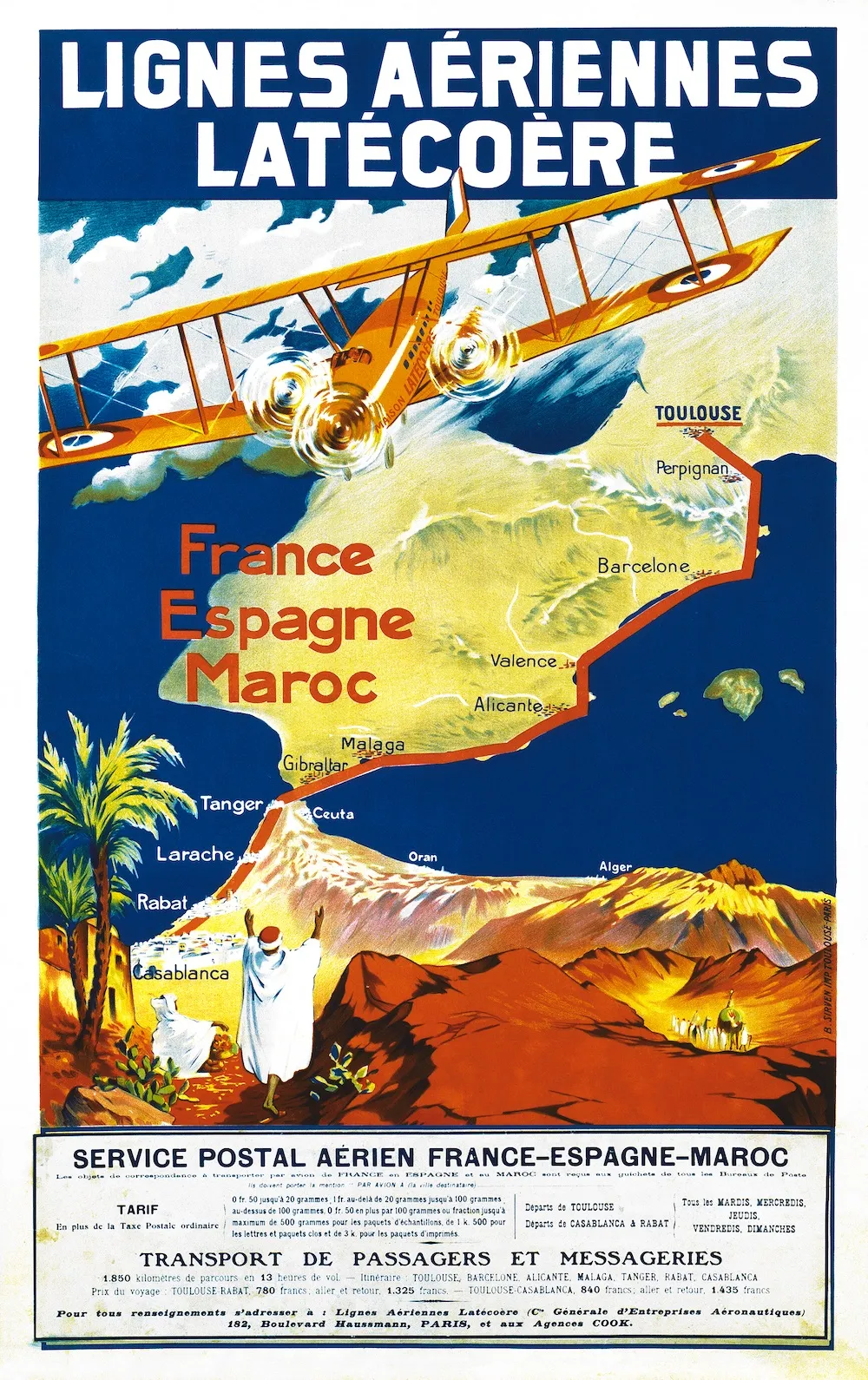
In the early days of commercial aviation, how did airlines use maps and other literature to entice passengers to travel via air?
Roberts: Airlines adopted whatever the graphic design fashion was at the time. For example, the very first flight maps after World War I were designed in the Art Nouveau style. There were also a lot of pictures of aircraft and the places that you could fly to and the people you would likely meet while there. So the maps had two purposes. One, to show you that you can get to places faster than ever before no matter how inconvenient, and the other was to reassure people with friendly, everyday images.
Ovenden: In the first couple of chapters of the book, I was amazed to see how few maps didn’t contain a [picture of] a miniature aircraft on them. If you transport yourself back to the 1920s and ’30s, aviation was still a new technology and the idea of flying was a new way of traveling for the masses, who before then only traveled via train, boat or by walking. So the idea of air flight, especially for ordinary people to take part in, was practically unheard of, which was the reason for the airlines to start putting aircraft imagery on their maps.
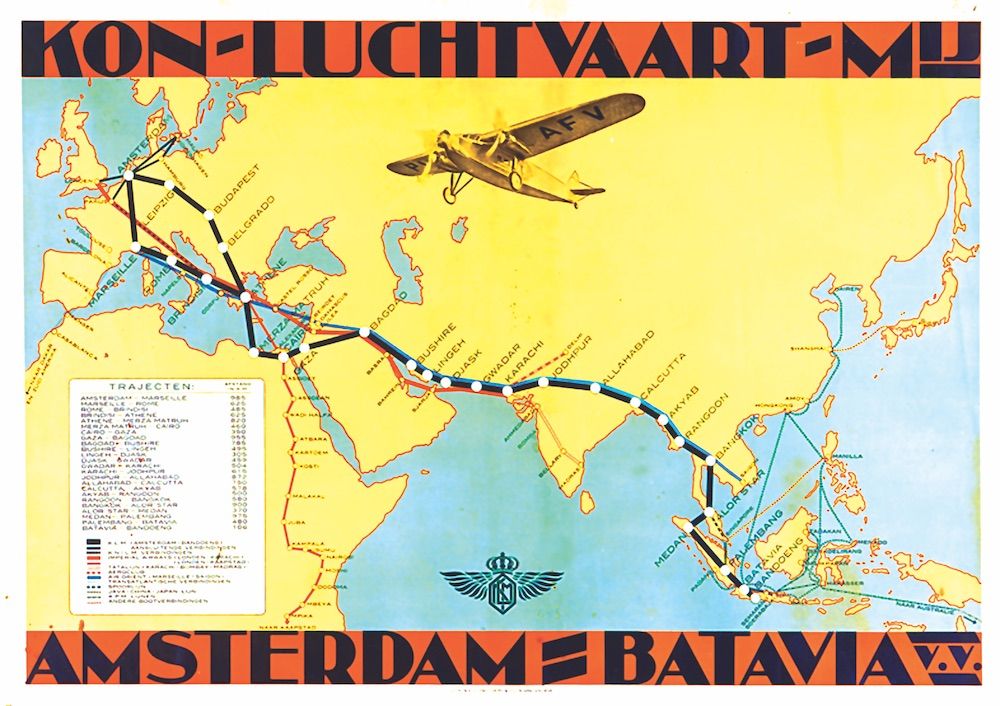
How have airline maps evolved over time?
Roberts: This book is not just about the history of maps, it’s also the history of design. Airlines followed whatever design trends were popular at the time, going from Art Nouveau to Art Deco to a more somber style in the 1940s and ’50s. Early on, they used a more sumptuous design to persuade rich people to fly, but after World War II, airlines were trying to encourage ordinary people to fly as it became cheaper for airlines to fly at longer ranges.
Ovenden: Maps started to change in the late 1930s and ’40s when more routes were becoming available and more people were able to fly, therefore making it no longer the domain of the rich. For example, Harry Beck, [who famously designed the London Underground map , also created a route map for Imperial Airways in 1935]. Beck showed the way that you could use diagrams and make them useful for people traveling by air.
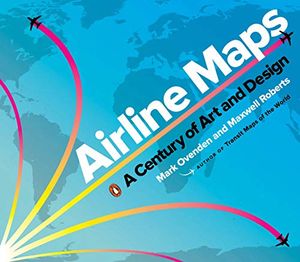
Airline Maps: A Century of Art and Design
A nostalgic and celebratory look back at one hundred years of passenger flight, featuring full-color reproductions of route maps and posters from the world's most iconic airlines, from the author of bestselling cult classic Transit Maps of the World .
You scoured museums, archives, websites and more in search of old route maps. What were some of the most surprising things you unearthed?
Roberts: We like the way in which the world gets twisted up. For example, in the 1940s there was sort of an avant-garde thing taking place [in route map design] that shred up the world [from being shaped like a sphere] and making it look like [the petals of] a flower [or other shapes]. Graphic designers were trying new things and distorting [what the world looked like]. A lot of the maps make us laugh and the designs are absolutely hilarious. For example, Svitlet [a Czechoslovakian airline founded in 1948], showed its routes [on the sole] of a flying boot standing down an aircraft.
Ovenden: Another example of [distorting the world] was a map by Scandinavian Airlines [SAS] from the 1950s that shows the Earth being twisted into a spiral. SAS was known for being very innovative with its designs. What definitely came out from our research is seeing that airlines like SAS, KLM, Air France and Air India really put a lot of money and thought into their designs, but then there were also other airlines that perhaps didn’t think things through and weren’t quite as clever.
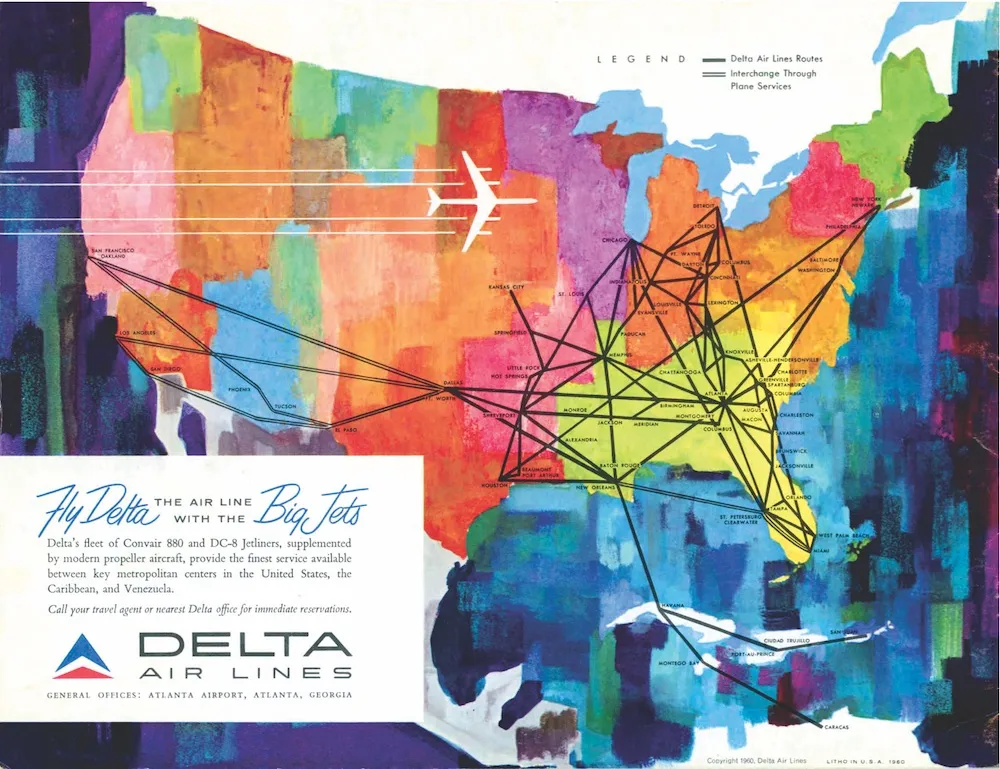
In the book's introduction, you wrote that “this book, in its own way, tells the story of 20th century design.” Could you elaborate on this idea?
Roberts: At one time, route maps were all hand drawn and painted. The depictions of airplanes and people were absolutely gorgeous, but sadly those began to fade away in the 1960s and ’70s when artistry started to be left behind. As air travel became more mundane, so did the design of the route maps. As we researched, we could see the design fade away. The last chapter was hard to fill.
With the advancements in technology, do you think airline route maps will eventually become a thing of the past?
Roberts: There are two types of maps. The first is the route map that tells you where your aircraft is traveling; technology has replaced those because you can view a flight path in real time on the seatback screens of an airplane showing you exactly where your aircraft is. Airline service maps, which are more of what this book is about, are there for publicity and for defining a territory and for planning a journey. Technology won’t take away the need to advertise. It’s not so much technology taking away from the maps, I think it’s a loss of excitement of air travel, which is taking away people’s desire to show things in these grand fantastic ways.
Ovenden: I agree, and just occasionally in modern times, you have people who are prepared to make maps using new ideas. We’d love to see more designers do that. During the book launch, we almost set down a challenge now to the airlines around the world that they’ve seen the best of what there is, and that we challenge them to design even better airline route maps.

Get the latest Travel & Culture stories in your inbox.
A Note to our Readers Smithsonian magazine participates in affiliate link advertising programs. If you purchase an item through these links, we receive a commission.
Jennifer Nalewicki | | READ MORE
Jennifer Nalewicki is a Brooklyn-based journalist. Her articles have been published in The New York Times , Scientific American , Popular Mechanics , United Hemispheres and more. You can find more of her work at her website .
Learn about Life in the 1920s
1920s Aviation
The Dawn of Air Travel and Air Freight
- 1920-30.com Home Page
- Architecture
- Army, Navy, Airforce
- Automobiles
- Business/Economy
- Interior Decorating
- Law and Order
- Prohibition
T he First World War (1914-18) hastened the development of aeroplanes which were then in their infancy, so that by the early 1920's they were much more reliable and capable of flying longer distances and carrying heavier loads. This made possible the carrying of passengers and freight on a commercial basis.
New Planes, Dirigibles and Flight Records
The ability to travel long distances quickly but with relatively light loads meant that the earliest commercial freight services were mainly mail deliveries. To speed up mail deliveries the Post Office Department at one time considered putting flat roofs on Post Offices to act as landing strips.
Airplanes were initially built predominantly of lightweight materials like wood and canvas but continual developments in the aviation industry over the first decade of powered flight led to increasing use of metal parts and panels until complete all-metal airplanes became the norm. 4600 American airplanes were built in 1928 and 104 different planes were exhibited at an airshow, leading Henry Ford to predict that there would have to be consolidation within the industry.
Before the world war, planes were rare, and you were lucky if you had even seen one. In 1920 the English air force auctioned off 10,000 surplus airplanes and 30,000 aircraft engines, many of which had seen service in the world war. All of a sudden there were planes everywhere with aircraft manufacturers releasing new, bigger and better models every year.
Pilots who returned from the WW1 supported themselves by travelling all over the country visiting small towns and showing off their flying skills, as well as taking paying passengers for rides. A paddock or fair ground with sufficient distance to take off and land was sufficient for these early barn-stormers as they were referred to. Entrepreneurs would rent a landing strip, hire a pilot, get permits and then charge passengers $1 per minute of flying time.
It was only in 1927 that an airport terminal in the form of a waiting-room and ticket-office for airplane passengers, said to be the firstin the USA, was erected at the Ford Airport, at Dearborn, Michigan. By 1929 a few principal airports had passenger terminals with comfortable waiting-rooms, but most of the existing airports were nothing more than open fields.
The increased capabilities of 1920's planes also created the opportunity for daring men and women aviators to break and set aviation speed and distance records. They captured the imagination of the public who loved the flying machines and who followed their exploits, treating the pilots like royalty or movie stars. Crowds would be waiting to greet pilots after epic flights and huge street parades would be held in their honor where whole towns and cities turned out.
The use of airplanes facilitated aerial exploration and surveying of inhospitable areas like the Antarctic that were difficult to explore by traditional ground-based methods.In 1929 Commander Byrd was able to discover many previously unknown features of Antartica with his flights generating numerous aerial photographs for later analysis and mapping.
The first transatlantic flight had been done in stages by the crew of the NC-4 in May 1919, with the first non-stop flight made by Alcock and Brown in June 1919. Charles Lindbergh gained international fame as the first pilot to fly solo and non-stop across the Atlantic Ocean, flying from New York to Paris on May 20-May 21, 1927 in his single-engine airplane The Spirit of St. Louis, taking 33.5 hours for the trip. One of the early barn-stormers, Amelia Earhart , was the first female pilot to achieve many records such as crossing of the Atlantic and the English channel.
Airships (dirigibles) were commonly used in aviation at the same time as fixed wing aircraft and had much greater load carrying capacities than aircraft of the time. The first crossings of the Atlantic were made by airship in July 1919 by His Majesty's Airship R34 and crew when they flew from Scotland to New York and then back to England. By 1929, airship technology had advanced to the point that the first round-the-world flight was completed by the Graf Zeppelin in September and in October. Zeppelin airships were also used for the first commercial transatlantic service. Although there had been previous dirigible crashes , the age of the dirigible ended in 1937 with the terrible fire aboard the Zeppelin Hindenburg. People stopped using airships, despite the fact that most people on board survived.
Charles A. Lindbergh carved a place in Aviation history when he flew a tiny plane, "The Spirit of St Louis", from Long Island to Paris in 1927, to create the first non-stop solo transatlantic flight. Suddenly the world had become smaller. Lindbergh became an aviation consultant and campaigned for a World Air Code to overcome the difficulties of different regulations in each country, in order to facilitate international air-travel.

- ALL OVER THE MAP
Vintage Maps Rekindle the Romance of Early Air Travel
Before pat downs and checked baggage fees, commercial flight carried an air of mystery and adventure.
In the early days of the 20th century, an exciting new mode of travel became possible. Anyone with enough money could take to the skies on a commercial flight. Trips that would take weeks by sea could be made in days by plane. A Londoner could hop over to Paris for the weekend.
As commercial flying grew, maps became a vital advertising tool, tantalizing the public with exotic destinations newly within reach.
Now a new book , Mapping the Airways, conjures the romance of those early days with a collection of maps from the British Airways Heritage Collection, the airline’s archive of records and artifacts.
“Aviation was a revolutionary way to travel,” says author Paul Jarvis, the collection’s curator. “There was an air of mystery and adventure about it.”

Early airline ads, like this one from around 1937, emphasized luxury and comfort and drew parallels to the more familiar passenger compartments of ships.
After World War I ended in 1918, lots of pilots suddenly found themselves with extra time on their hands, Jarvis says. Some of them decided to make themselves available for hire, and a number of small private airlines sprang up, using former military aircraft as their fleet. In 1924, the British government bought the best four of these small private aviation companies and merged them to create Imperial Airways, the first of several precursors to today’s British Airways.
At first, not everyone could book a ticket. “Flying was only for the wealthy, or for government servants, the military, and businessmen,” Jarvis says. The class of people who flew were used to luxury railcars, and they expected similar amenities when they flew. Plane interiors might use mahogany veneers to mimic the solid mahogany furnishings of a Pullman railcar, for example.
People dressed for the occasion too. “Men would wear a suit, collared shirt, and tie,” Jarvis says.
Longer journeys became possible in the 1920s and 30s. The travel times seem ridiculously slow today, but they would have been mind-blowingly fast at the time. One 1935 Imperial Airways timetable lists nine stops between Brussels and the Congo, with some legs traveled by train. The entire trip is advertised as taking four and a half days, but Jarvis thinks it must have taken at least five. “The airfare would include all hotels, all transfers, all food,” he says.

This 1938 poster by artist James Gardner incorporates a stylized route map, likely inspired by Harry Beck’s famous 1933 map of the London Underground .
Traveling by air was more perilous back then. One map in the book (included in the gallery of images above) depicts hills and other landmarks a pilot could use to identify his position if the plane went down in the desert between Cairo and Baghdad. The map also notes the poor condition of some roads. “Very bad going over boulders,” it says in one place, an indication that help would be slow to arrive. (See “ How to Read a Pilot’s Map of the Sky ”)
During World War II commercial flights were grounded across Europe. In Britain, the airlines were taken over by the military during the war. One use for the commercial aircraft was flying American and Canadian pilots back home after they’d flown military planes over from North America to aid the Allies in Europe, Jarvis says. (See “ Bomb-Damage Maps Reveal London’s World War II Devastation ”)
The Cold War, too, had an impact. Through the 1970s, the Soviets tightly controlled air traffic in and out of Berlin’s three airports. A map from this era (also in the gallery above) uses narrow strips to illustrate the permitted flight paths. Everything else is blocked out.
The bulk of the maps Jarvis has selected for Mapping the Airways come from the first half of the 20th century, and they capture the aesthetics of their era. Many were made by prominent artists and designers, including László Moholy-Nagy , a leading figure in the Bauhaus art and design school in Germany in the 1920s and early 30s.
Jarvis includes a few modern airline maps in his book, the kind you’d find in the seatback pocket or on a screen that tracks your flight’s progress in real time. They’re just not as evocative as the older maps. Even if you’re too young to have lived it, it’s easy to feel nostalgic for the days before excruciating security lines and embarrassing pat downs, when people put on nice clothes and took five-day flights to the Congo.
Related Topics
- PEOPLE AND CULTURE
You May Also Like

What do long flights do to our bodies?

What is the jet stream—and how does it influence the weather?

Ground-level ozone is getting worse. Here's what it means for your health.

‘Society of the Snow’ is based on a true story. Here’s what really happened.
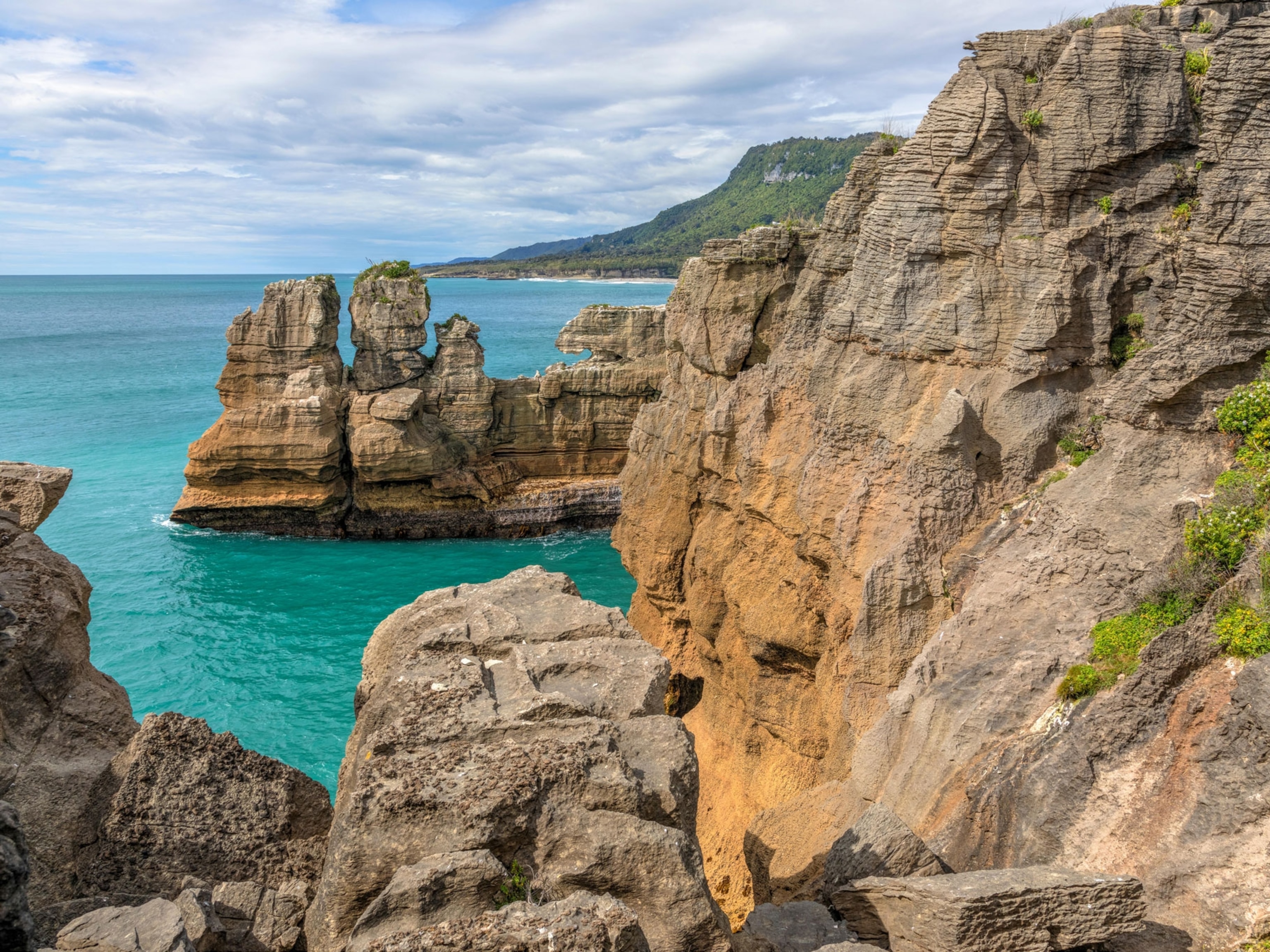
The lost continent of Zealandia has been mapped for the first time
- Environment
History & Culture
- History & Culture
- History Magazine
- Mind, Body, Wonder
- Coronavirus Coverage
- Paid Content
- Terms of Use
- Privacy Policy
- Your US State Privacy Rights
- Children's Online Privacy Policy
- Interest-Based Ads
- About Nielsen Measurement
- Do Not Sell or Share My Personal Information
- Nat Geo Home
- Attend a Live Event
- Book a Trip
- Inspire Your Kids
- Shop Nat Geo
- Visit the D.C. Museum
- Learn About Our Impact
- Support Our Mission
- Advertise With Us
- Customer Service
- Renew Subscription
- Manage Your Subscription
- Work at Nat Geo
- Sign Up for Our Newsletters
- Contribute to Protect the Planet
Copyright © 1996-2015 National Geographic Society Copyright © 2015-2024 National Geographic Partners, LLC. All rights reserved

Love Exploring
Vintage Air Travel Images Through The Years
Posted: March 13, 2024 | Last updated: March 13, 2024
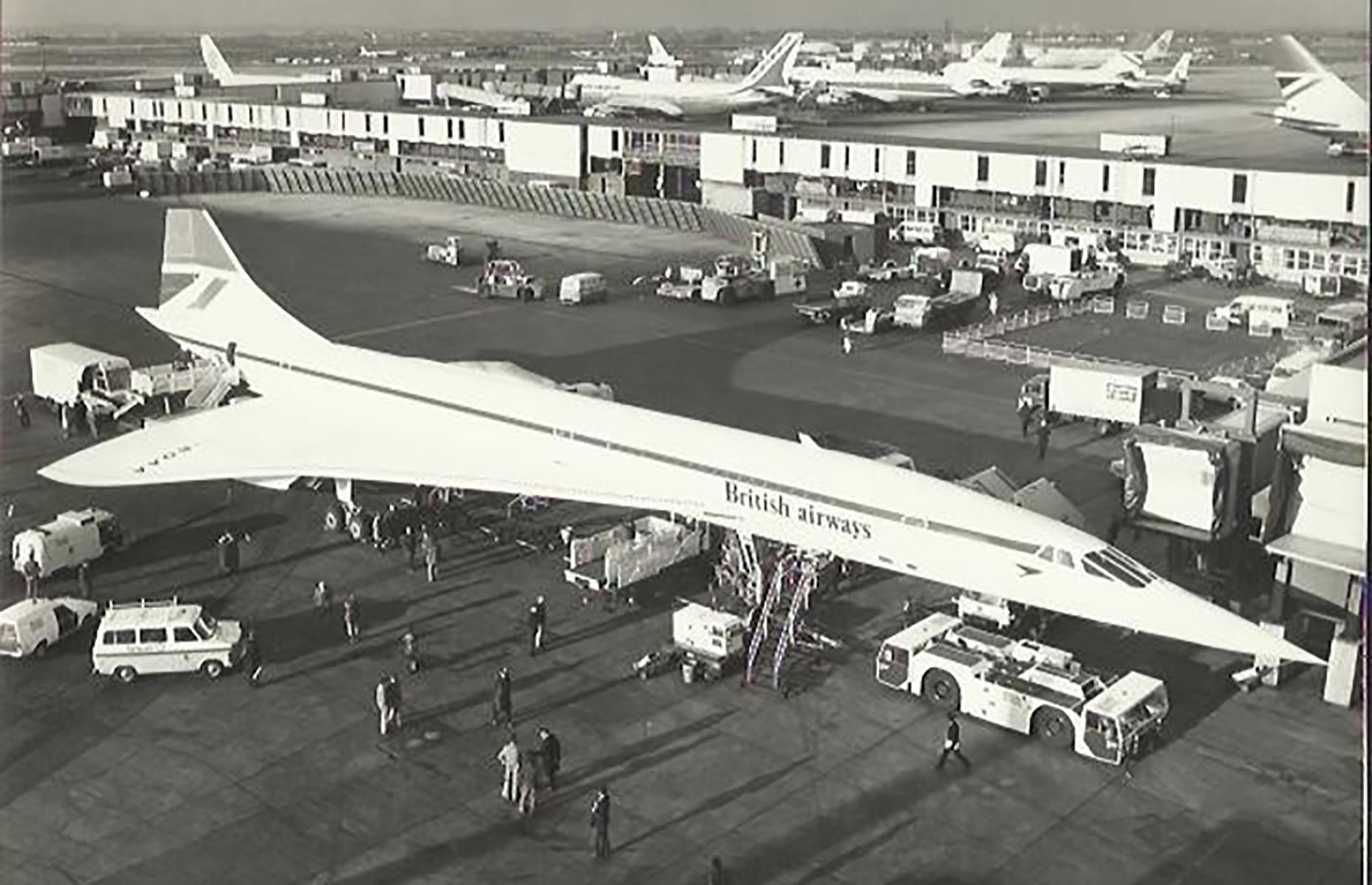
Air travel milestones through the decades
From the early days of flight and the "golden age of travel," to contemporary budget airlines and COVID restrictions and regulations, air travel has transformed dramatically over the past century.
Click or scroll through this gallery and join us as we take a journey through time to bring you the biggest milestones in commercial aviation history, including plans for air travel to become net zero by 2050 recently announced.
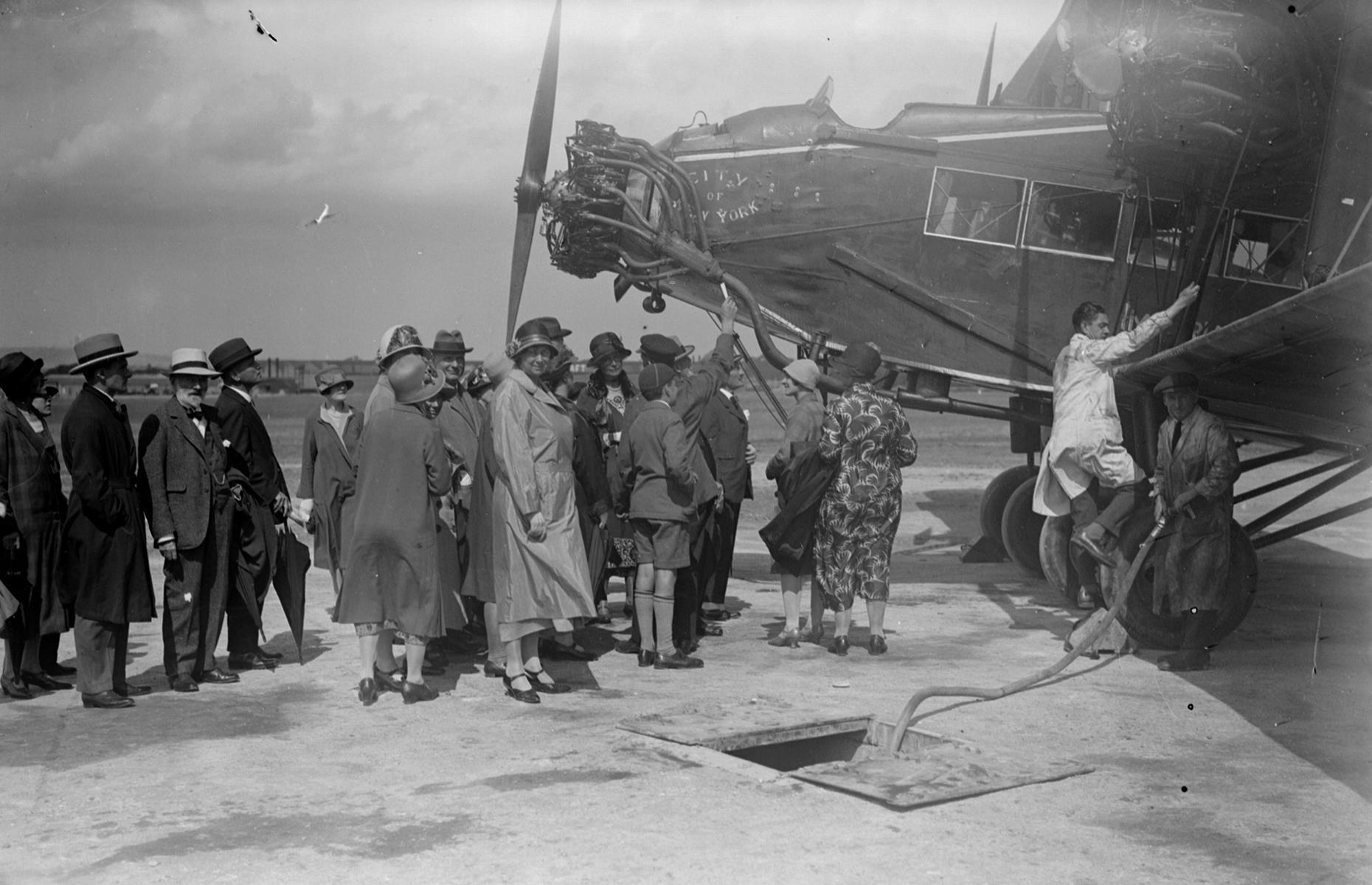
1920s: passengers wait to board a plane in 1929
The story of commercial air travel begins before the 1920s, in 1914, when the world's first scheduled passenger service set off between Tampa and St Petersburg, piloted by Tony Jannus. Though commercial aviation did not take off quickly, more and more companies tried to build on this milestone through the 1920s, with varying degrees of success. Here, passengers wait at Croydon Airport, UK to board a Handley Page W.9 aircraft, a model used by early airlines Imperial Airways and Sabena.
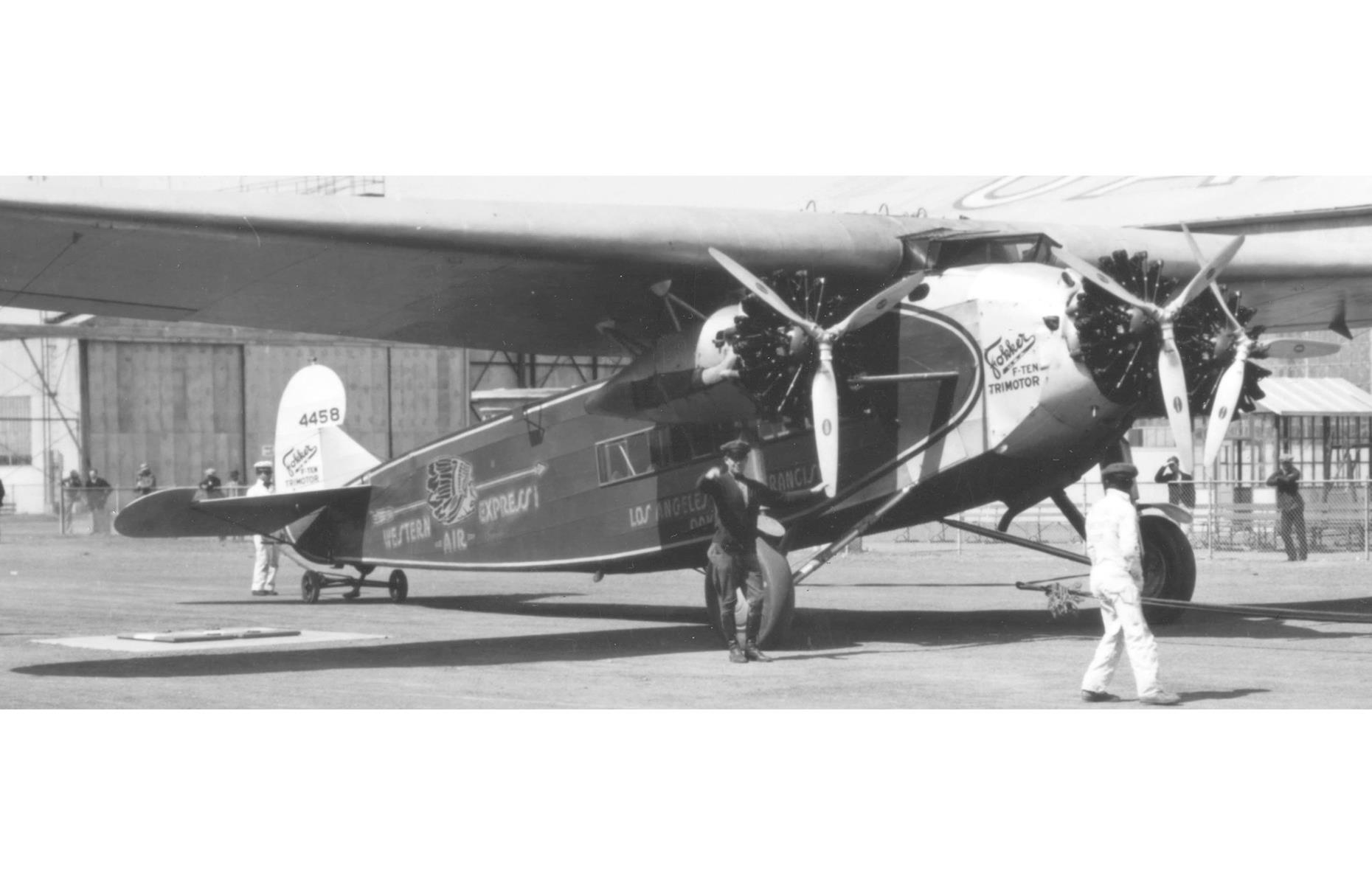
1920s: a Western Air Express airliner in 1928
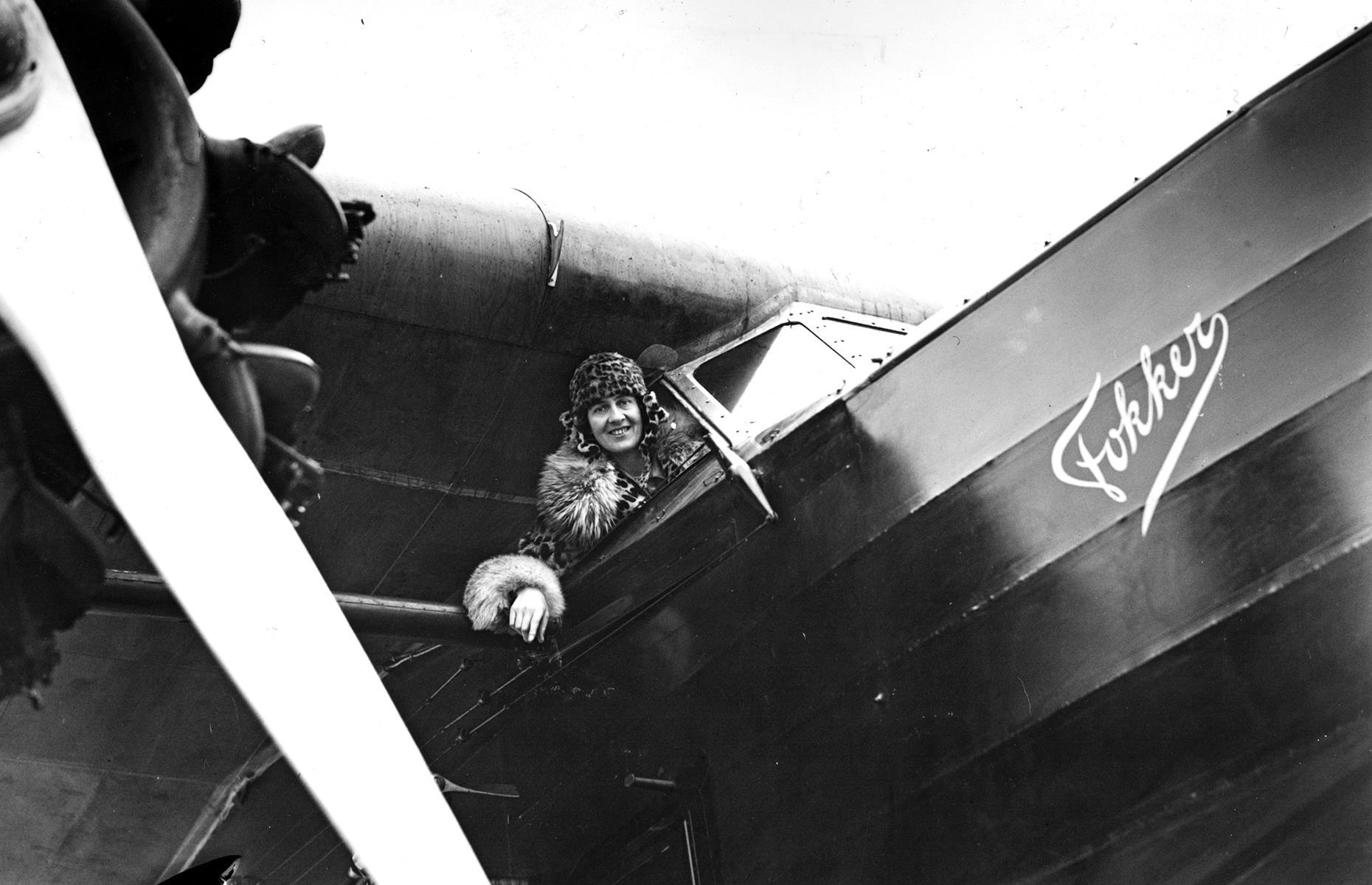

1920s: Lady Heath pilots a plane for KLM Royal Dutch Airlines
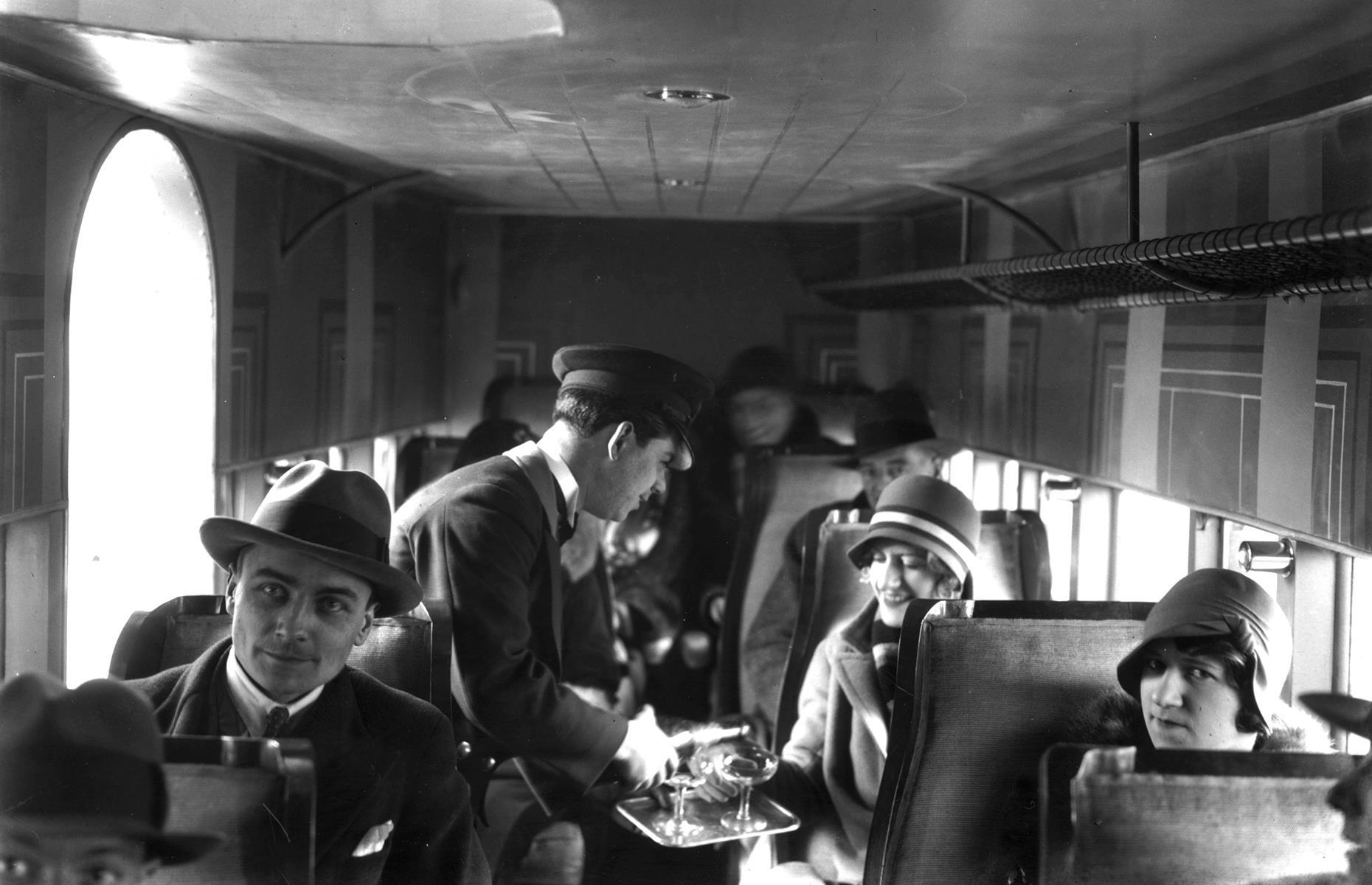
1920s: passengers are served drinks on a French Air Union plane in 1929
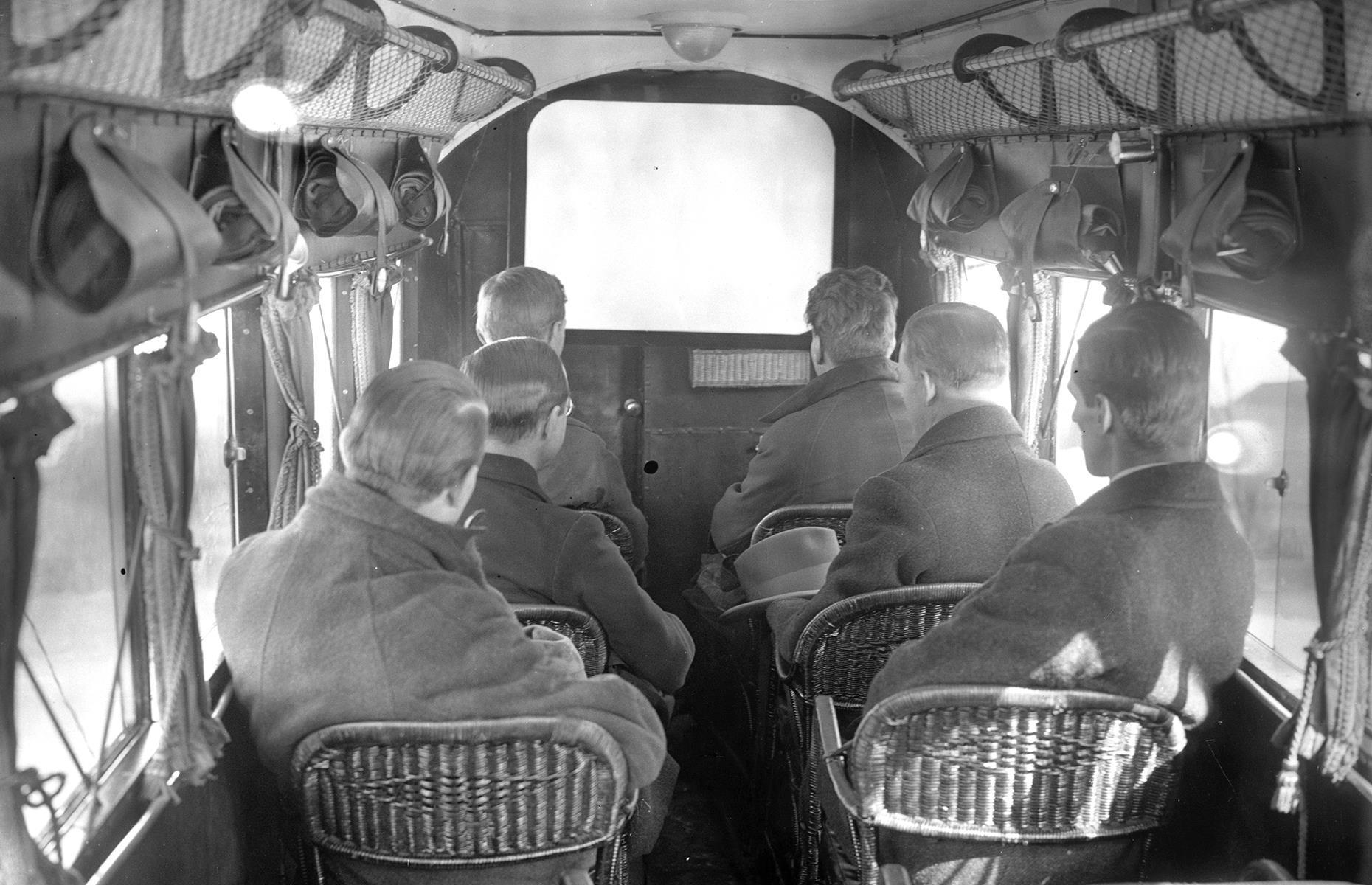
1920s: an early in-flight movie in 1925
In-flight entertainment systems looked rather different too. Today airplane entertainment is a solitary, hi-tech affair but, in the early days of flight, passengers would typically gather around a single screen if they wanted to catch a movie. One of the earliest films to be shown up high was Sir Arthur Conan Doyle's The Lost World in 1925 with Imperial Airways. Here, passengers on a German airliner also enjoy a movie in the year 1925.
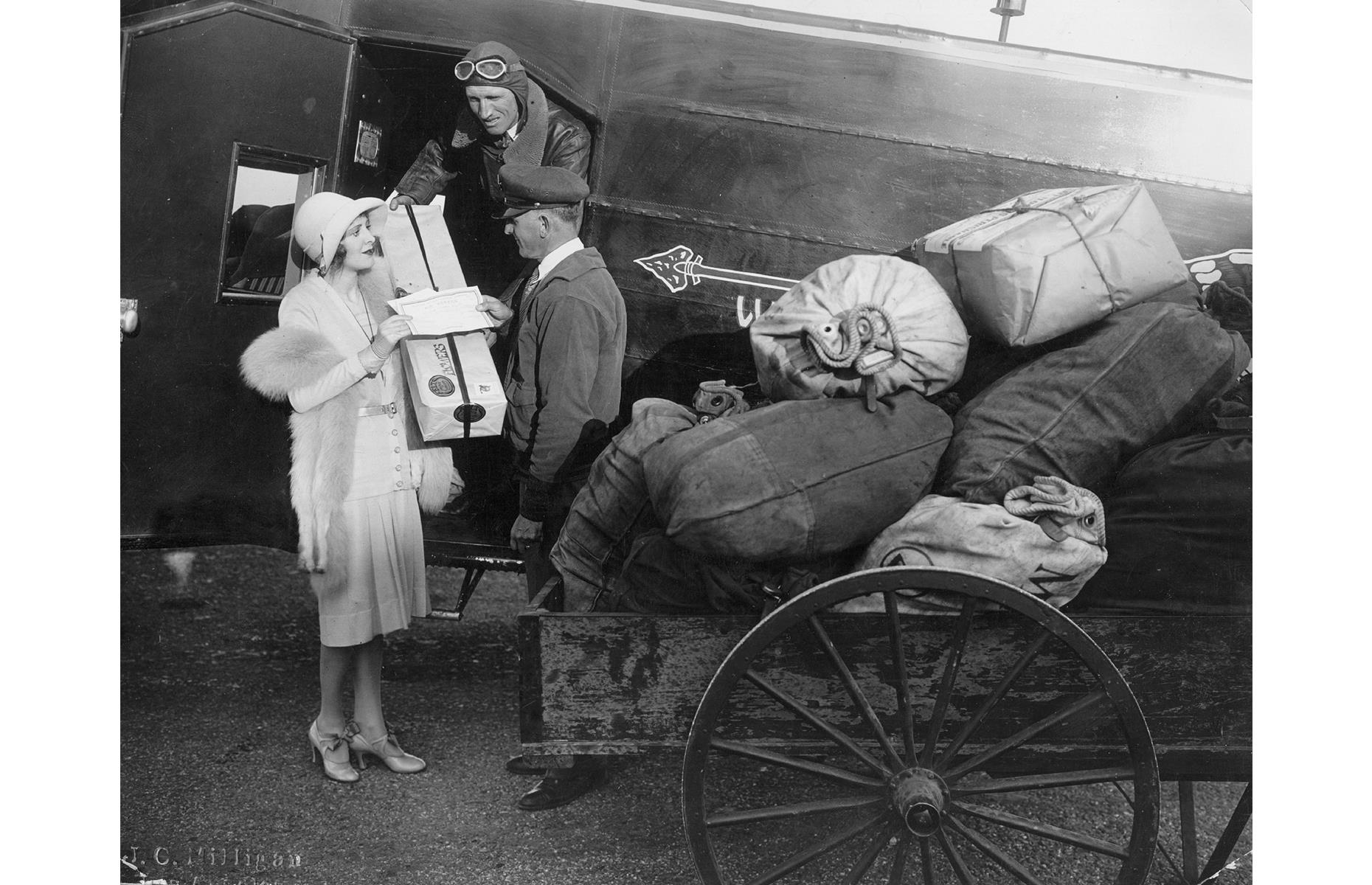
1930s: a woman hands over an airmail parcel to Western Air Express staff circa 1930
The early 1930s continued in a similar fashion to the 1920s, with airlines offering airmail delivery services and also carrying passengers. Flying was still extremely expensive and fairly uncomfortable but, according to the Smithsonian National Air and Space Museum , the number of airline passengers grew from 6,000 in 1930 to 450,000 in 1934. Here, a woman passes on her mail to the crew of a Fokker F-10 monoplane operated by Western Air Express.
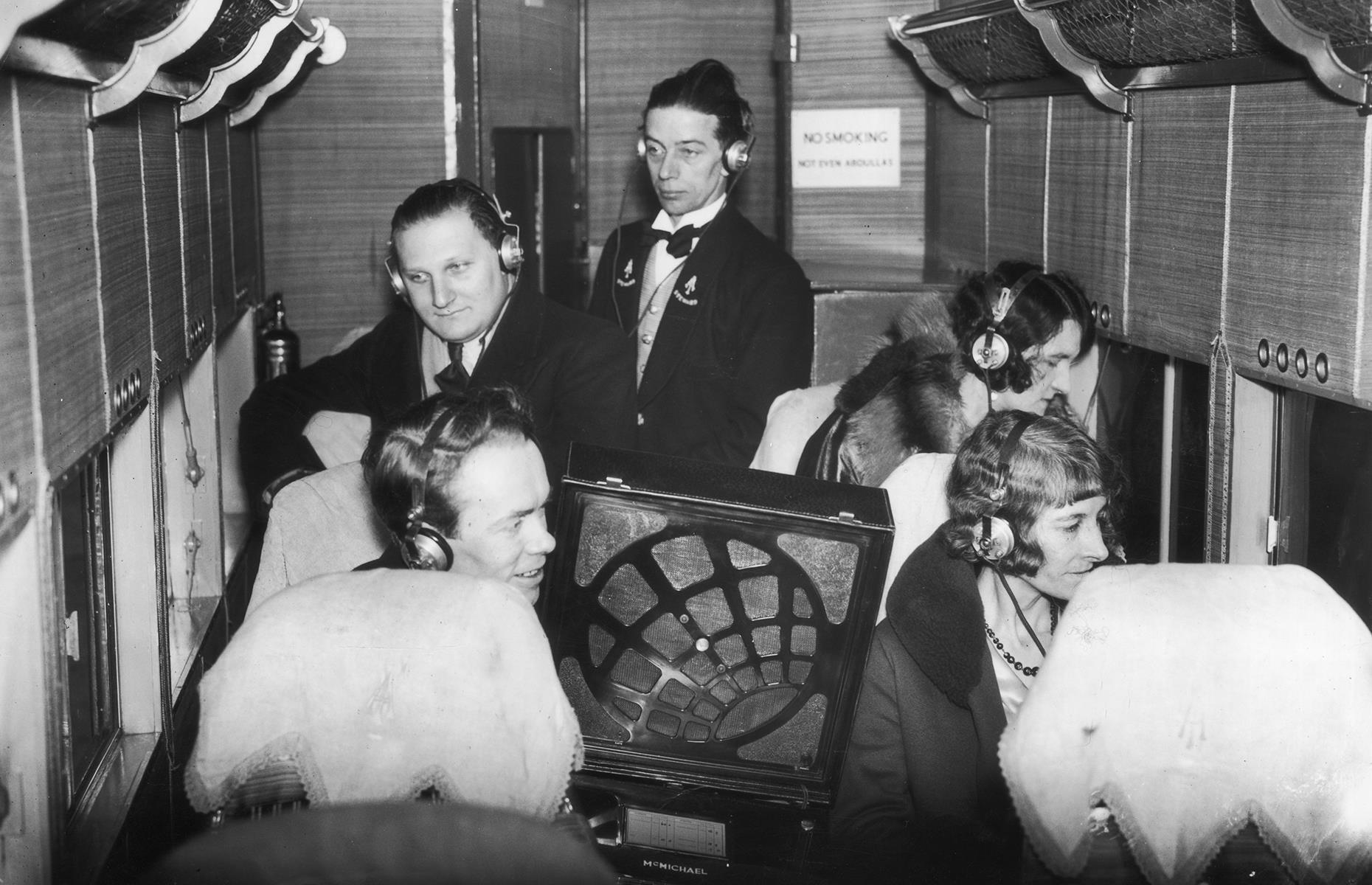
1930s: passengers listen to a broadcast aboard a flight in 1931
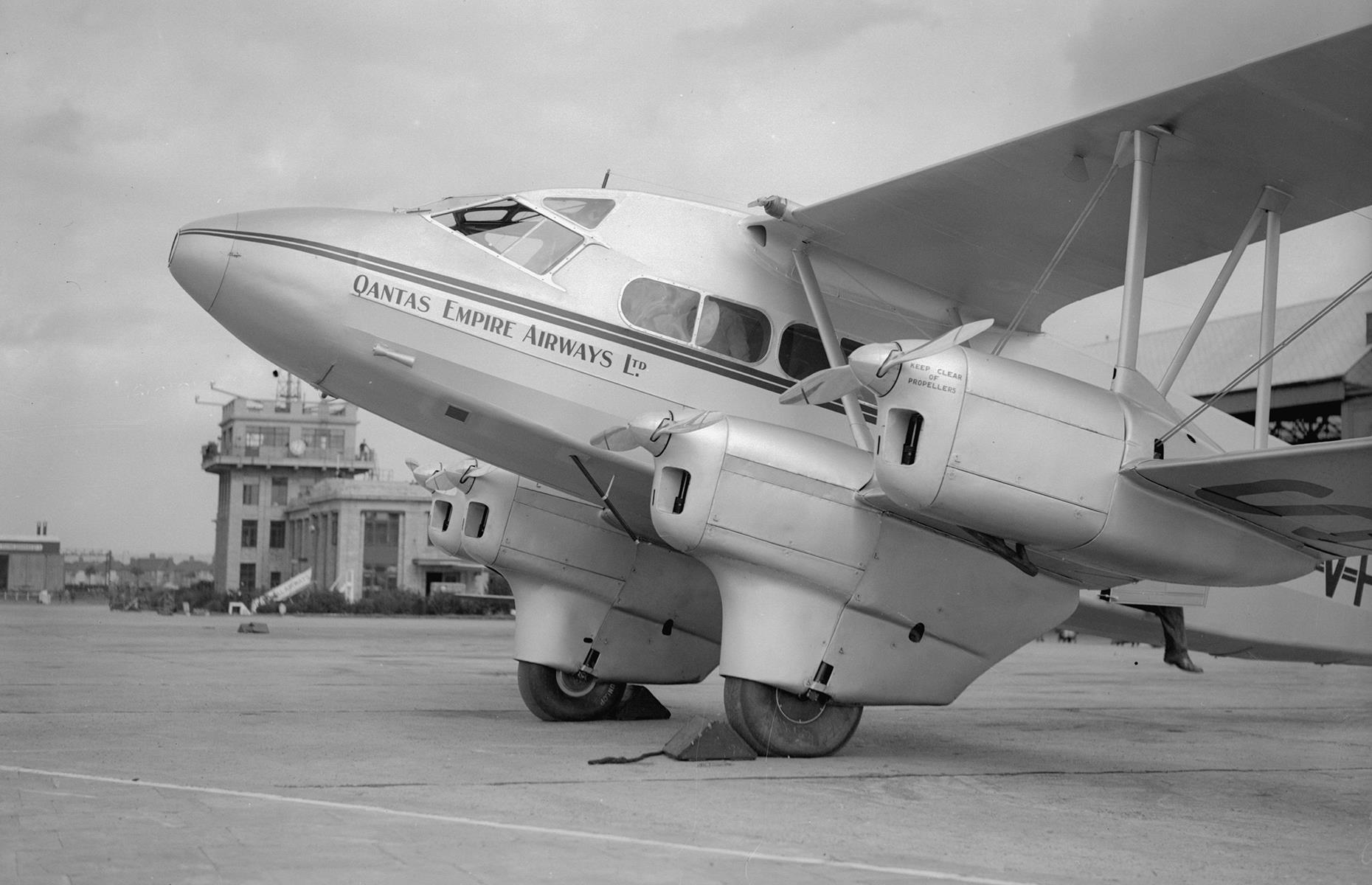
1930s: an early Anglo-Australian airliner in 1934
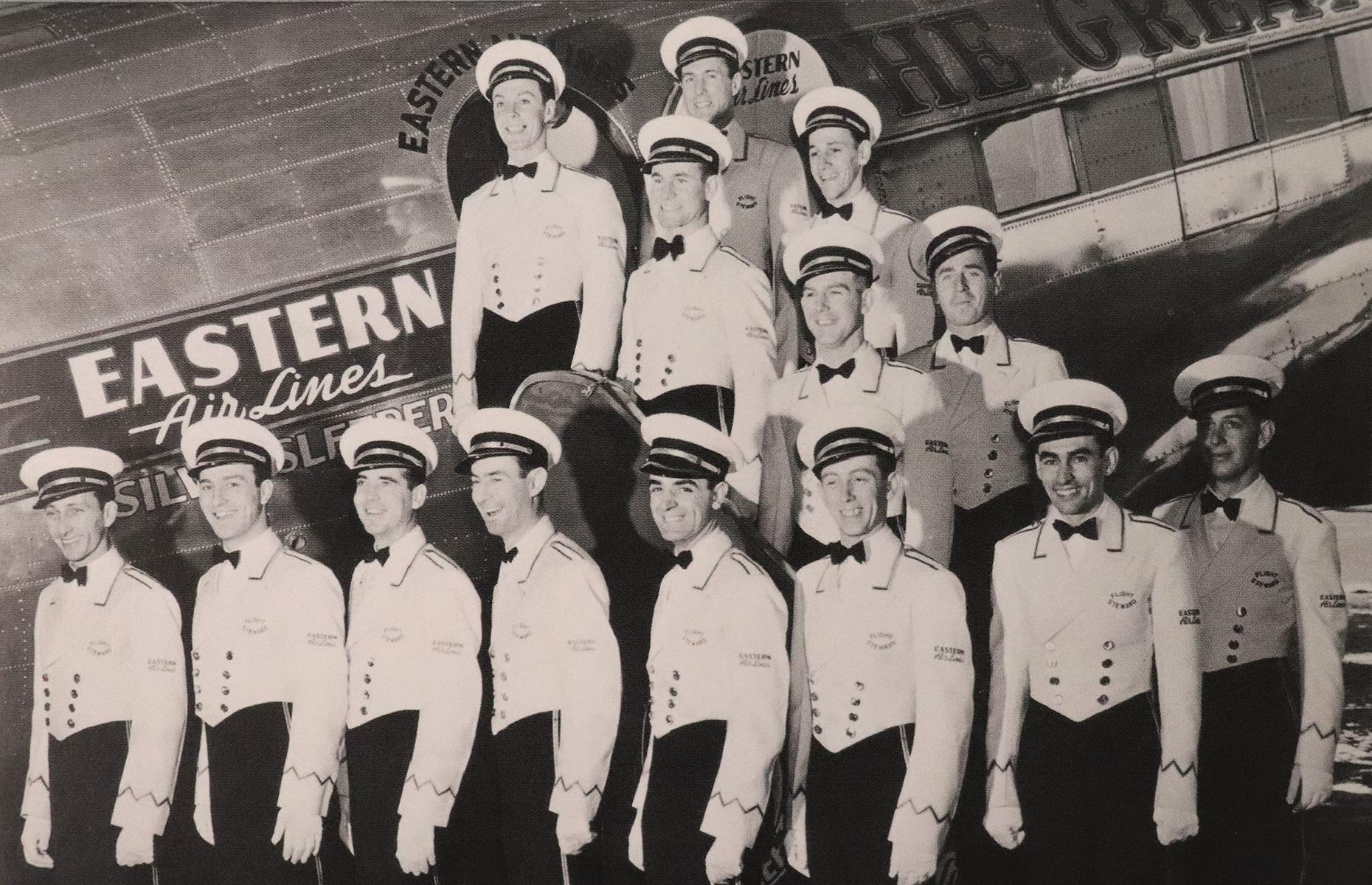
1930s: Eastern Air Lines stewards in the 1930s
In the 1920s and into the early 1930s, the role of flight attendant was one mostly reserved for men, who were usually referred to as "cabin boys." This was soon flipped on its head, though. The first female flight attendant, a nurse named Ellen Church, was employed in 1930 and by the middle of the decade most of these jobs went to women. The women were often trained nurses and there were also strict rules as to their age, height and weight. Before this change, this photo shows an all-male team of air stewards posing before an Eastern Air Lines plane in the early 1930s.
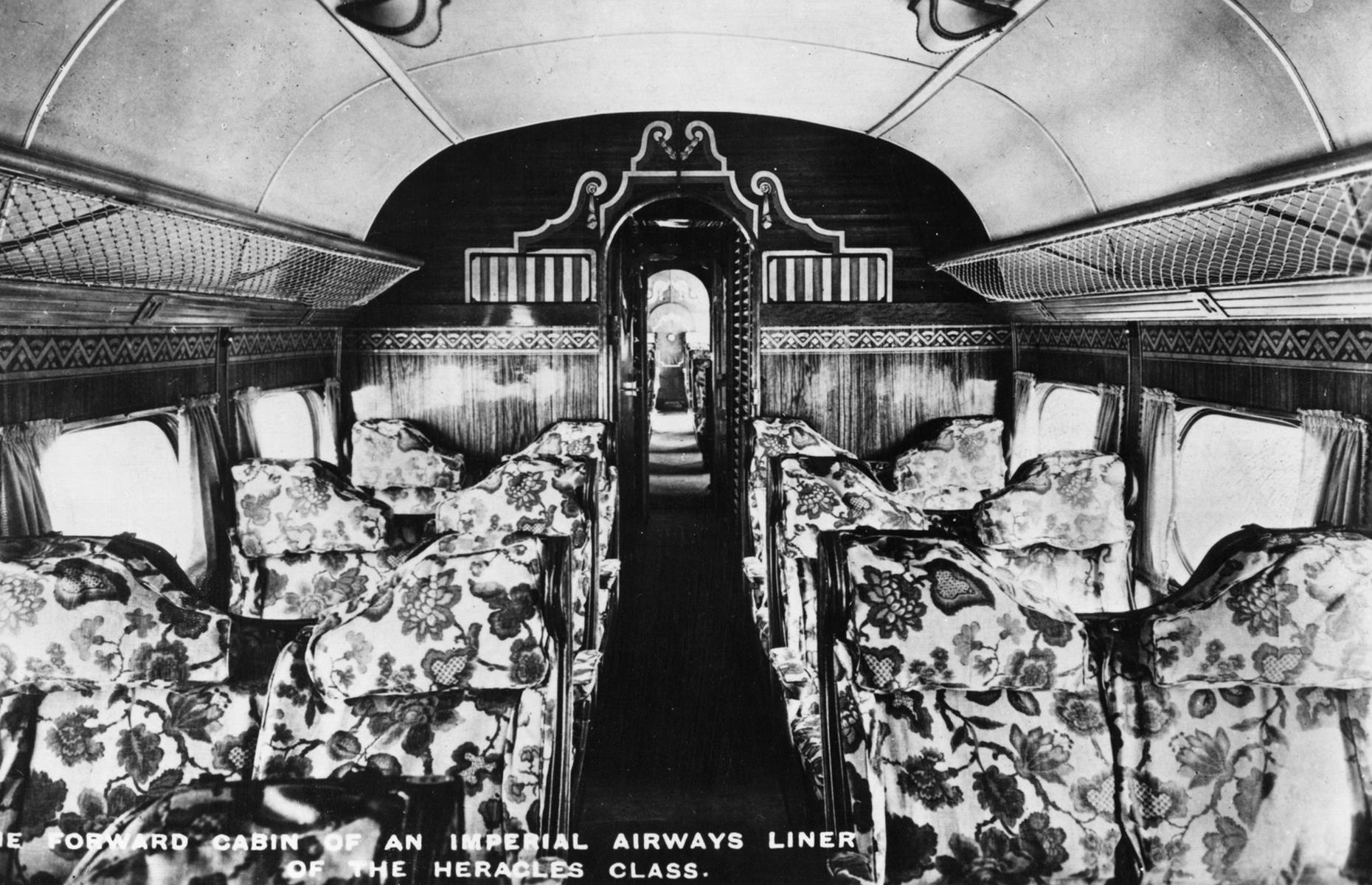
1930s: an Imperial Airways cabin in 1935
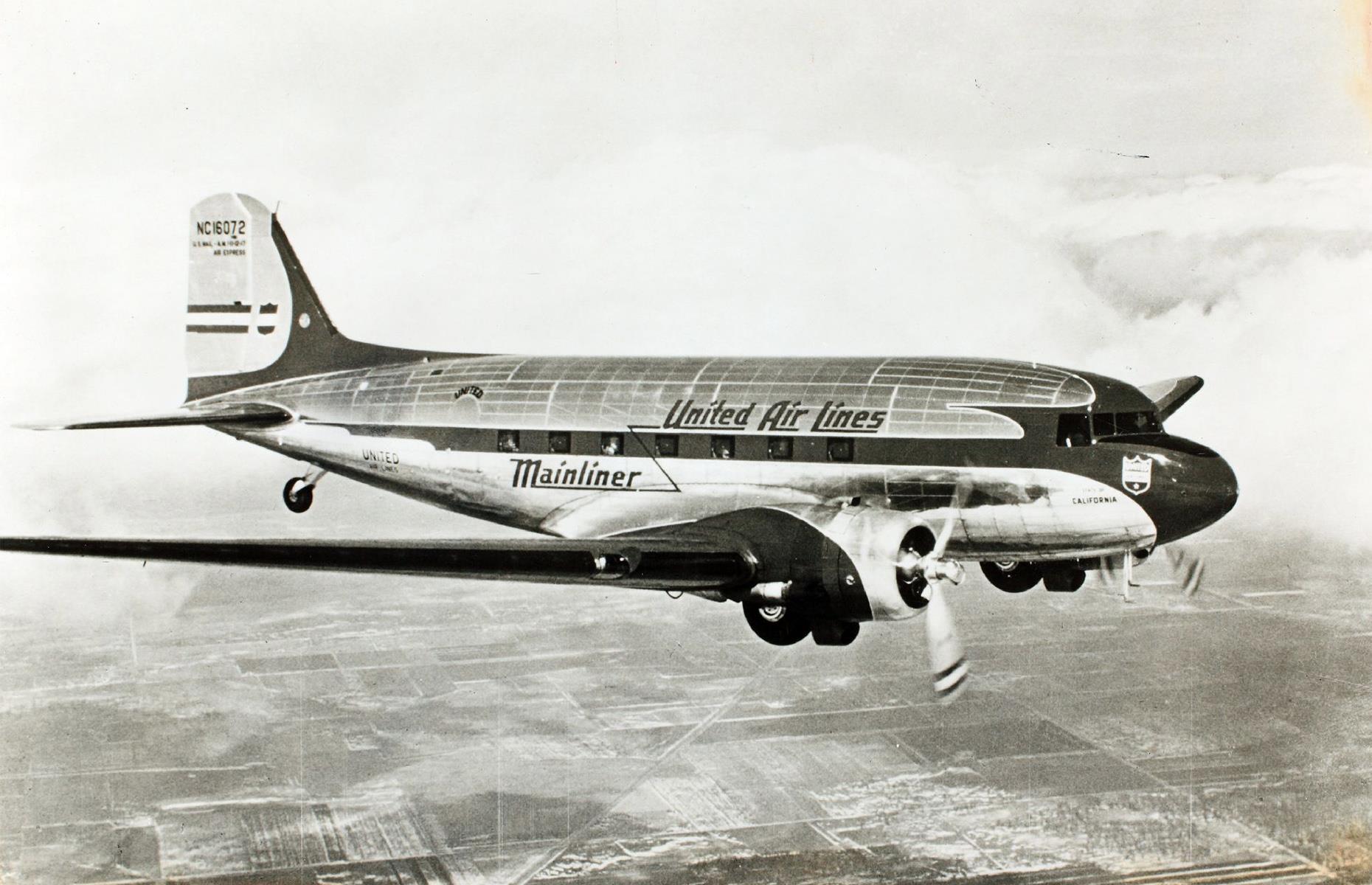
1930s: a Douglas DC-3 in flight
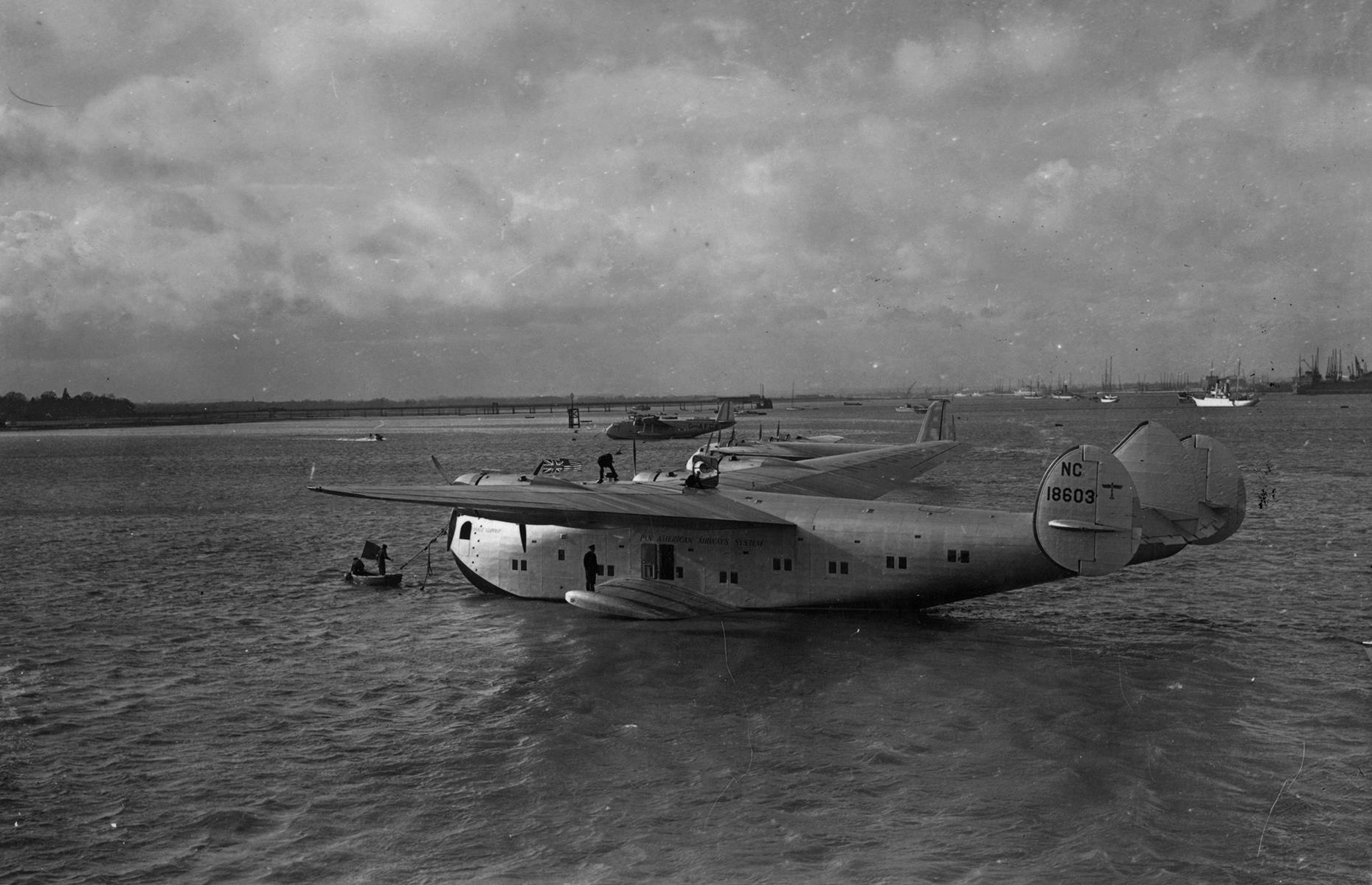
1930s: Pan American Airways flies across the Atlantic in 1939
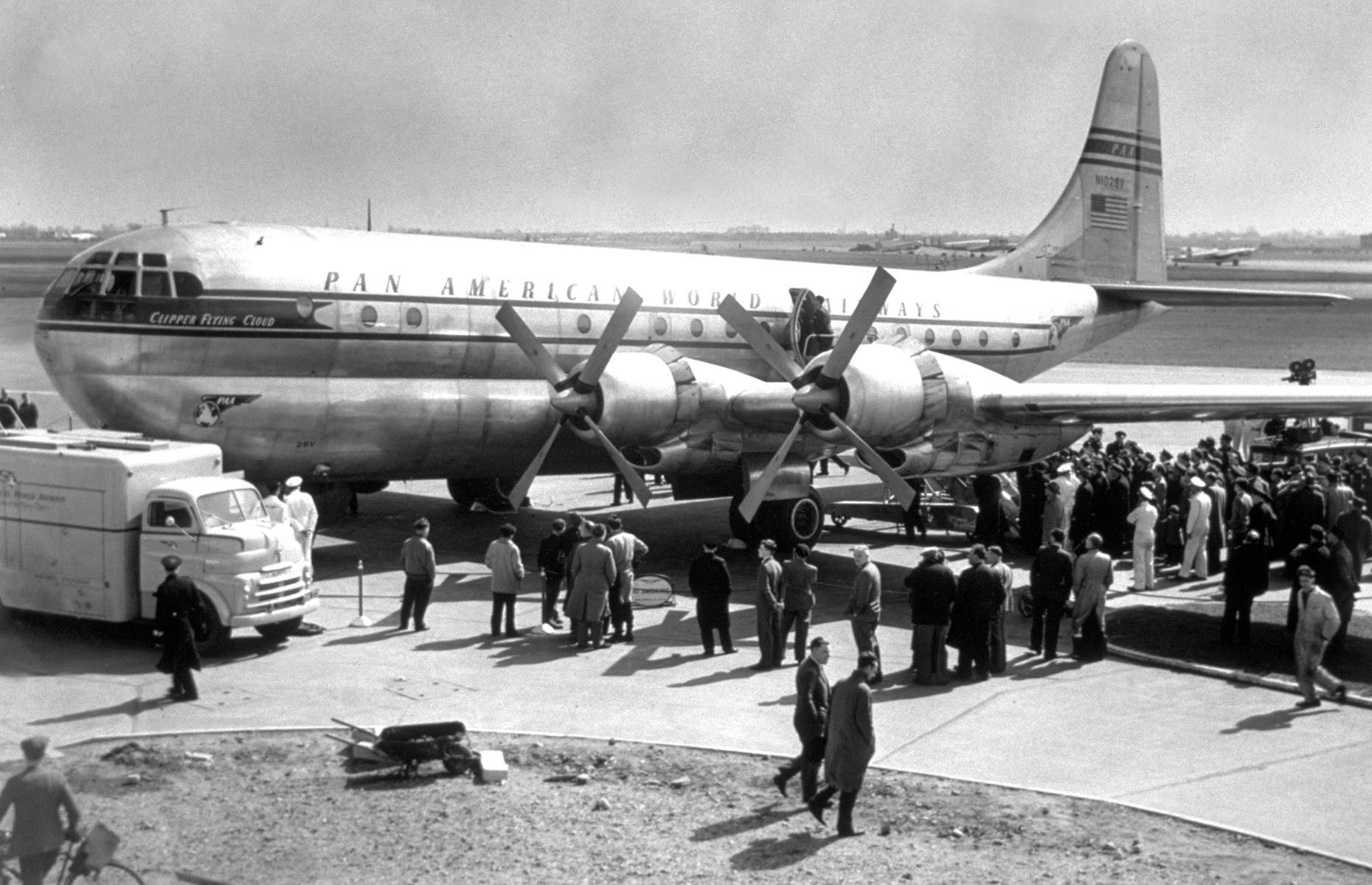
1940s: Pan American World Airways' 'Flying Cloud' clipper
The onset of the Second World War meant developments in commercial aviation were put on the back burner, and all resources were plunged into the war effort. However, by the end of the decade, the industry was recovering, especially since the war had given rise to new runways and military aircraft were able to be converted and put to commercial use. This 1949 shot shows Pan Am's 'Flying Cloud' clipper, the first of a group of planes to begin a service between New York and London in the 1940s.
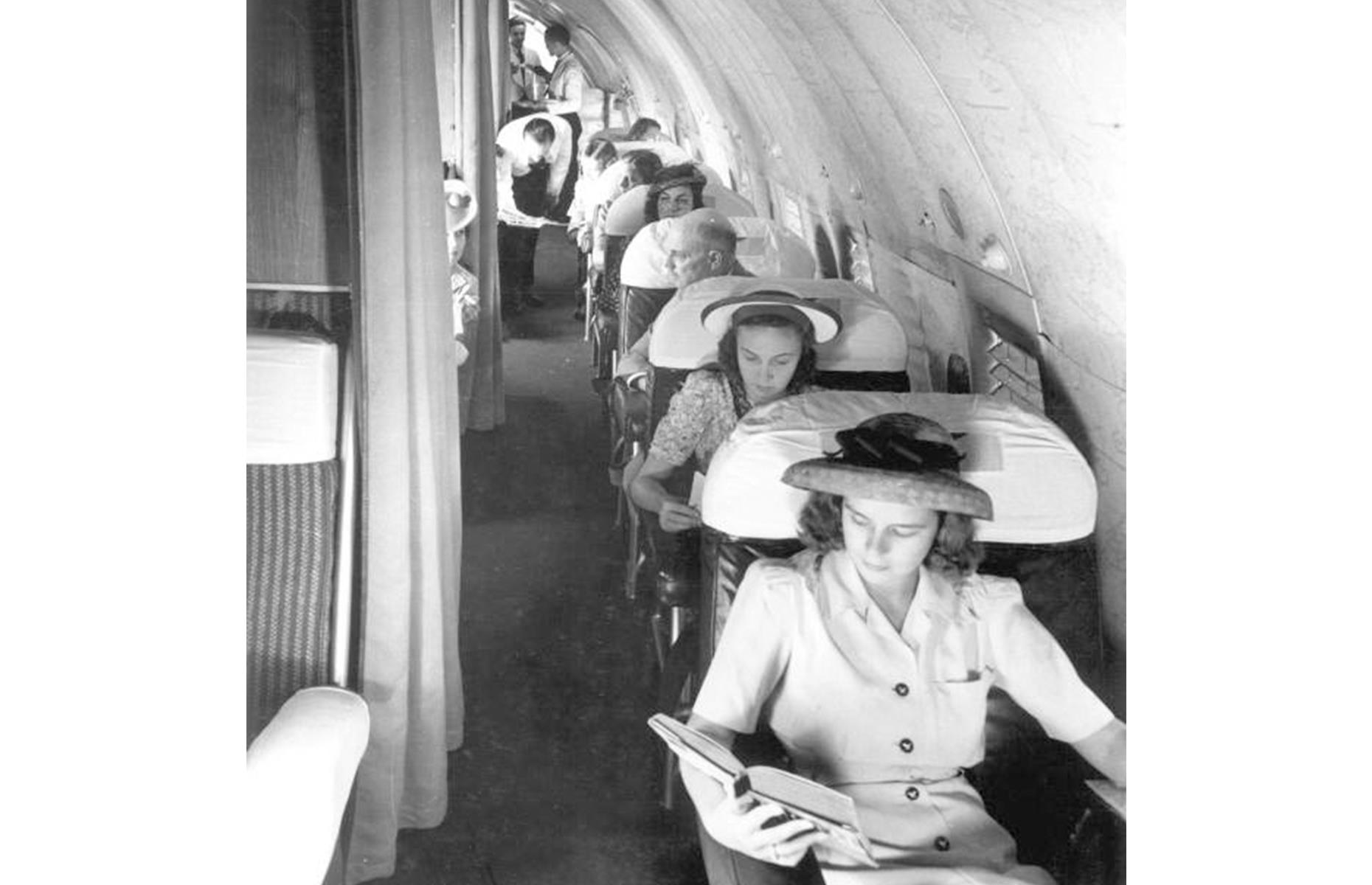
1940s: passengers aboard a Pan Am Boeing 307 aircraft circa 1945
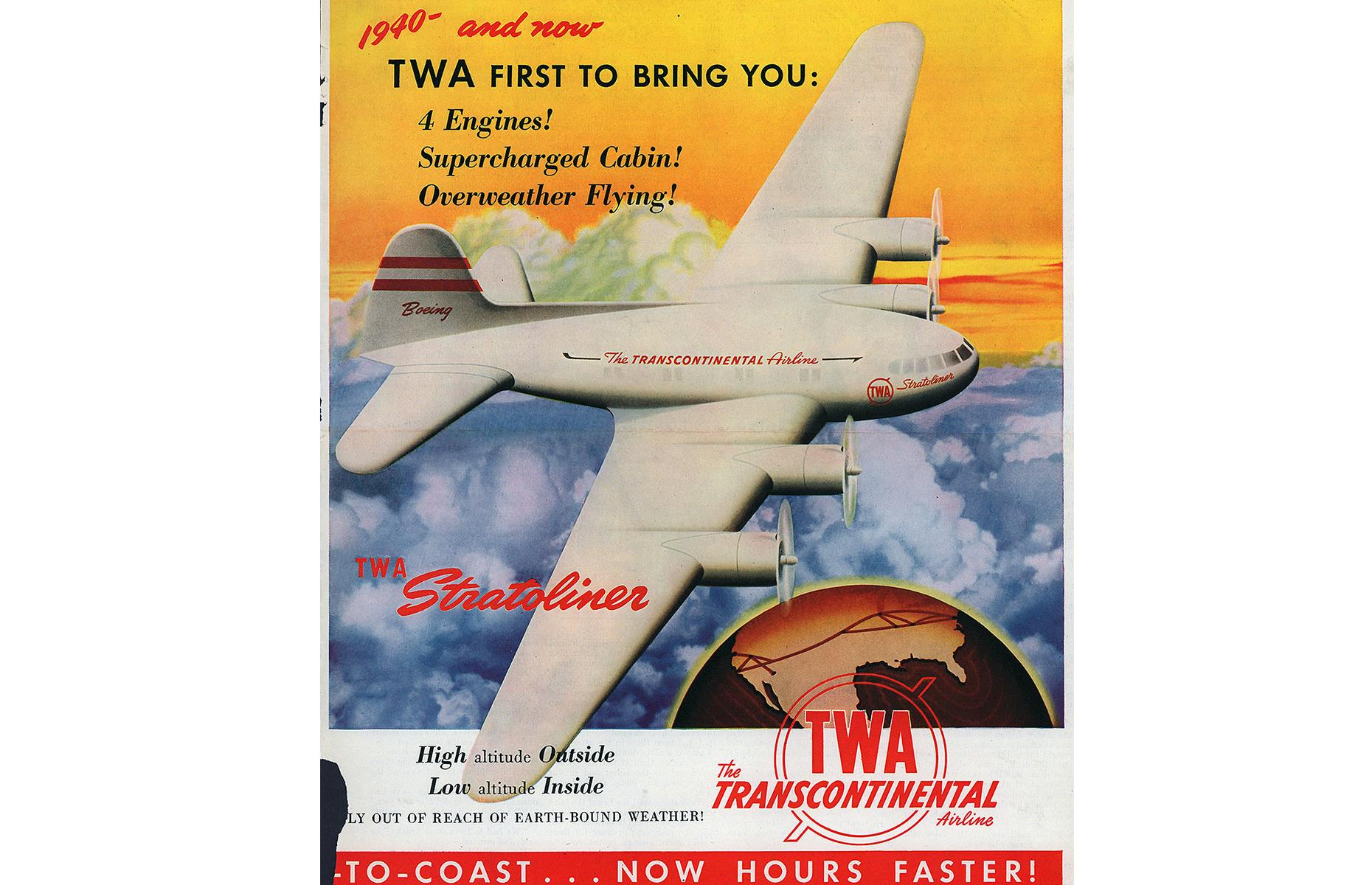
1940s: poster advertising TWA
As competition increased towards the end of this decade, the major airlines ramped up their advertising. This TWA poster advertises the Boeing 307 Stratoliner, and promises a smooth ride as the aircraft glides above the clouds. The 1940s was ultimately the decade that preceded the so-called "golden age of travel."
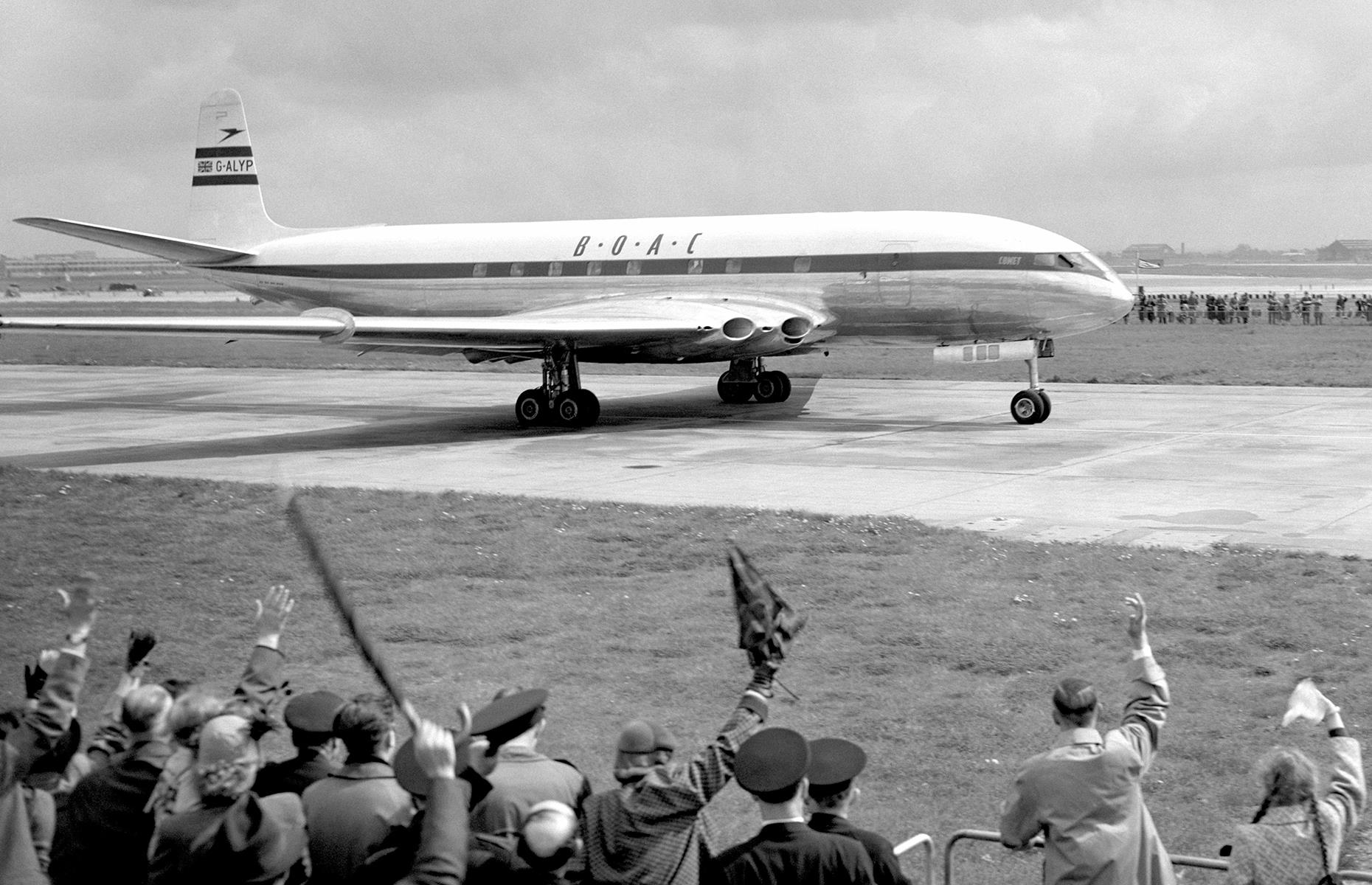
1950s: crowds wave off the world's first jet airliner service
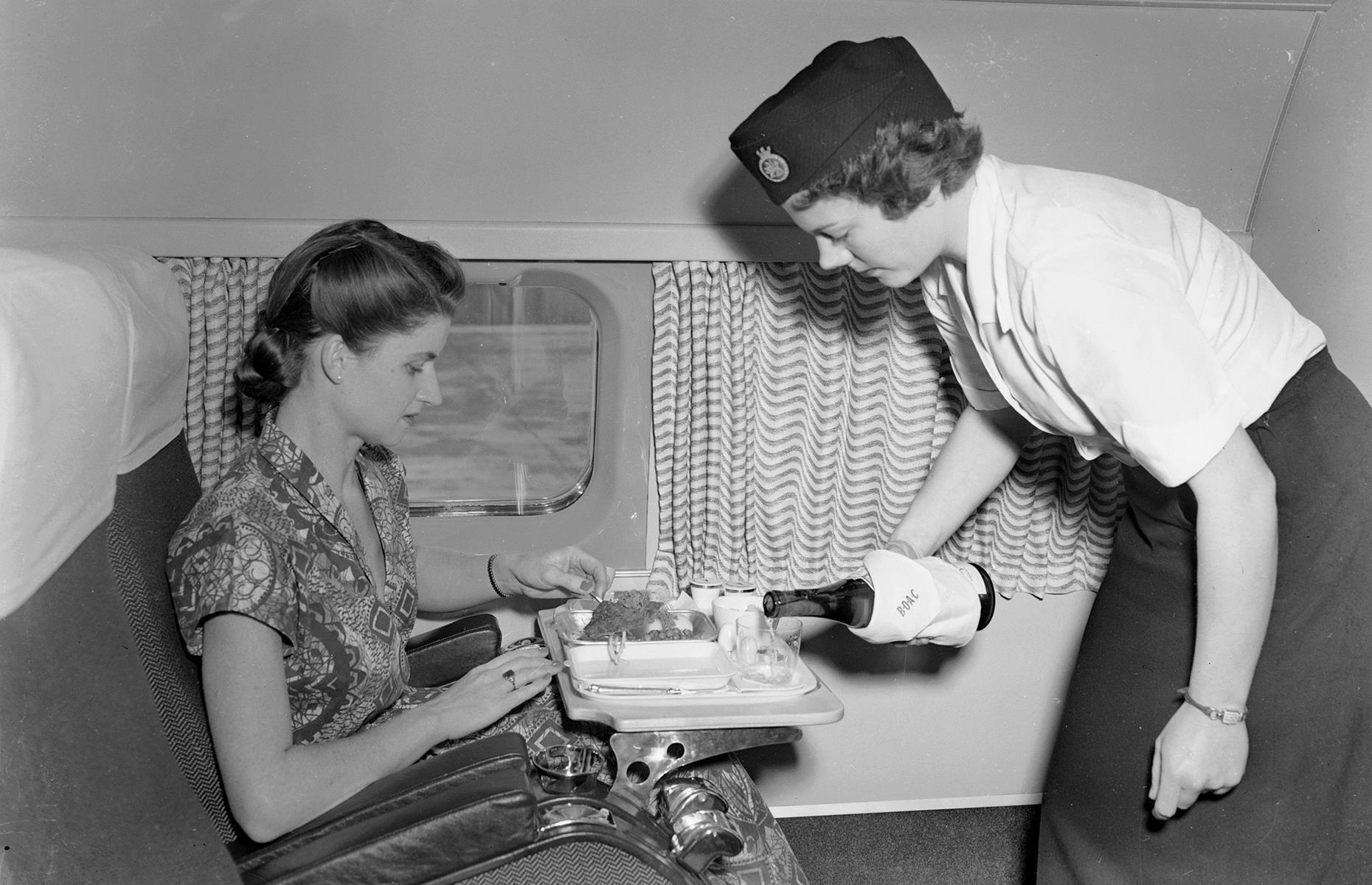
1950s: a passenger enjoying lunch on the world's first commercial jet airliner service
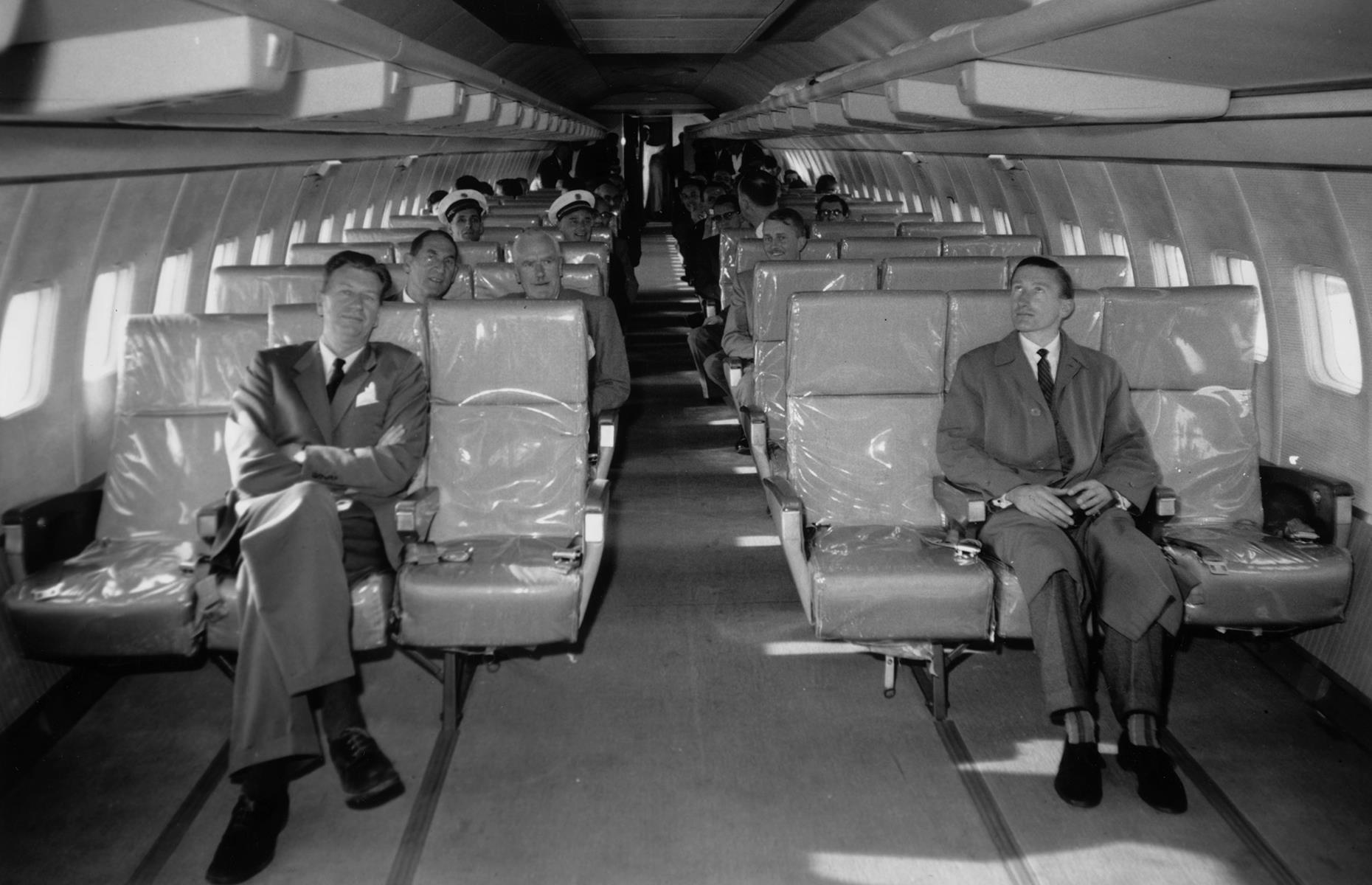
1950s: a test flight for the Boeing 707 jet airliner with Pan Am
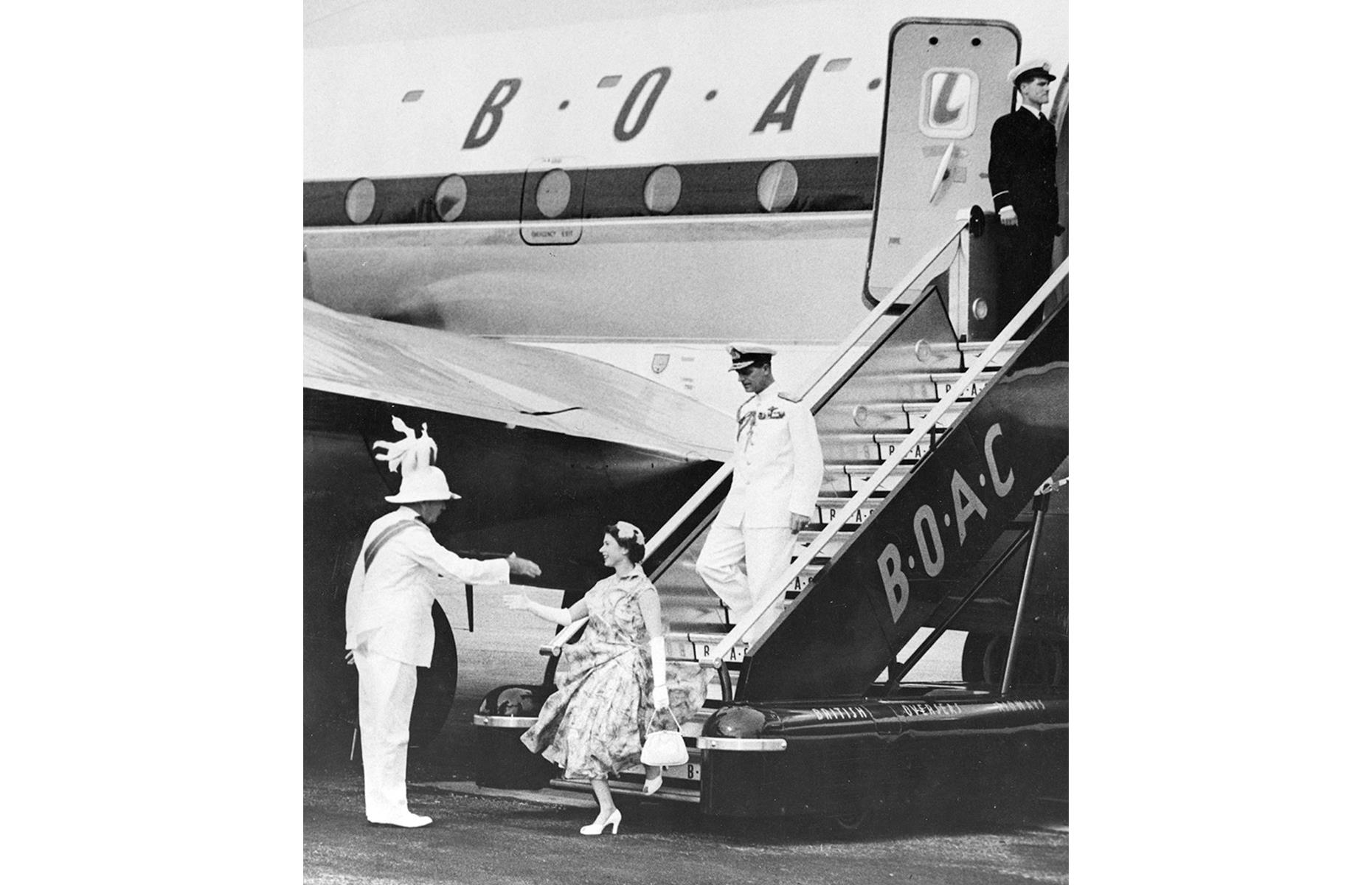
1950s: the Queen arrives in Bermuda on a BOAC flight in 1953
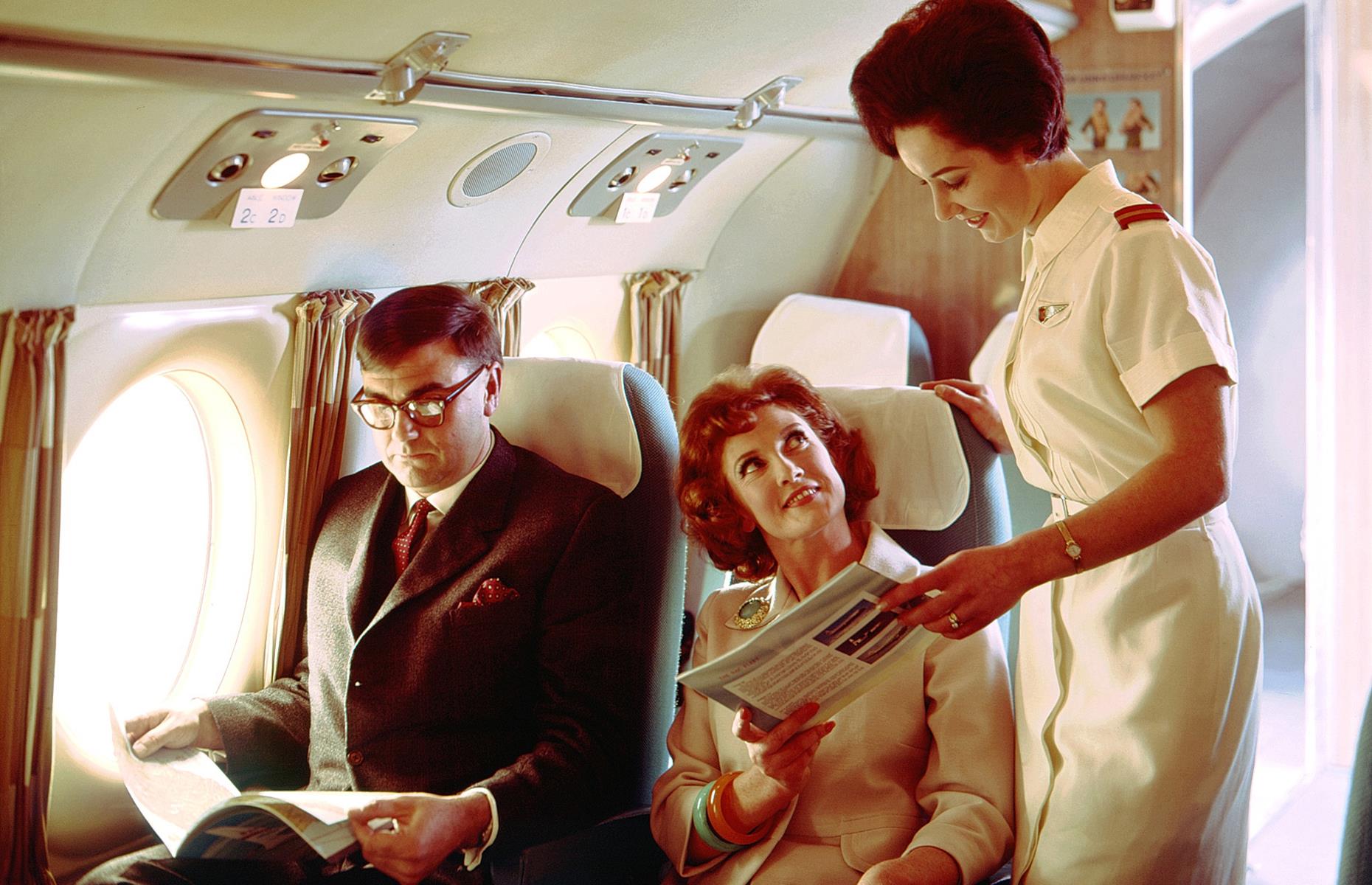
1950s: an air hostess attends to passengers on a National Airways Corporation flight in 1959
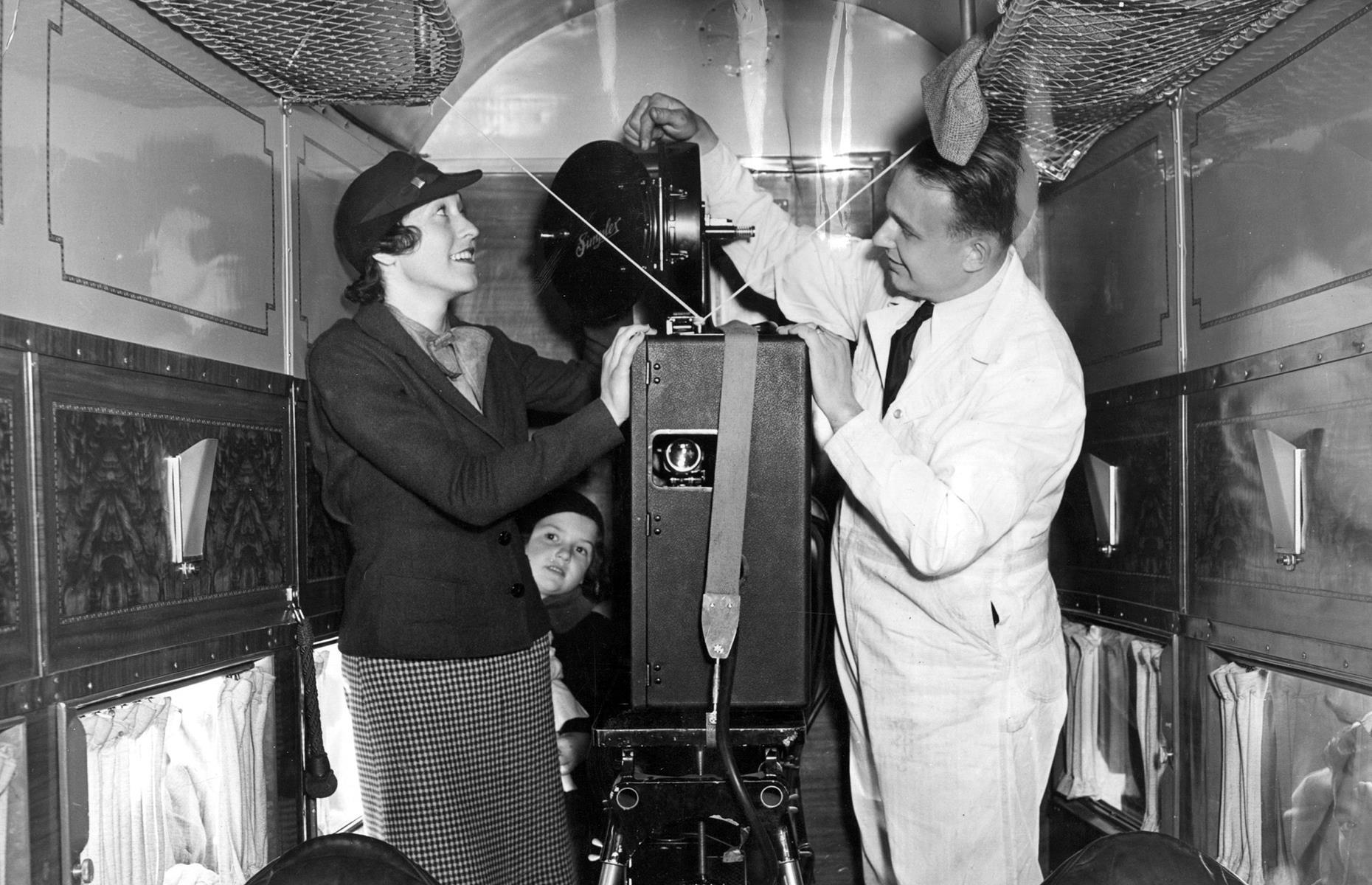
1950s: a movie projector on a United Airlines flight circa 1950
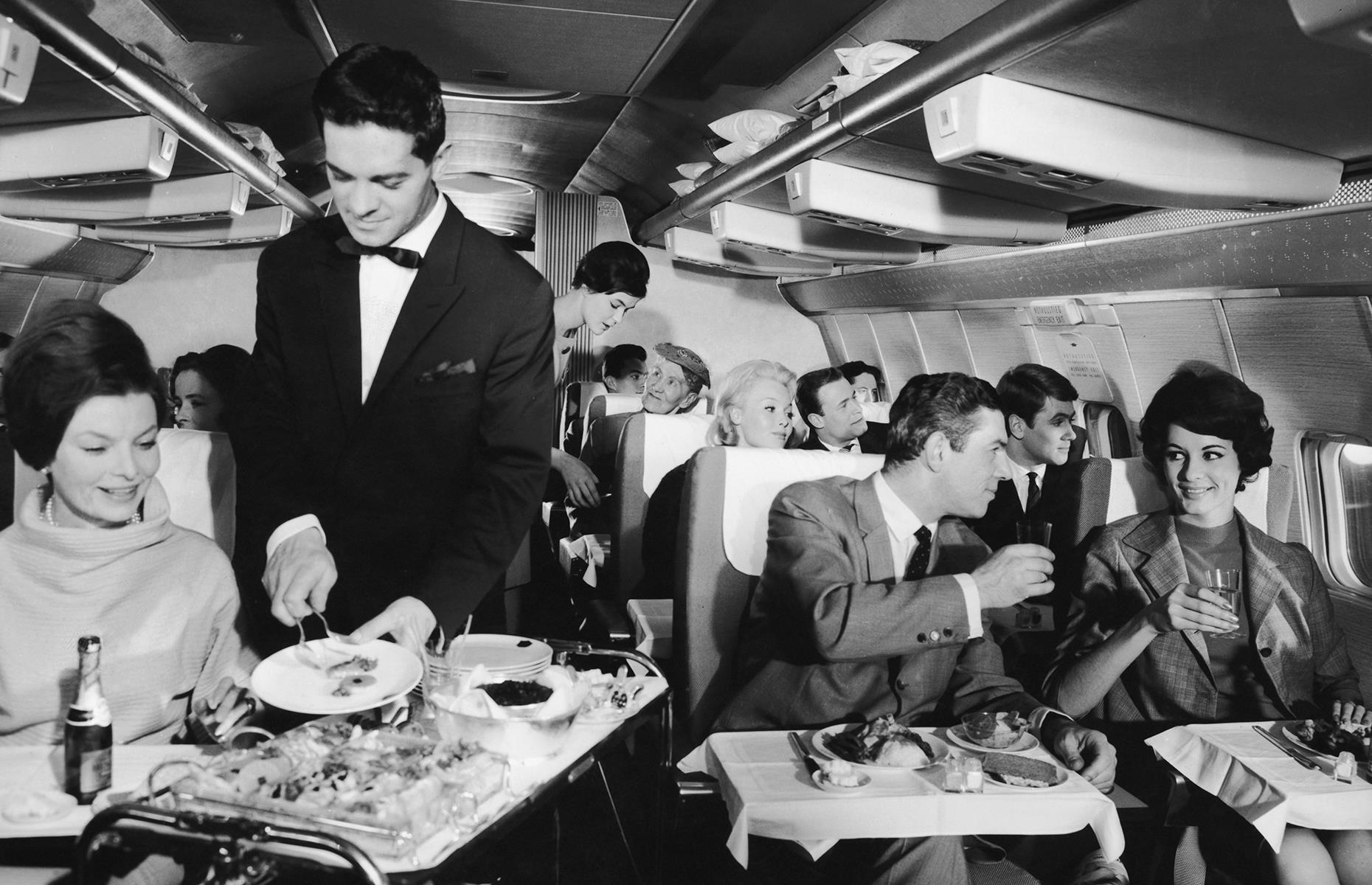
1960s: lunch service on a Lufthansa flight in 1967
The golden age of travel reigned on through the 1960s and, partly since there wasn't much else to do, dinner was a grand affair. Menus often included multiple courses, bread baskets and dishes such as steak or even lobster. In this 1967 snap, passengers are being served food onboard a Lufthansa flight.
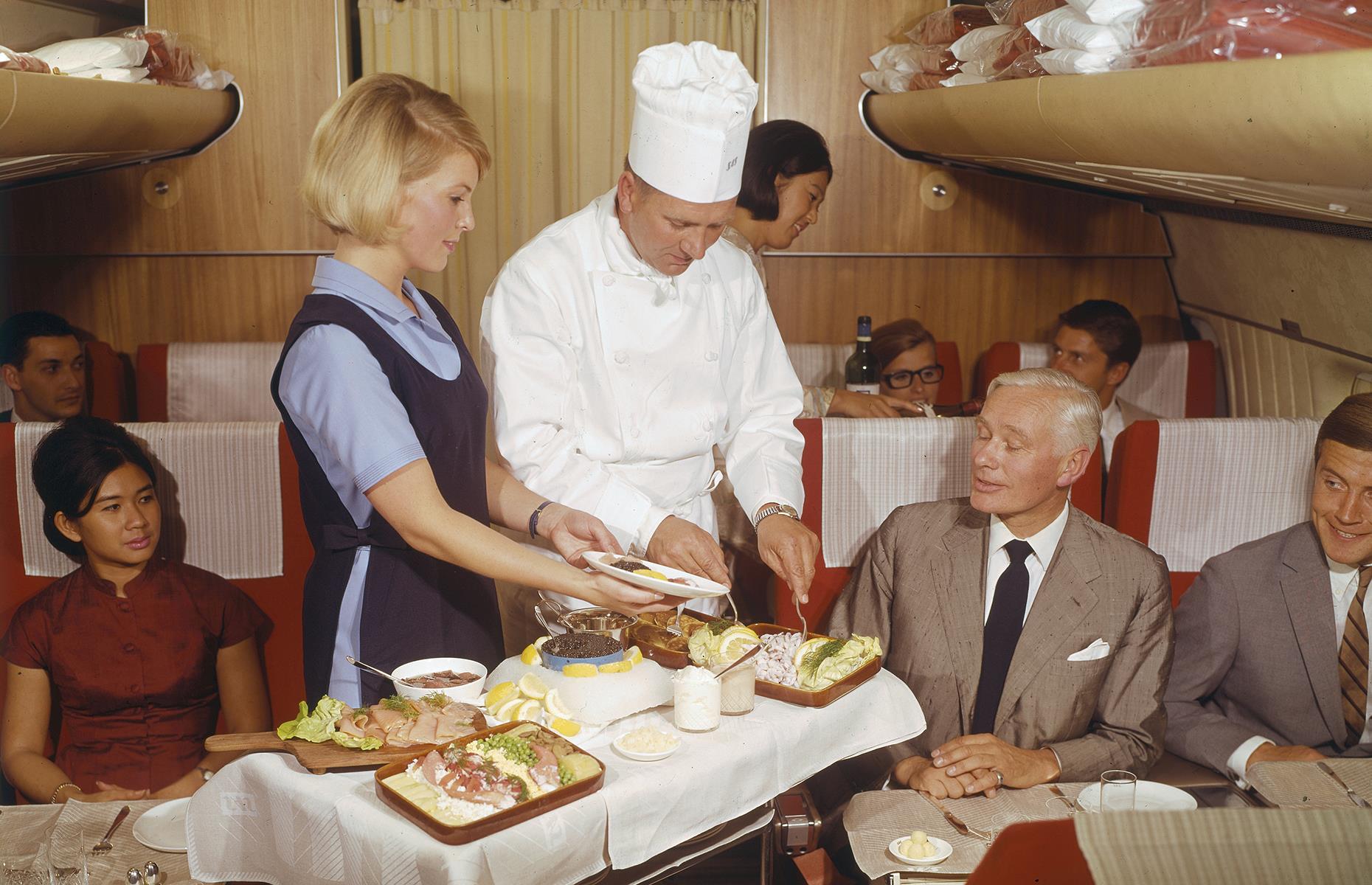
1960s: dinner aboard a SAS aircraft in 1969
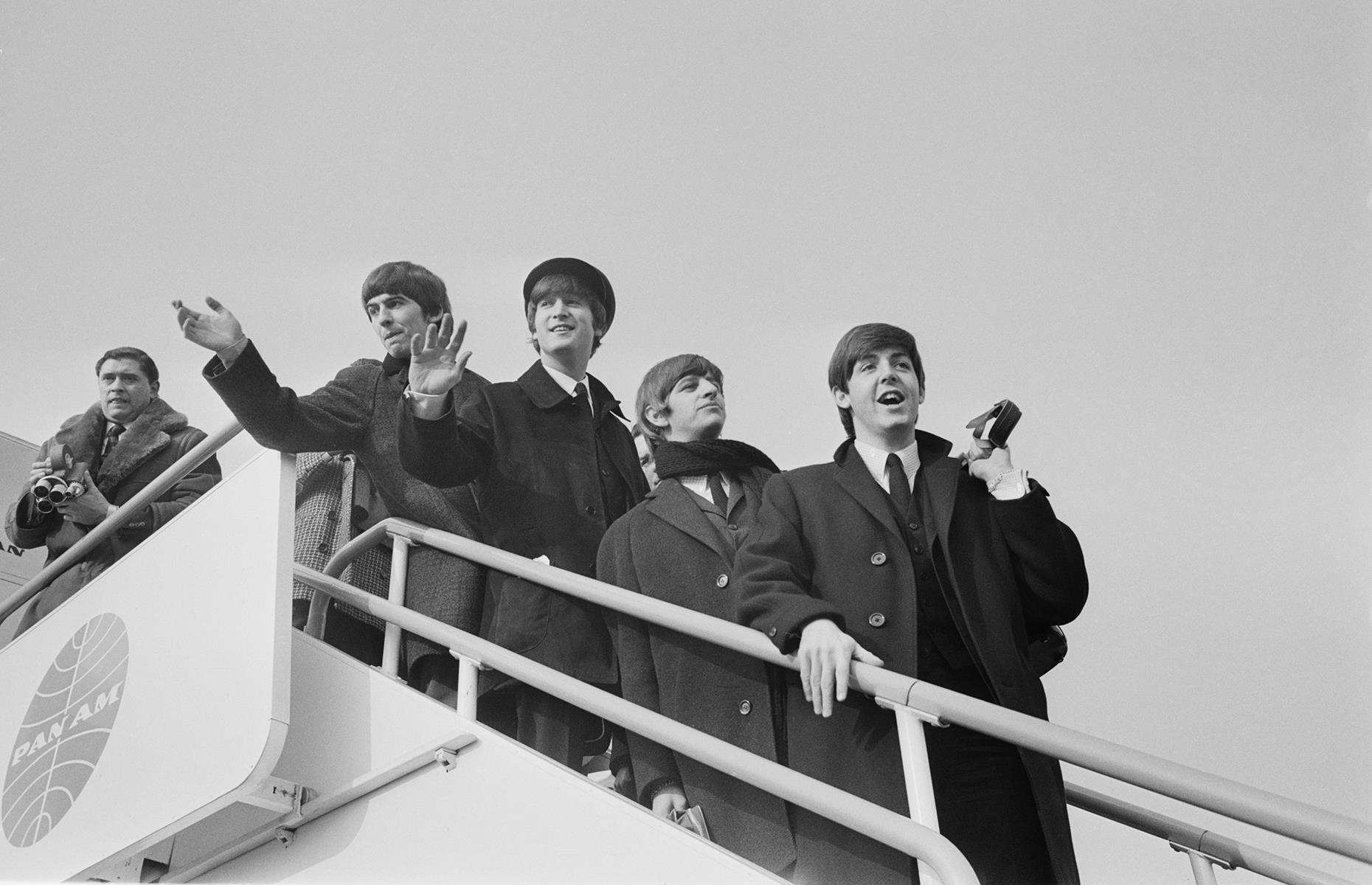
1960s: The Beatles arrive in London on a Pan Am flight in 1964
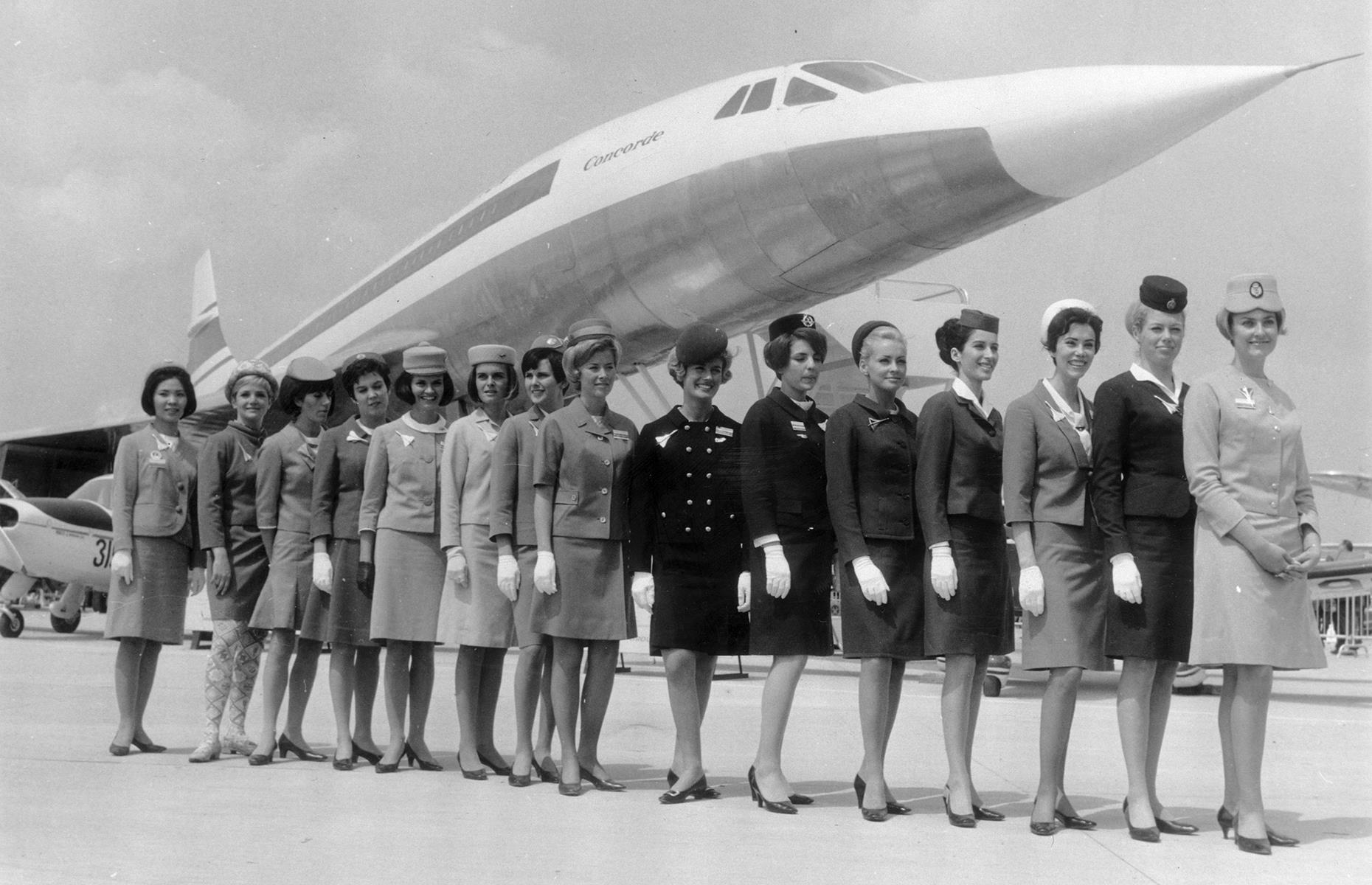
1960s: flight attendants line up before a model of Concorde in the 1960s

1970s: the first Concorde flight from London Heathrow to Bahrain in 1976
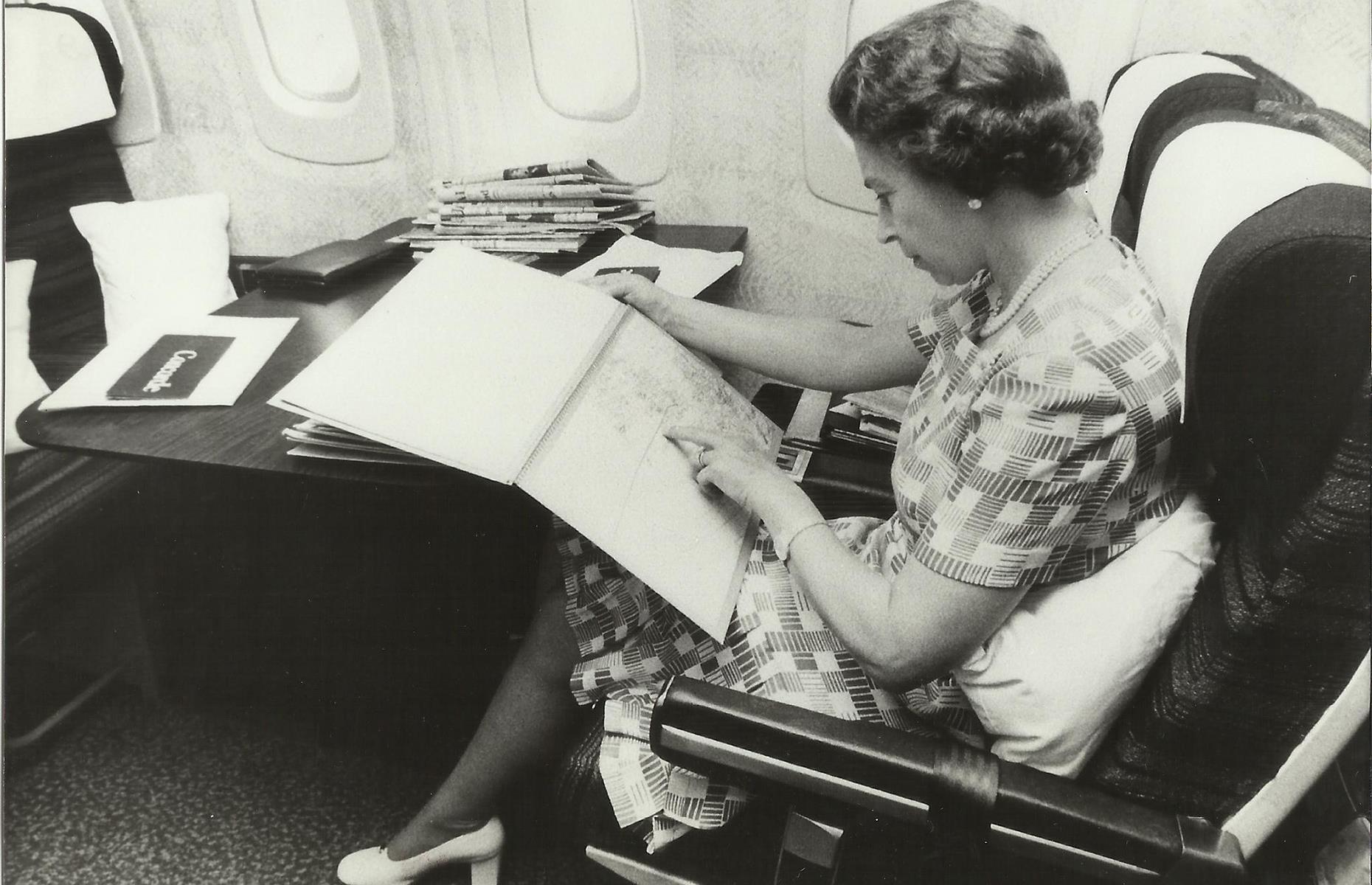
1970s: the Queen on a Concorde aircraft in 1977
Concorde got the royal seal of approval (the Queen is pictured here onboard a Concorde aircraft in 1977), with its ability to cross the Atlantic in just 3.5 hours. But only a privileged few could afford to ride aboard the Concorde and it ultimately didn't shake up commercial air travel in the way it had been hoped. Cancelled routes, economic setbacks and a devastating crash meant the Concorde was out of service by 2003.
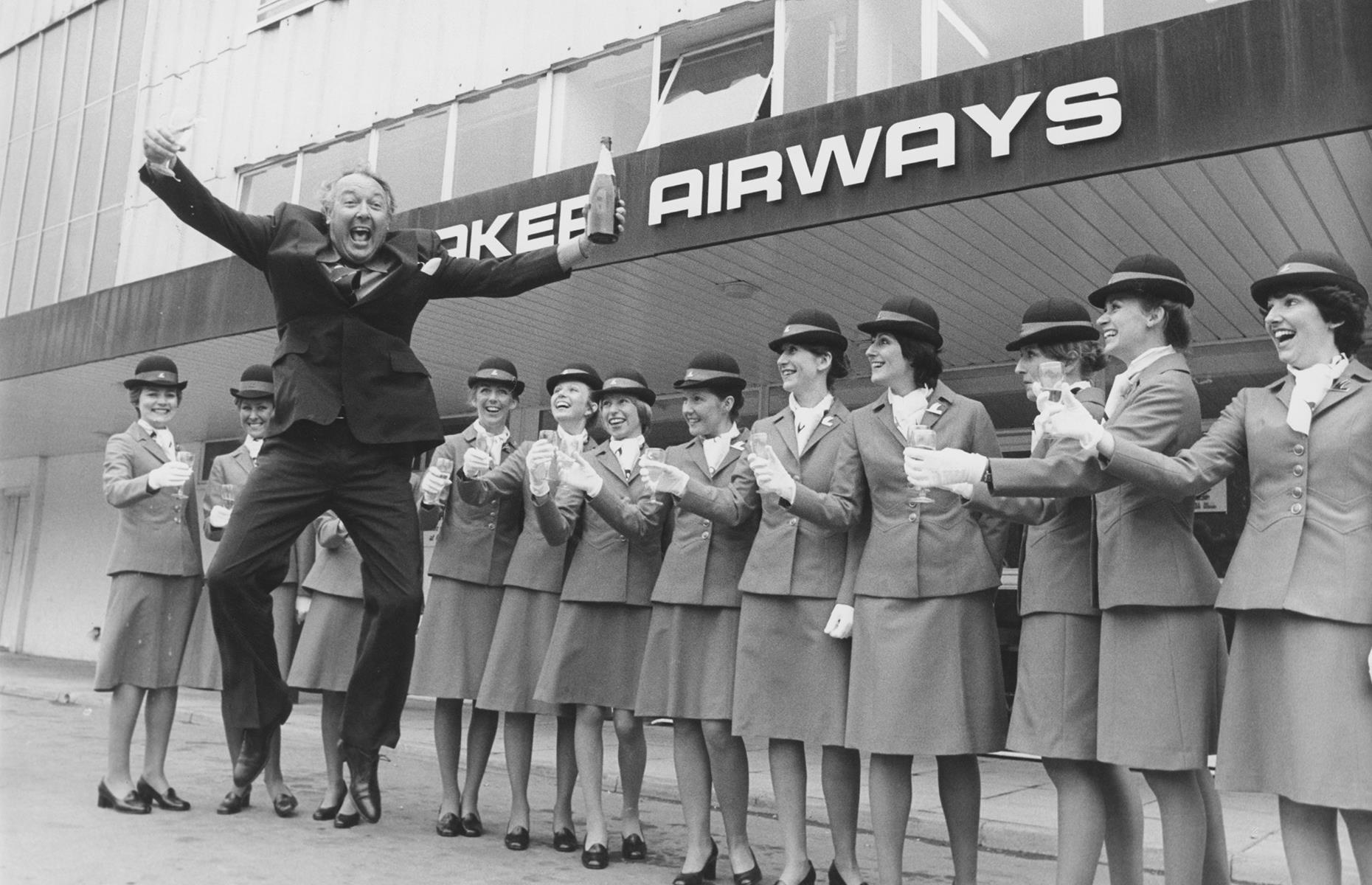
1970s: Laker Airways founder Freddie Laker celebrates the airline's success
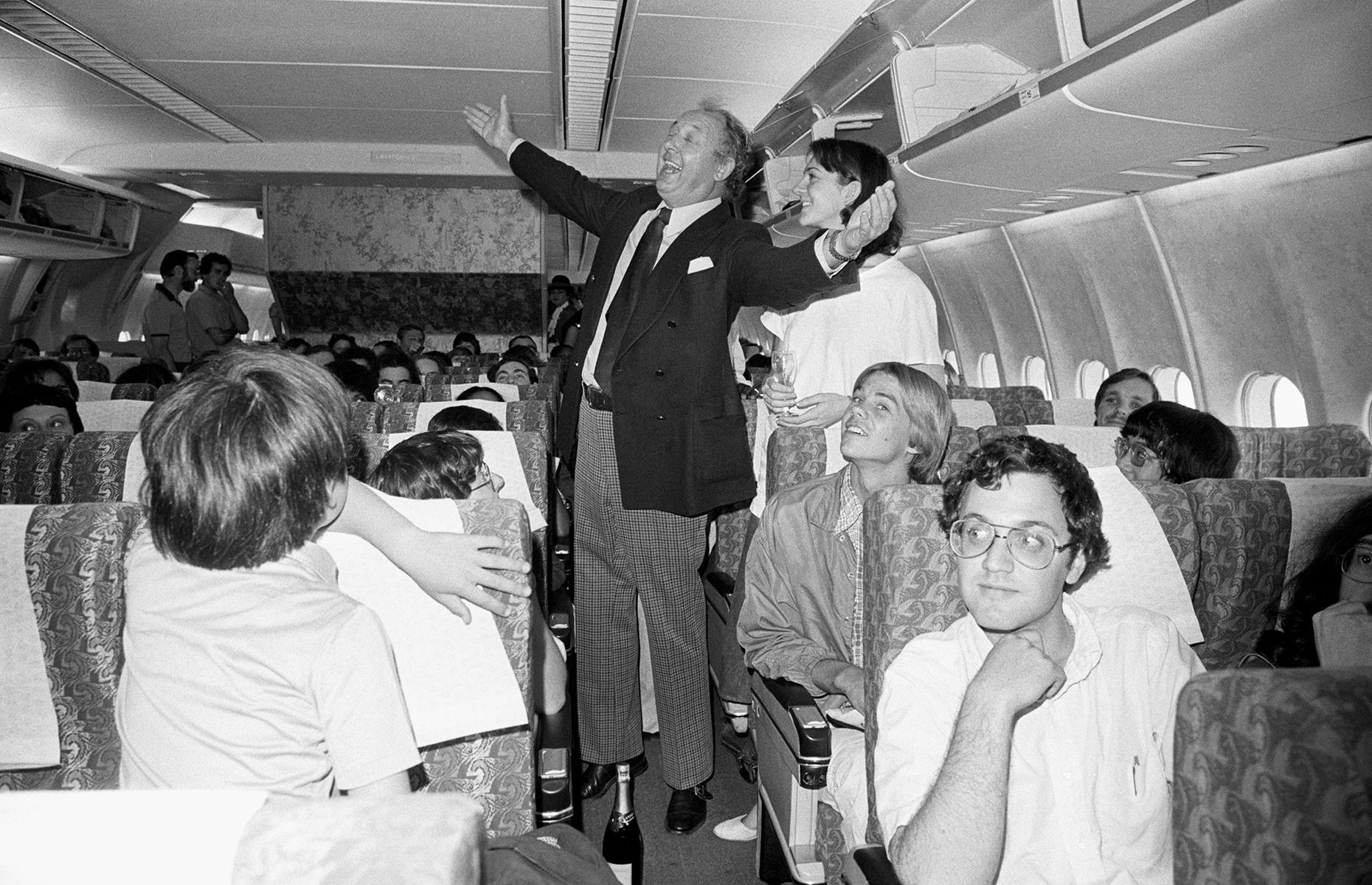
1970s: Laker and passengers aboard Laker Airways' Skytrain
Laker Airways' Skytrain offered a lower fare service between London Gatwick and New York's JFK, which began on 26 September 1977. Like many budget airlines today, the "no frills" service meant passengers had to purchase meals onboard and weren't subject to the usual luxuries of air travel in the era. Laker also came up with ways to reduce fuel consumption and engine wear to enable the lower costs. He's pictured here celebrating with passengers aboard the Skytrain in 1979.
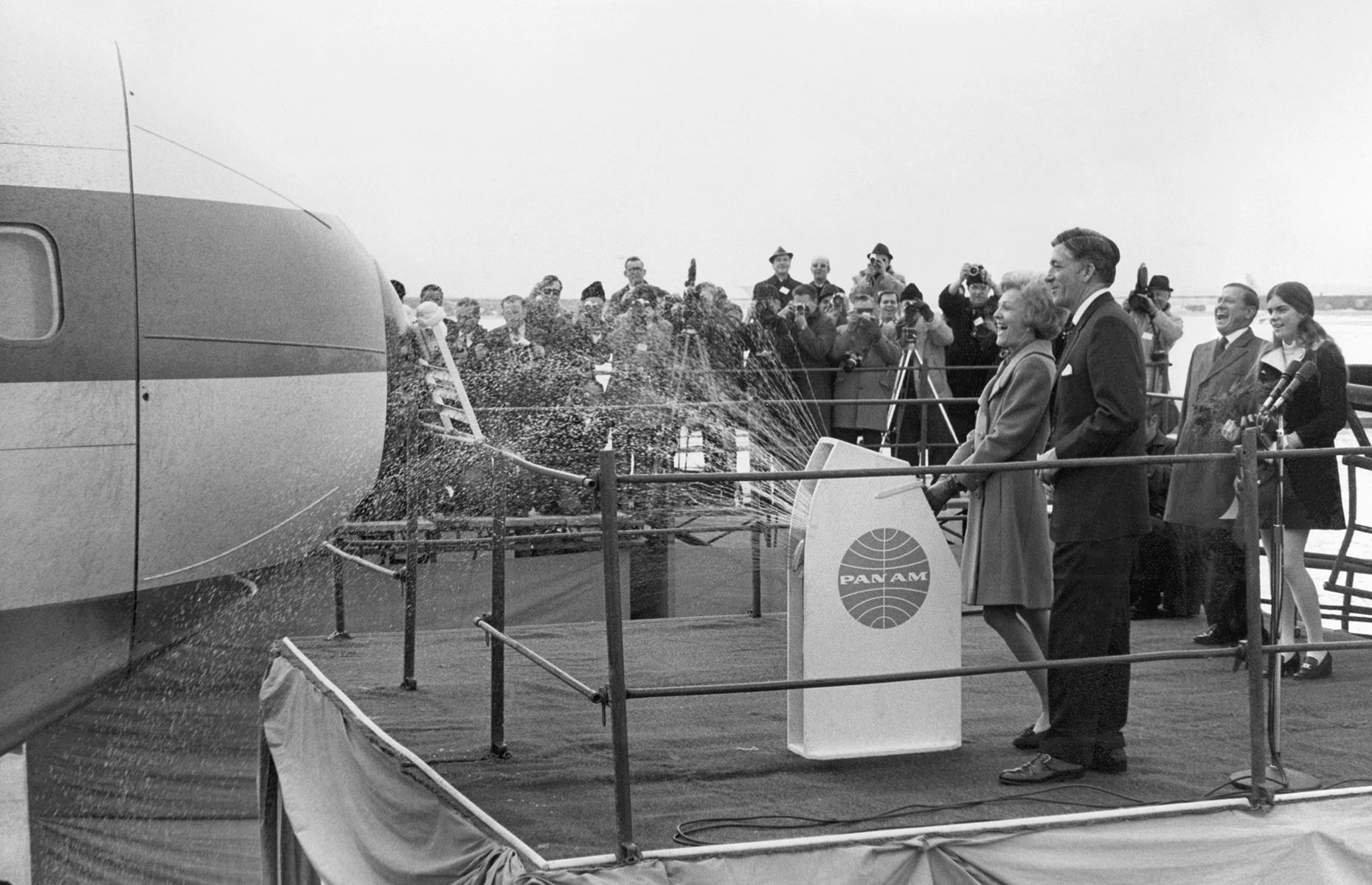
1970s: the first scheduled Pan Am Boeing 747 flight
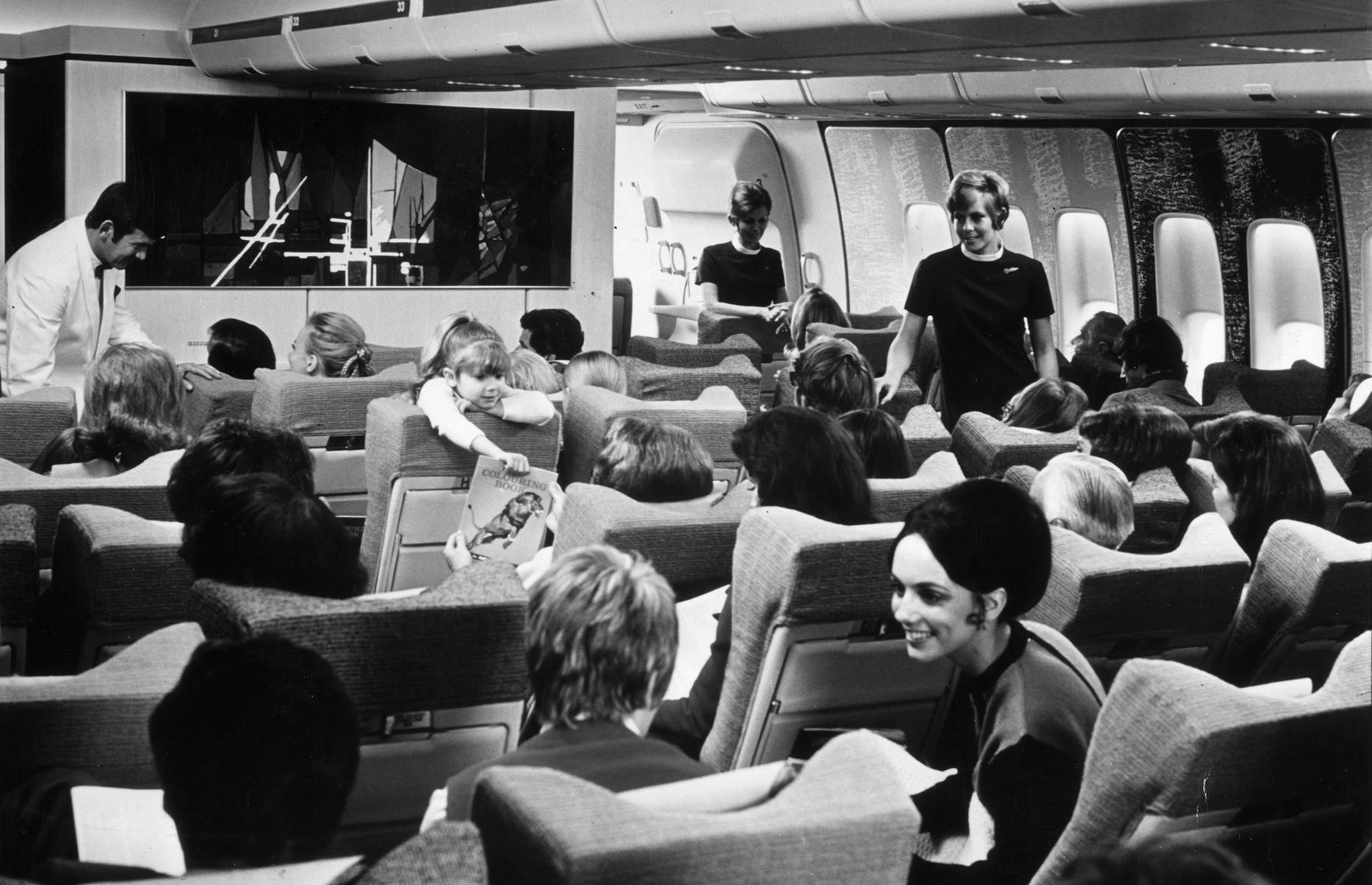
1970s: passengers in the cabin of a Boeing 747
This was the first time that air travel was truly opening up to the masses. Since planes were larger, airlines were able to hold more passengers and therefore sell more tickets at a reduced price. Though flying still wasn't cheap, it was no longer only reserved for the super-rich. This 1970s shot shows the spacious cabin of a BOAC Boeing 747, filled with families, couples and other holidaymakers.
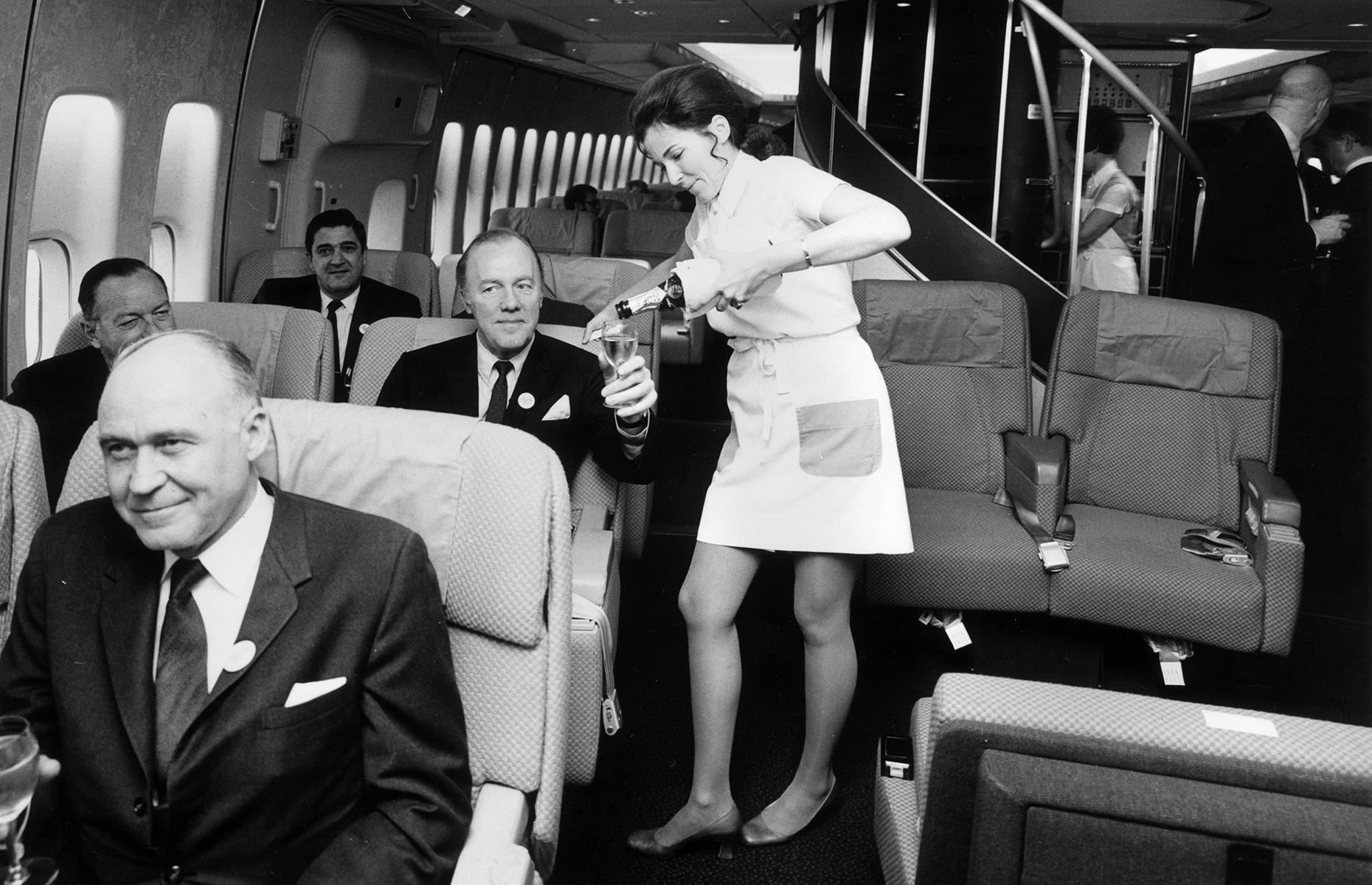
1970s: passengers are served Champagne on a Pan Am 747 flight
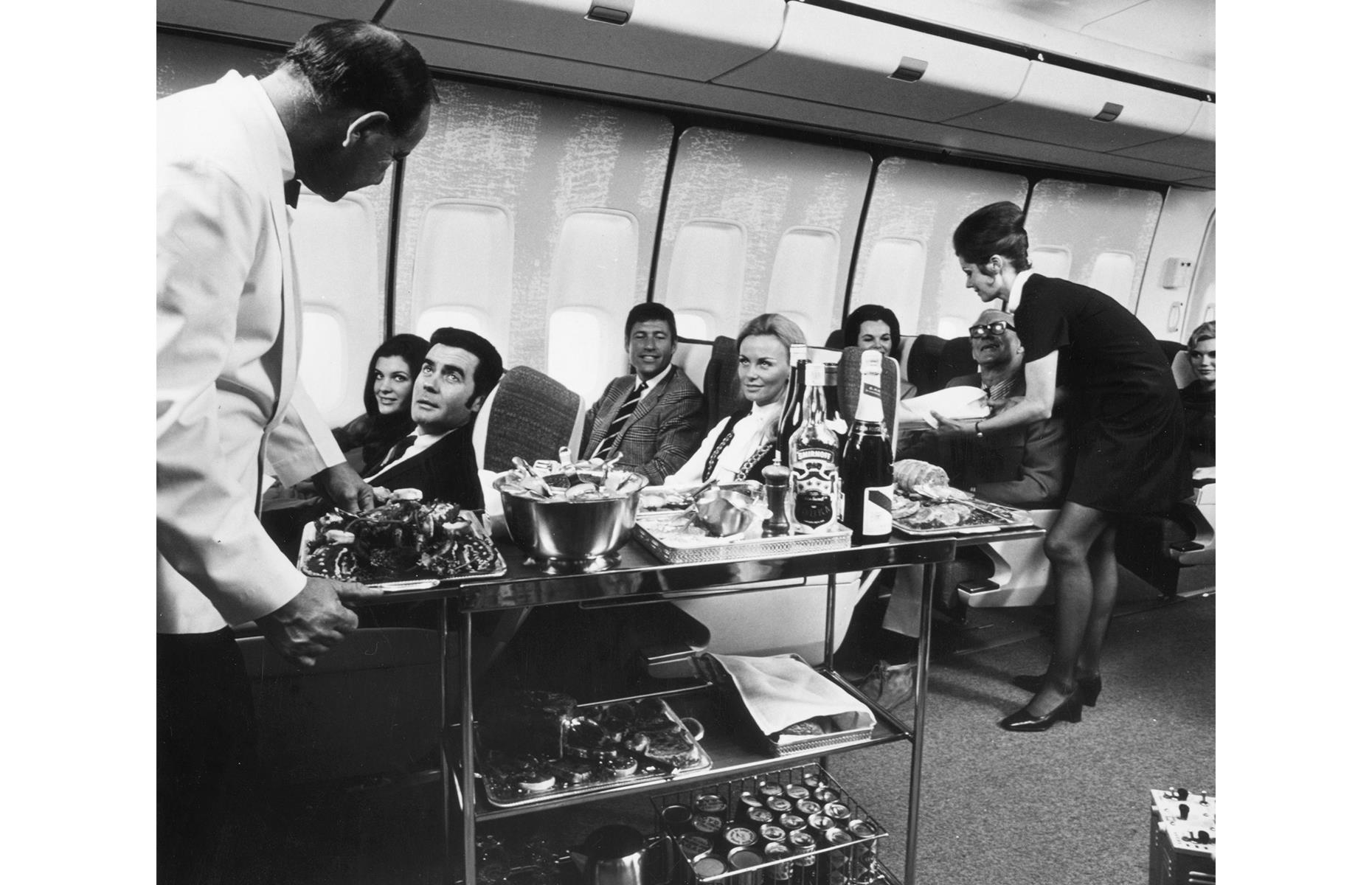
1970s: lunch is served aboard a Boeing 747
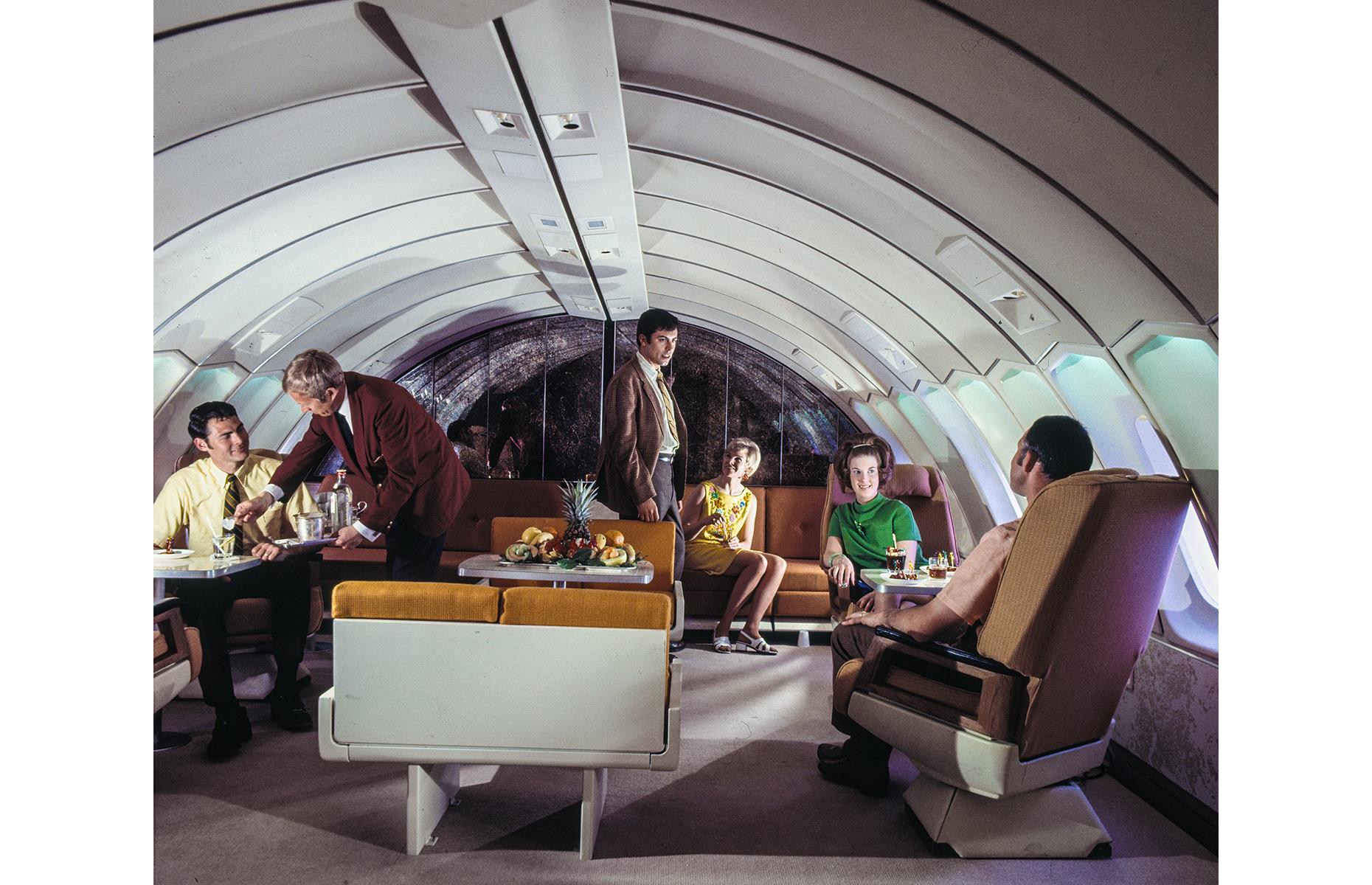
1970s: a lounge on SAS's Boeing 747-B "Huge Viking"
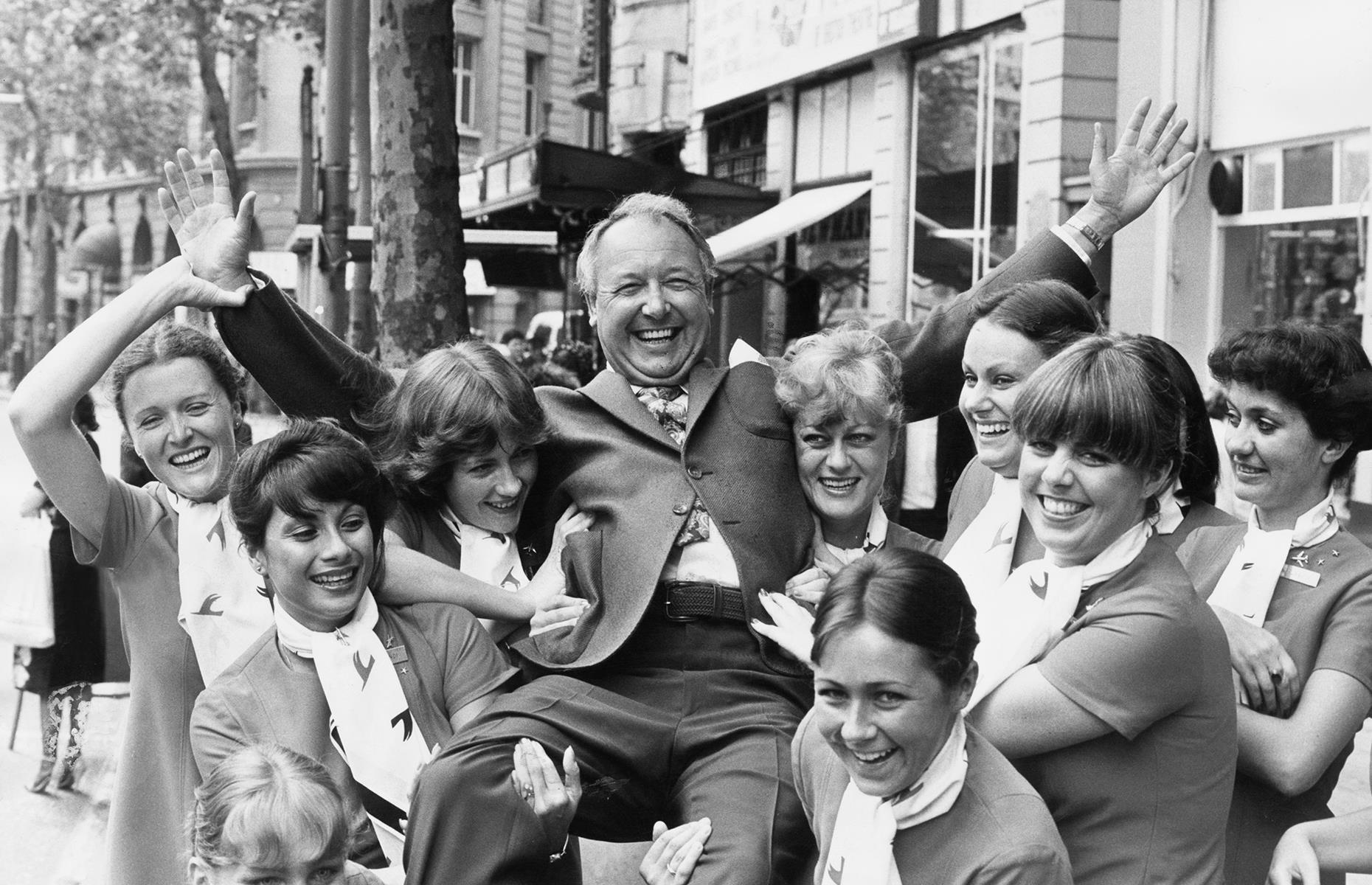
1980s: Laker celebrates further fare cuts in 1980
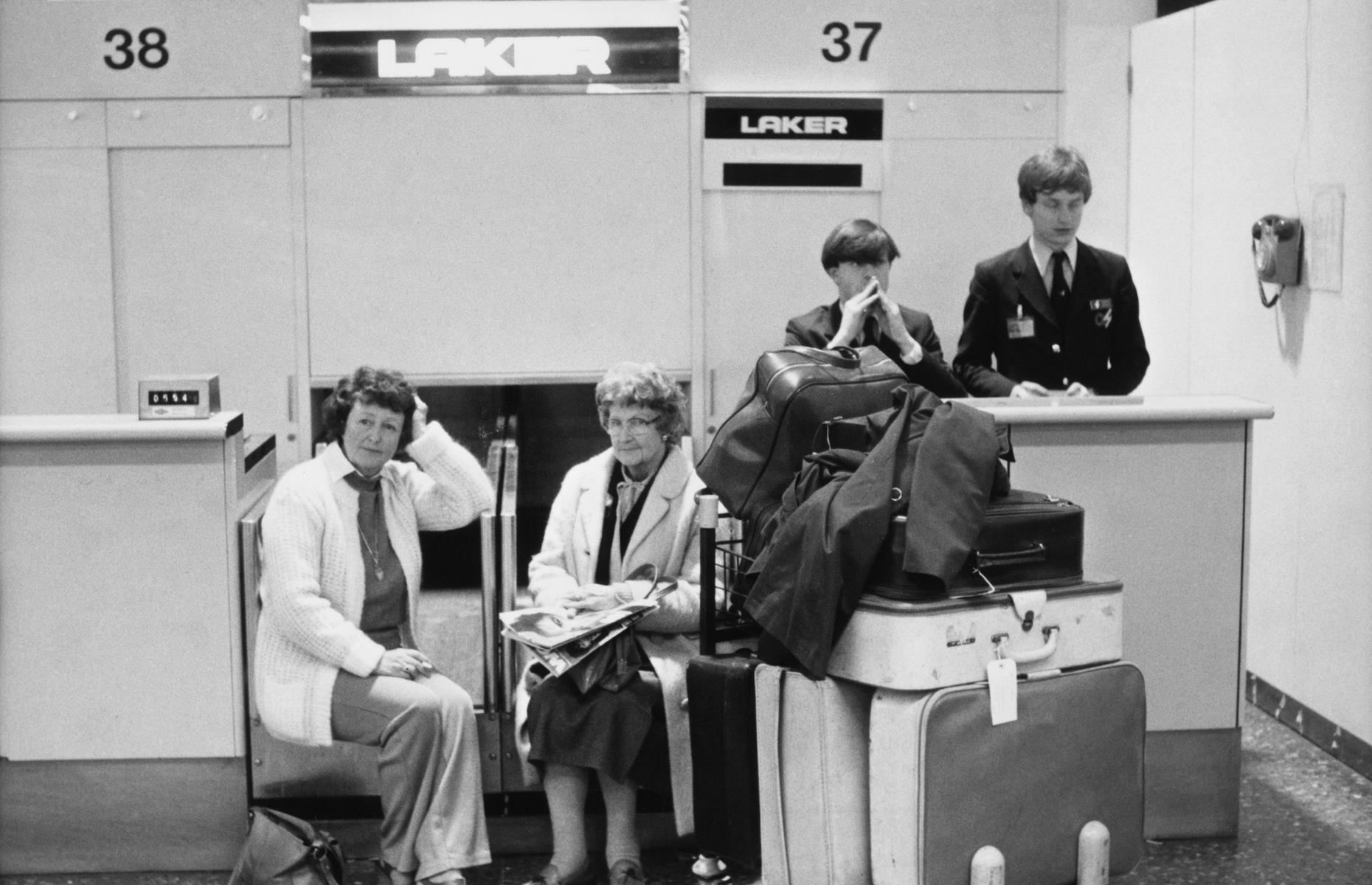
1980s: passengers are stranded as Laker Airways collapses in 1982
Laker Airways collapsed in 1982, saddling debts amounting to $374 million. More than 6,000 passengers were left stranded in airports around the world. Here, exasperated travelers and dismayed Laker staff feel the brunt of the collapse on 5 February 1982.

1980s: a Ryanair aircraft in 1988
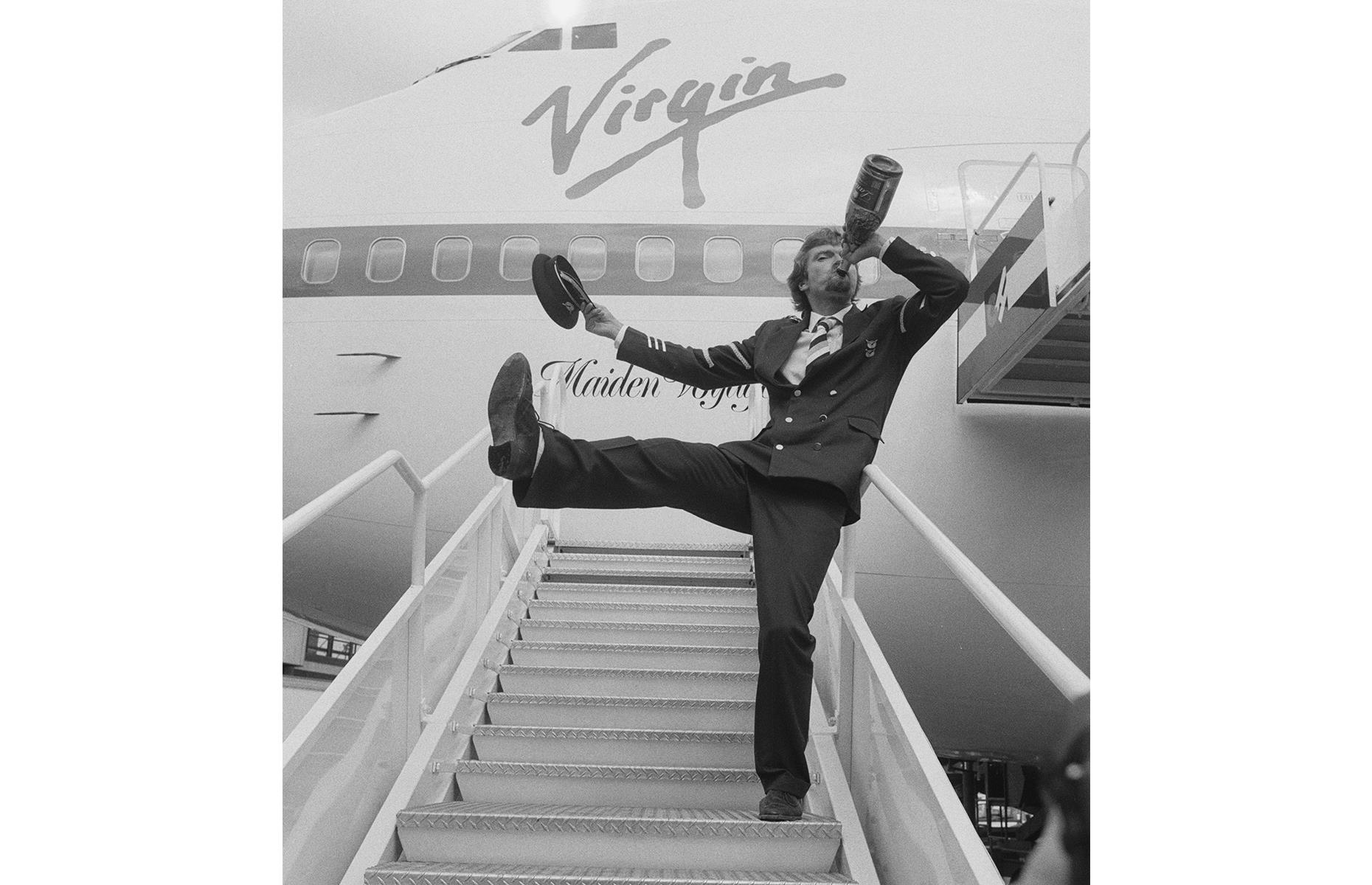
1980s: Richard Branson celebrates the launch of his new airline, Virgin Atlantic Airways in 1984
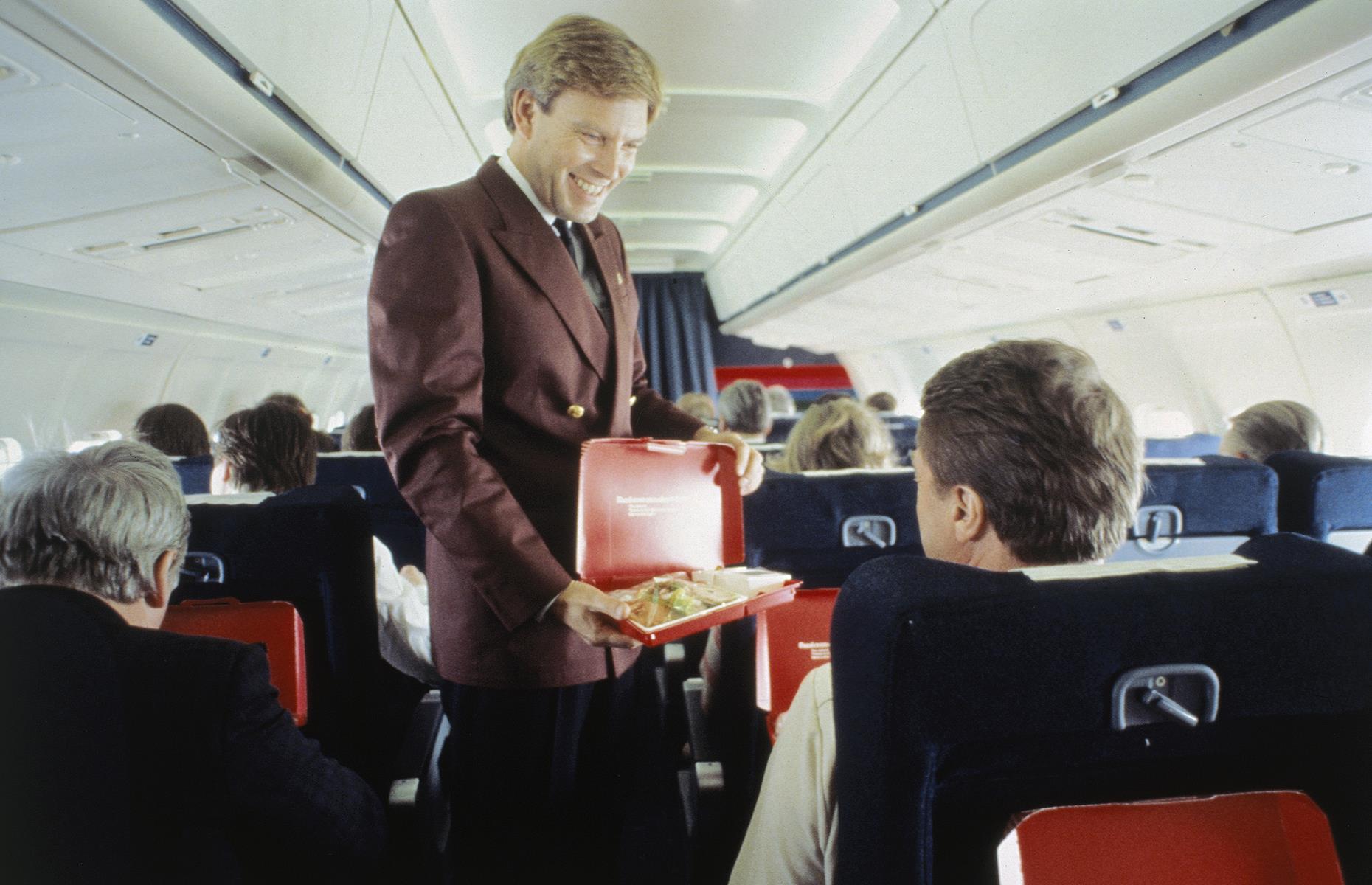
1980s: a flight attendant serves dinner on a SAS flight circa 1980s
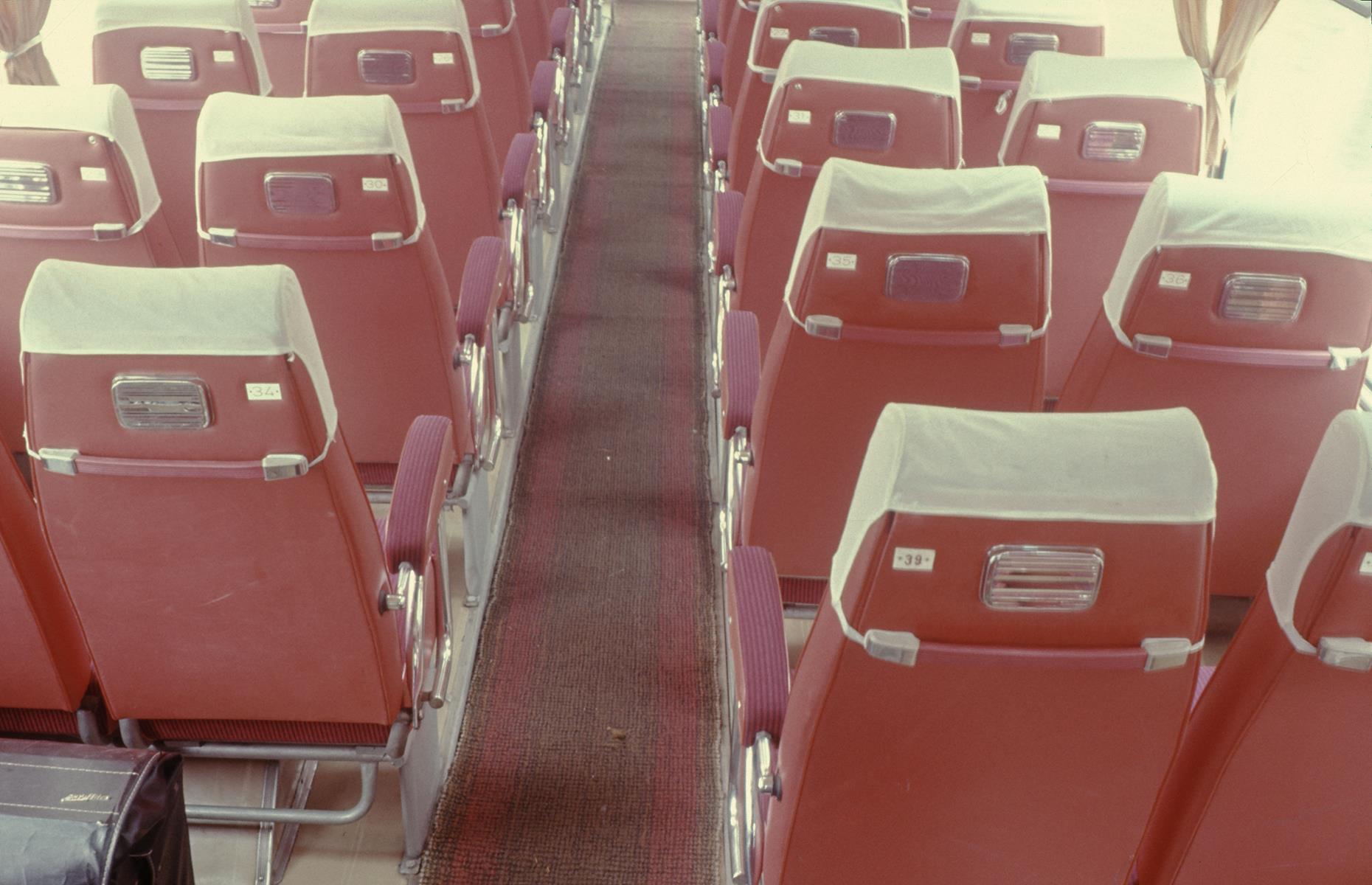
1980s: ashtrays on a commercial flight
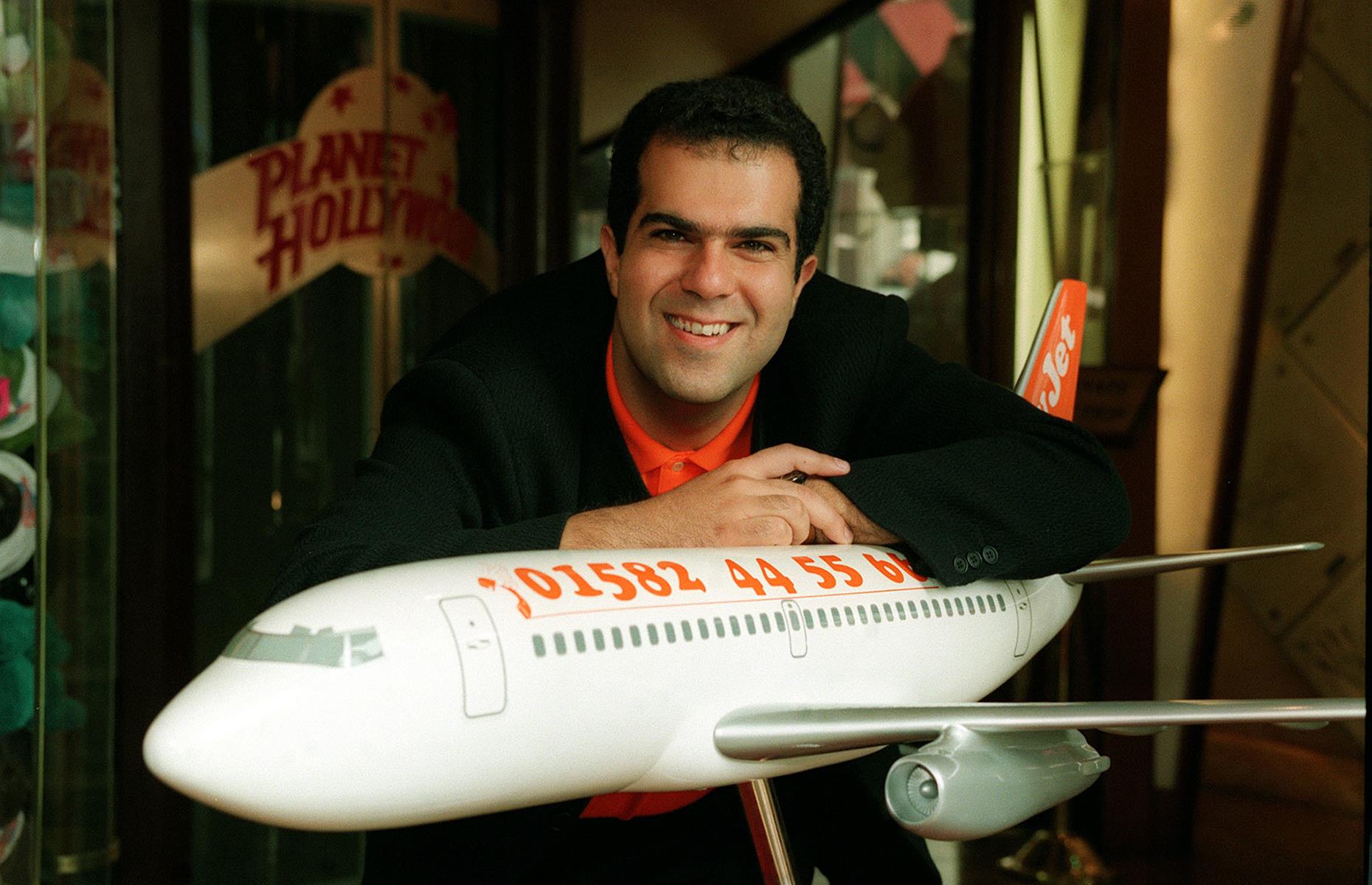
1990s: easyJet boss Stelios Haji-Ioannou in 1995
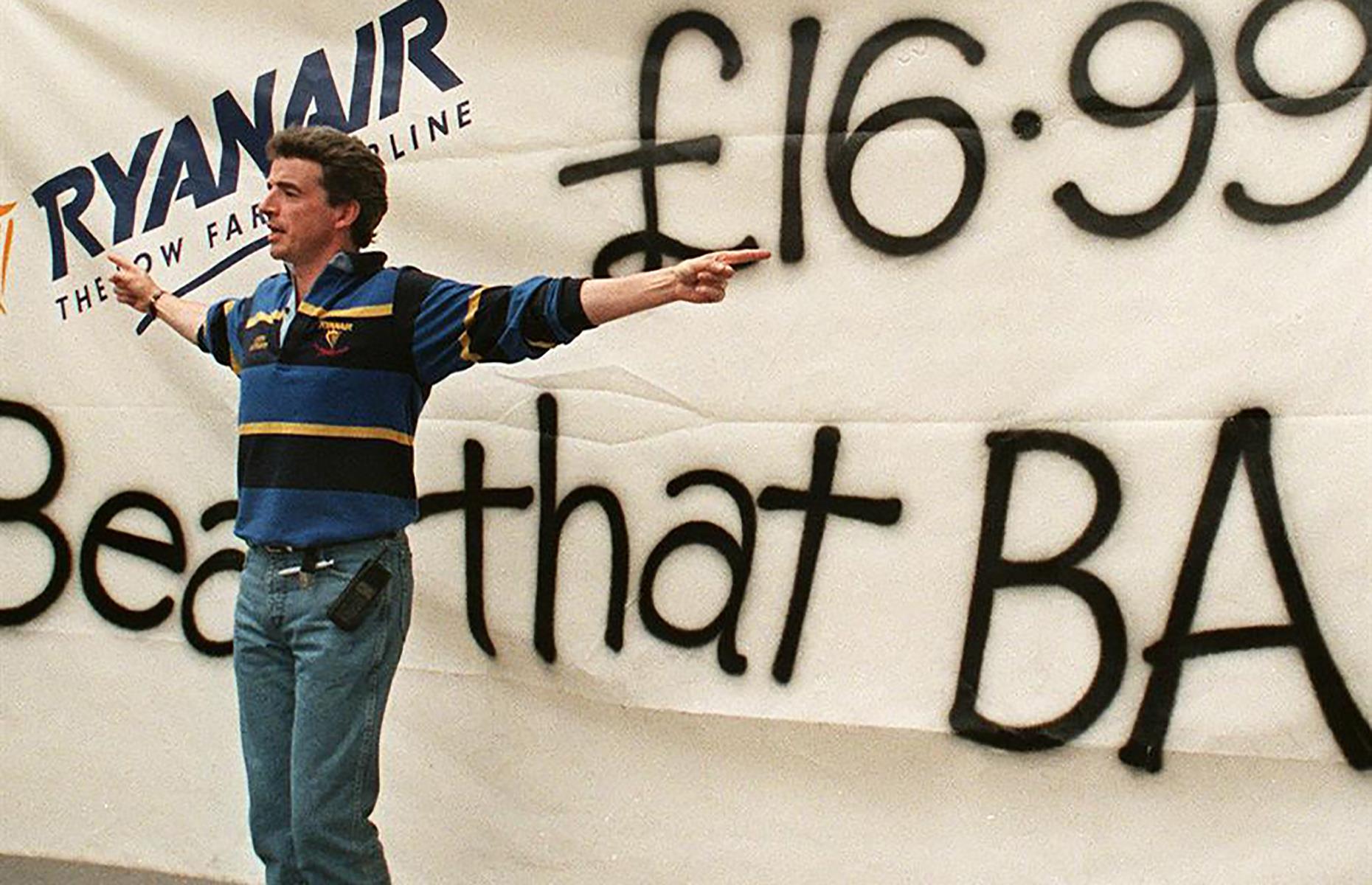
1990s: Ryanair's chief executive promotes low-fare flights
The introduction of Ryanair and easyJet (and also Norwegian in 1993) meant pressure was put on traditional carriers, fares were pushed down and air travel became increasingly more accessible. As travelers also began booking holidays online, competitive pricing became more important than ever.
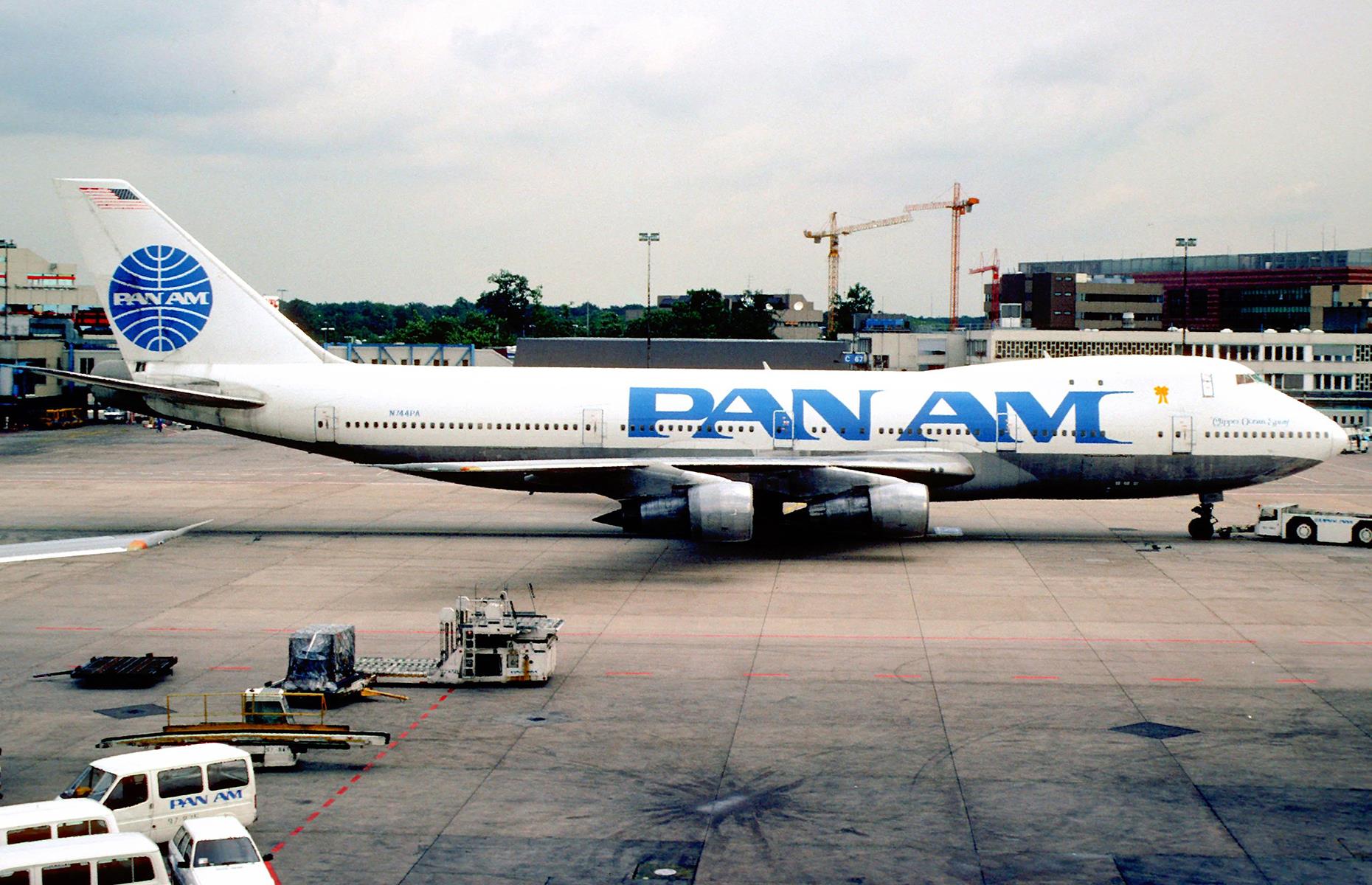
1990s: a Pan Am aircraft in 1991
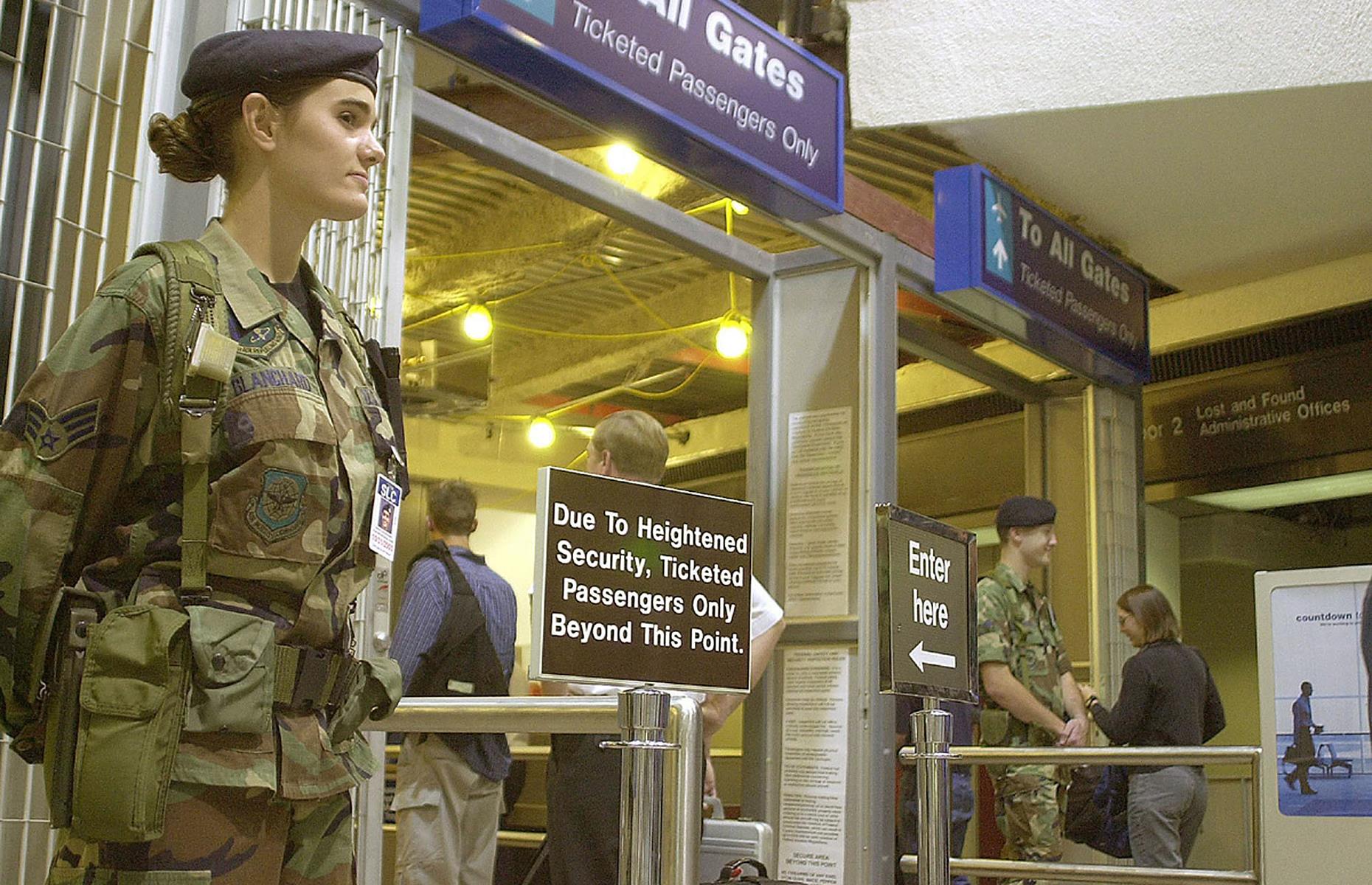
2000s: security at Salt Lake City International Airport in 2001
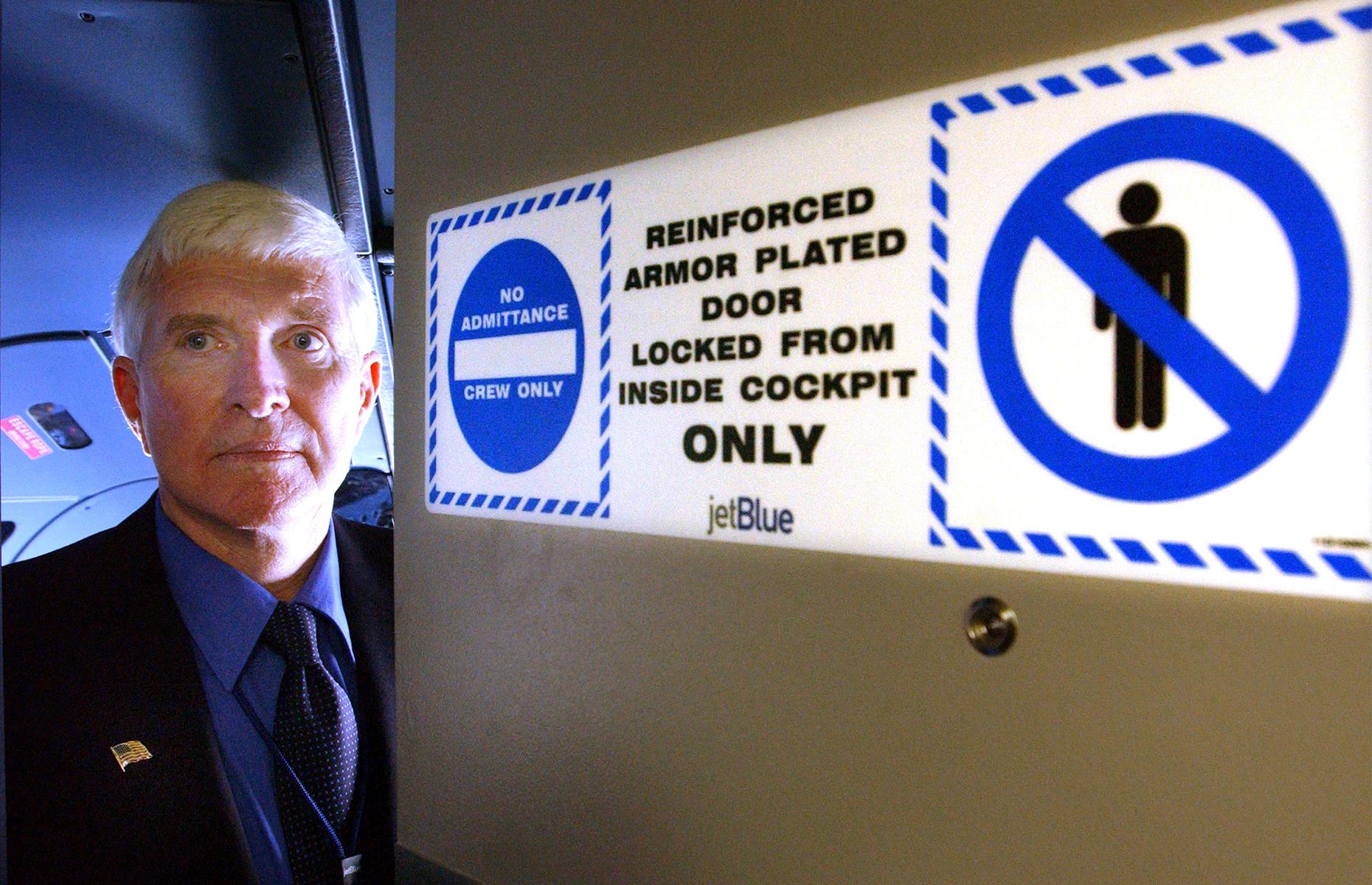
2000s: the door to an aircraft cockpit in 2001
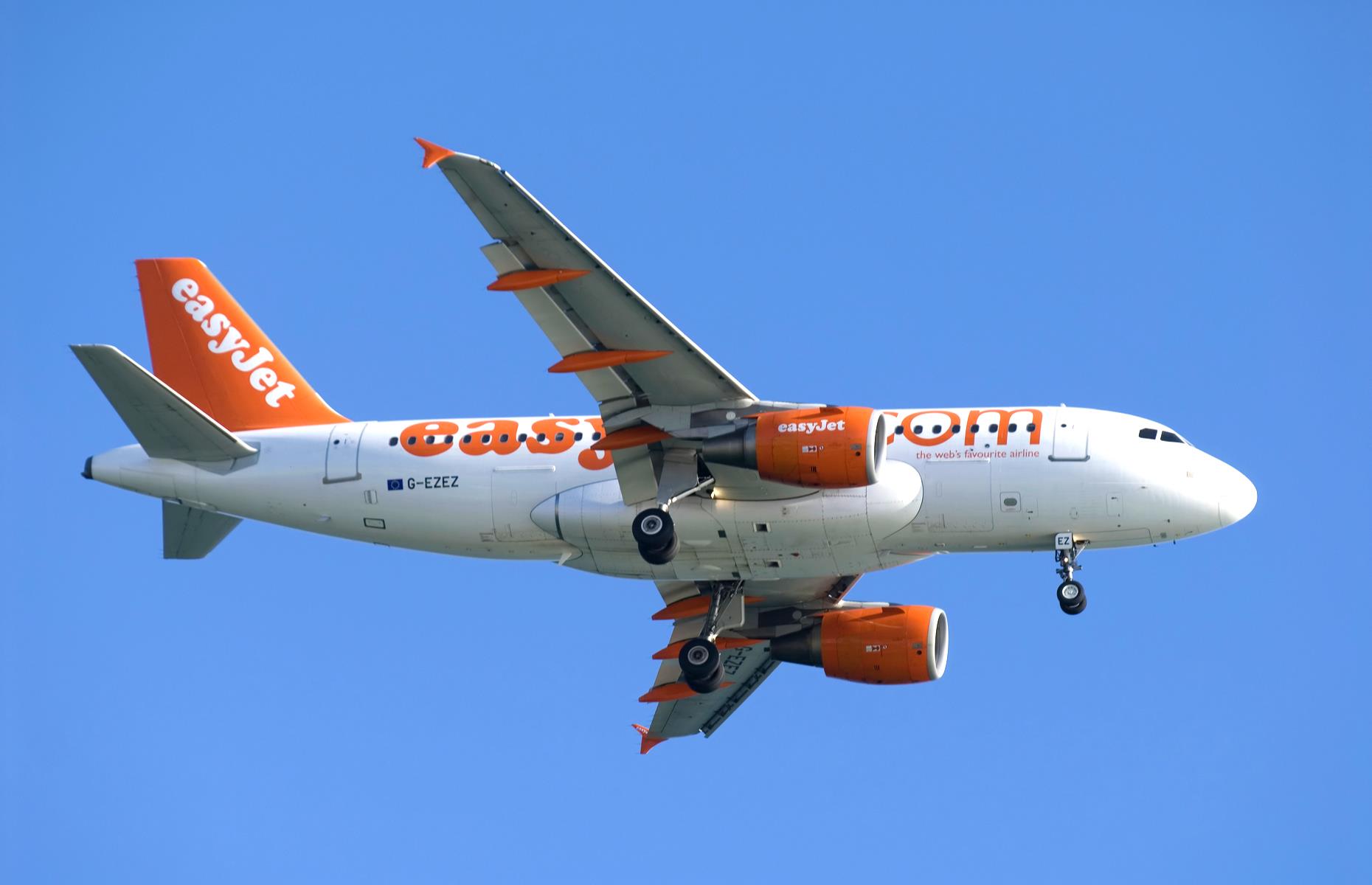
2000s: an easyJet aircraft flying in 2009
Travelers eschewed air travel in the years following 9/11 and, according to the Bureau of Transportation Statistics , it took until 2004 for air-passenger numbers to reach their pre-9/11 peak. Commercial air travel was recovering by the end of the decade, though, with US air passengers numbering 769.6 million in 2007 – a record high. During this time, it was low-cost carriers that saw the most growth.
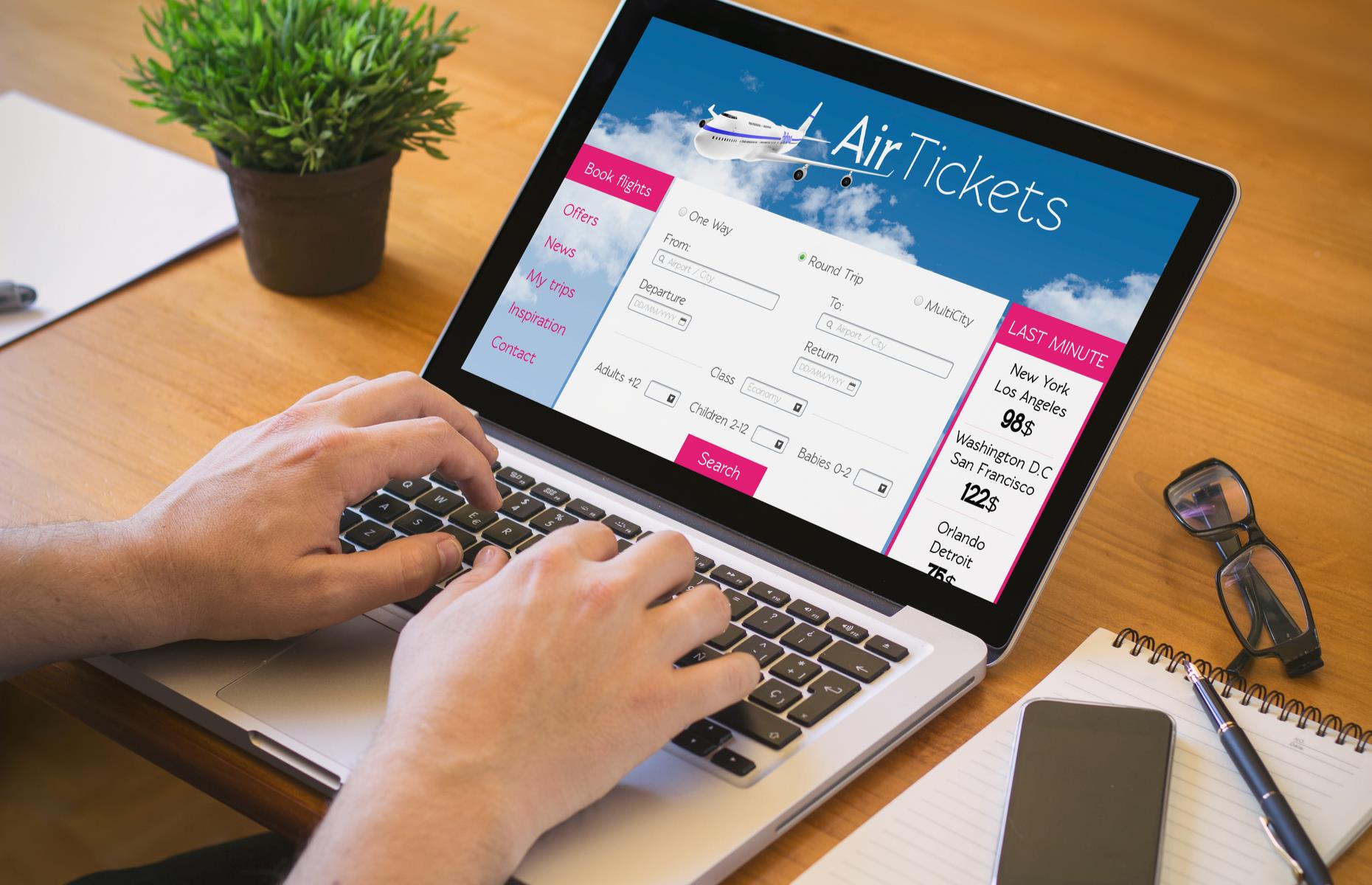
2000s: a traveler books flights online
Another significant change during this decade was the way travelers were choosing to book their flights. According to PhoCusWright , a tourism research company, 2009 was the first year that more than half of all travel-related bookings were made online. This placed even more pressure on airlines to be competitive and offer the best value for money.

2010s: a man works on his laptop during a flight
The internet hasn't just infiltrated the booking process. Nowadays it's commonplace for carriers to offer in-flight Wi-Fi, either as part of the package, or for an extra premium. In a major shift from the golden age of travel, this means that flying today is no longer just about pleasure and relaxation – it's also about catching up with work and keeping in touch with people on the ground. Online check-in and smartphone boarding passes have also revolutionized the airport experience over the years.
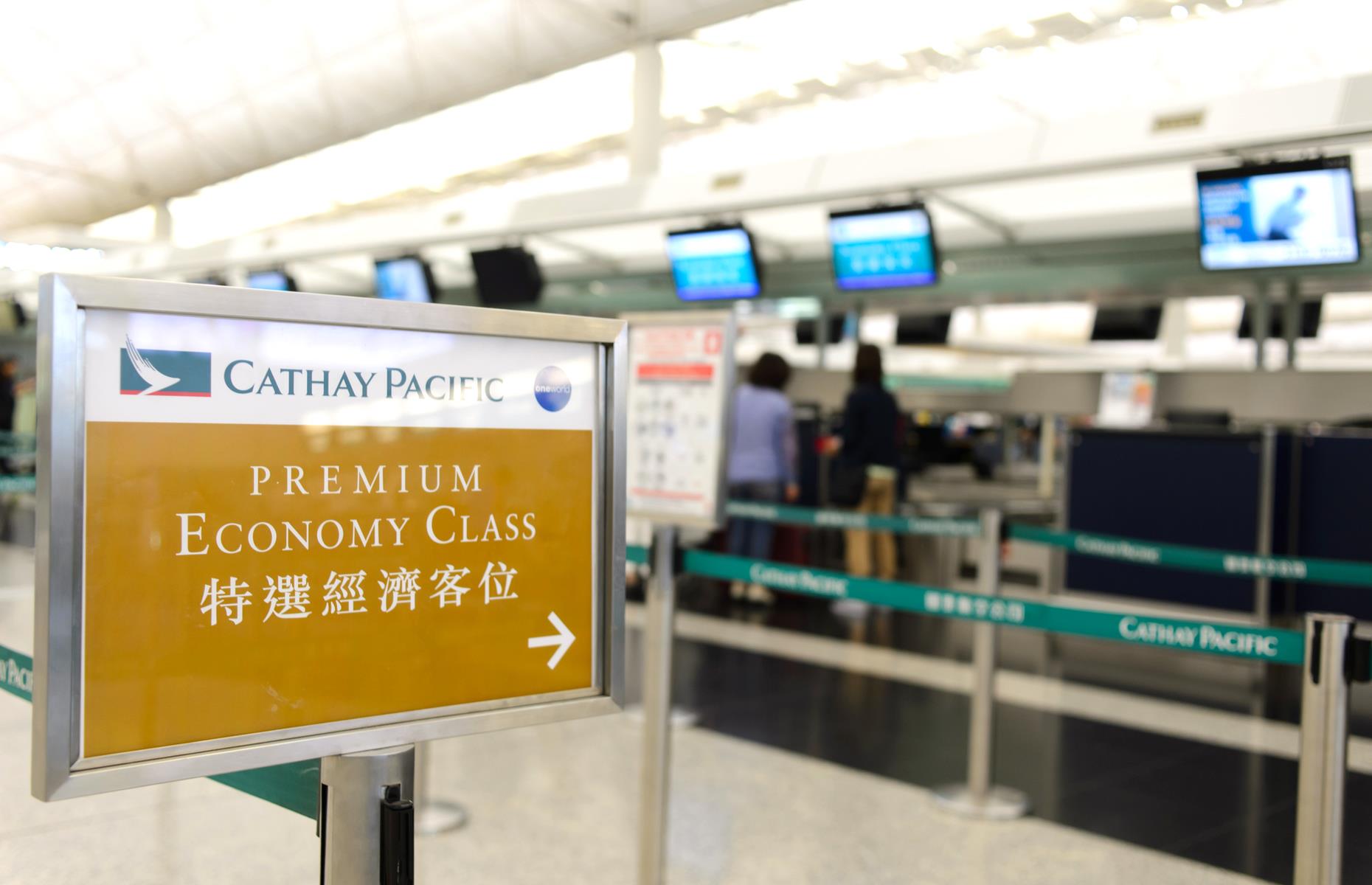
2010s: a sign for premium economy class in Hong Kong International Airport
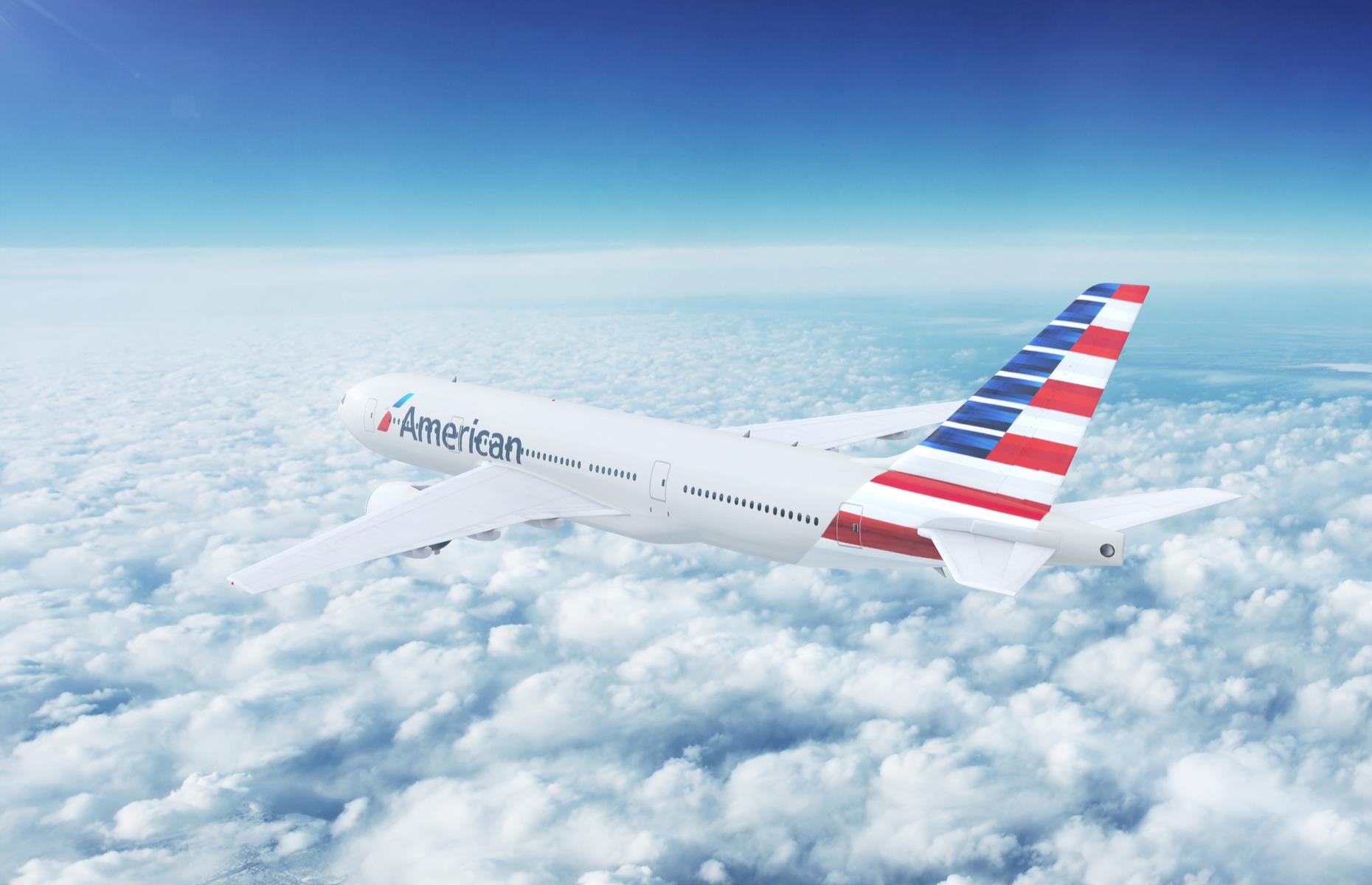
2010s: an American Airlines flight in 2017
The main change in the last decade was the sheer volume of travelers: more and more people were flying than ever before, and the sky-high numbers had previously shown little sign of tailing off. In fact, in 2017, the International Air Transport Association had projected that there could be 7.2 billion air travel passengers by 2035 .

2020s: grounded planes at Berlin-Brandenburg Airport, Germany
The COVID-19 pandemic rocked the travel and aviation industry and both passengers and staff had to adjust to a new (and unpredictable) ‘normal’. Ever-changing international travel restrictions left airlines up in the air (figuratively, not literally), and major players including easyJet, American Airlines and British Airways suffered severe financial losses, resulting in job cuts. This photo from 1 June 2020 shows out-of-service planes at Berlin-Brandenburg Airport.
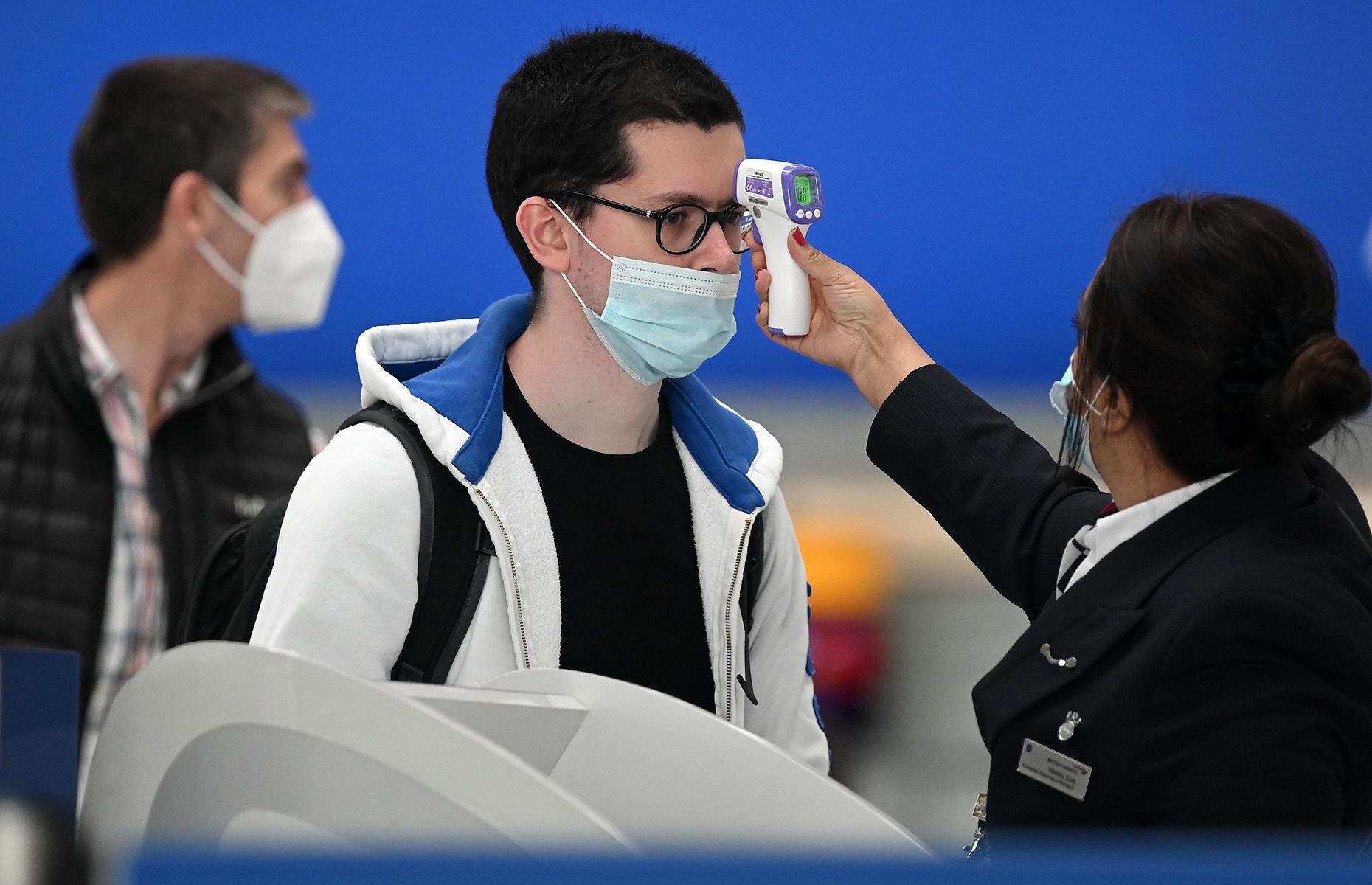
2020s: a passenger undergoes a temperature check at Heathrow Airport
Towards the end of 2020, civil aviation began to resume at a crawling pace, with the announcement of some 'air bridges' or 'travel corridors'. For passengers choosing to fly, airport experiences looked rather different around the world. Protocols and restrictions varied from airport to airport, and from airline to airline, but typically involved mandatory face coverings, contactless check-ins and fewer open airport facilities. A passenger is seen here in July 2020 receiving a temperature check at a BA desk at London’s Heathrow Airport.
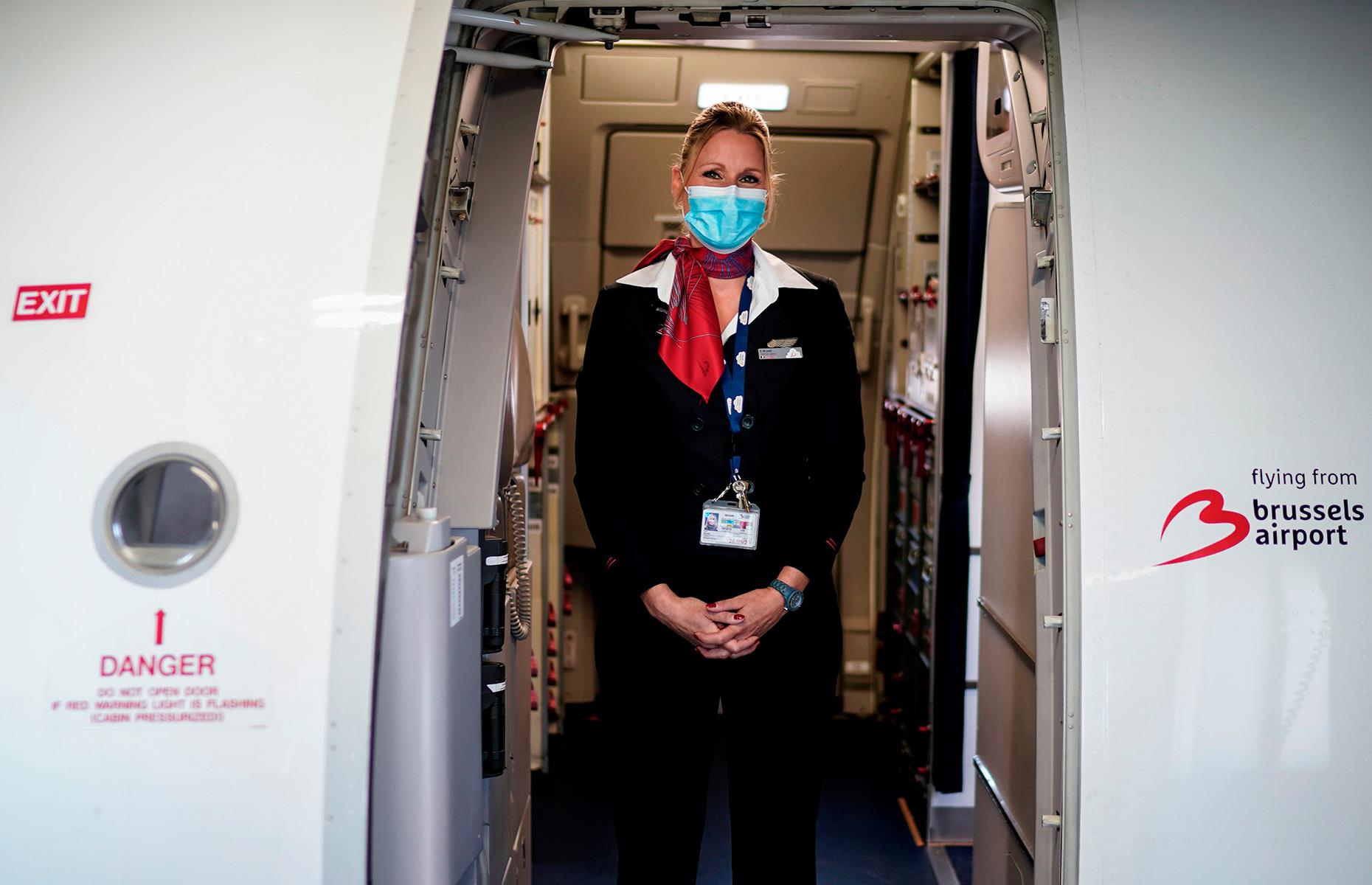
2020s: a masked flight attendant on a Brussels Airlines plane
Passengers had to get used to new onboard experiences too. Depending on the airline – and in efforts to reduce touch points and contact between staff and passengers – changes were extended to a lack of inflight meals or trolley services, and the reduction of little luxuries like in-flight magazines, blankets and the like. Masks were mandatory on most flights too, while some carriers blocked the middle seats to allow passengers more space.
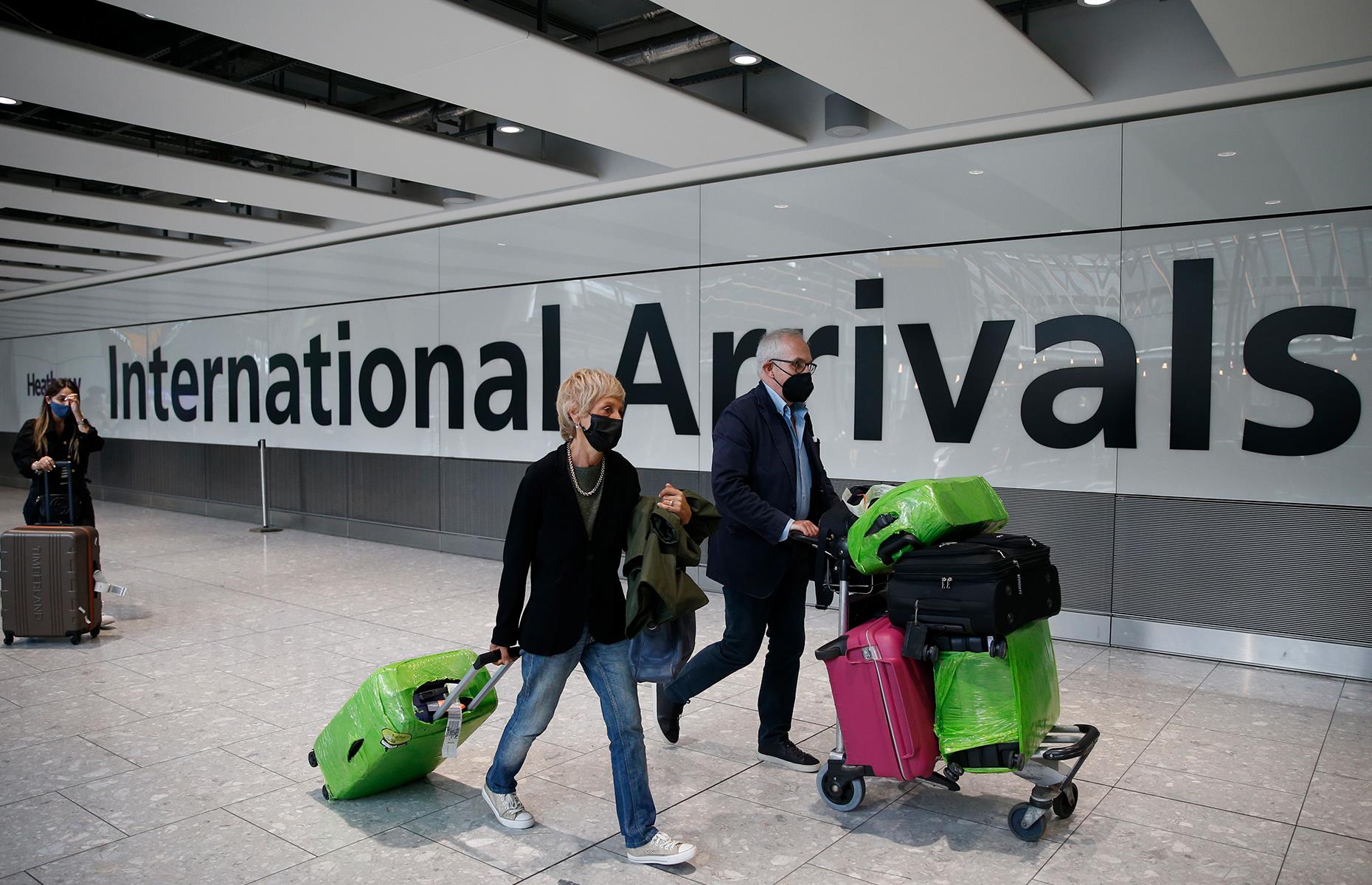
2020s: international air travel gets a slow lift off
The aviation industry continued to feel the effects of the COVID-19 pandemic into 2021, though the International Air Transport Association (IATA) predicted a 50.4% uptick in demand for flights from 2020 . With vaccine programs being rolled out around the world, international borders finally opened.

2020s: a passenger holds up an EU 'vaccine passport'
Around the world, testing and vaccines built bridges between destinations in staggered phases. For example, Canada’s borders first opened to double-jabbed Americans, before being unlocked for vaccinated travelers from around the world too. Double-jabbed UK travelers initially could fly to 'amber' European hotspots including France, Spain and Portugal without quarantining on return (though they had to take PCR tests). New Zealand and Australia also formed a 'quarantine-free travel bubble'. EU citizens could download a vaccine 'passport' (pictured) allowing them to cross EU borders with minimal restrictions.
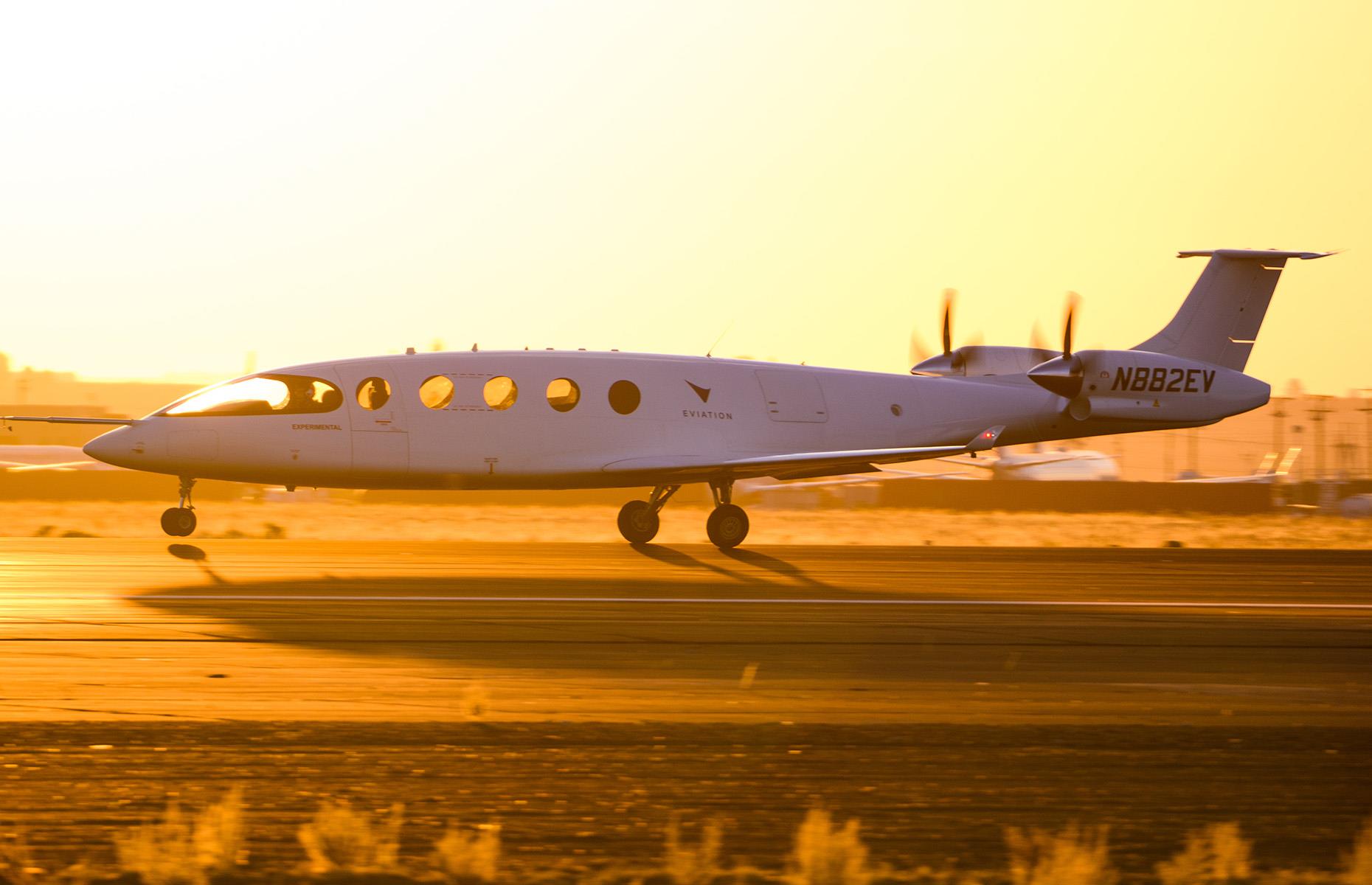
2020s: world's first all-electric plane takes to the skies
In late September 2022, the world's first all-electric plane jetted off for an eight-minute flight above the skies of Washington, USA. Alice, the project name that stuck during planning in 2016, is the brainchild of American-based company Eviation , and will be fit for both passenger and cargo use by 2027. The successful maiden flight reached an altitude of 3,500 feet and the zero-emissions plane was powered by two 640-kilowatt electric motors. It is hoped Alice will operate flights ranging from 150 to 250 miles, and will come in three different configurations: a nine-passenger commuter, a six-seater executive cabin and an eCargo version.
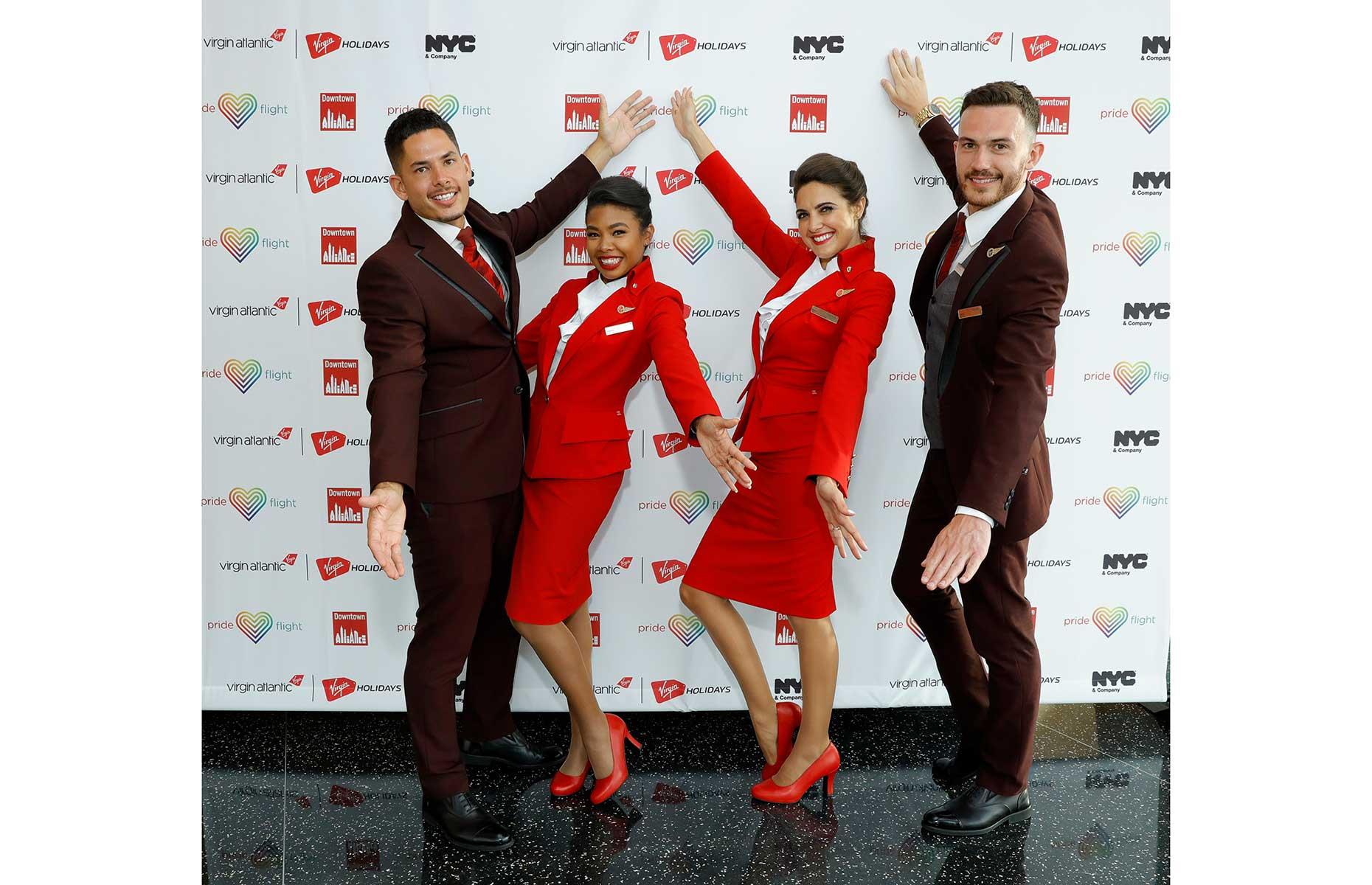
2020s: relaxed uniform policies are welcomed
Cabin crew requirements have changed over the decades; as we've seen already, the 1930s followed strict rules regarding age, height and weight, and since then tailored uniforms and specific hairstyles became the norm. But the 2020s have welcomed a more relaxed approach and in September 2022 Virgin Atlantic ditched gender-specific uniforms allowing crew, pilots and ground staff to choose whichever they feel most comfortable in. Earlier in the year staff were also permitted to keep their tattoos visible, marking the first UK airline to do so.
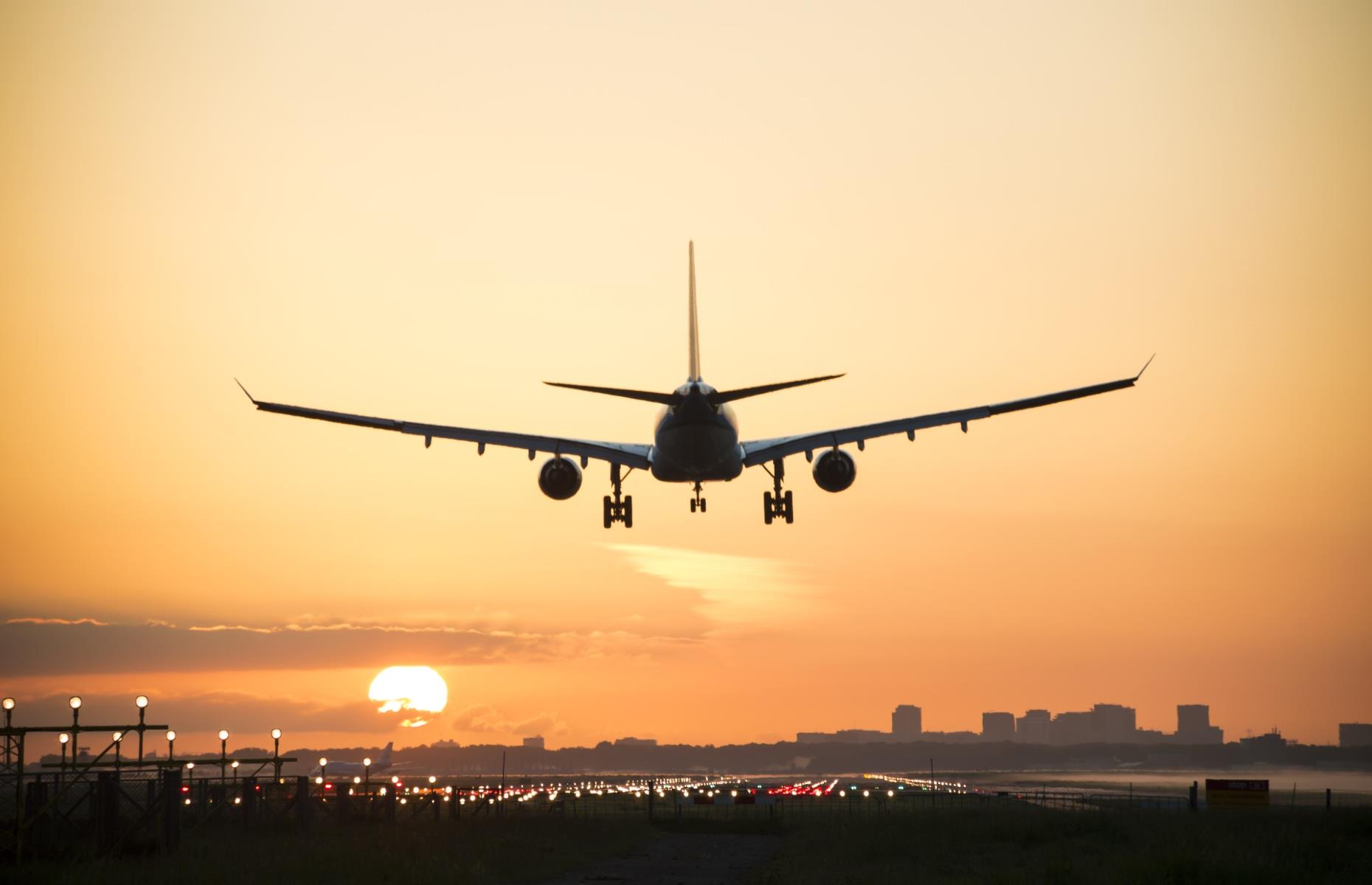
2050: air travel industry set to become carbon neutral
We don't know for sure what the future holds for air travel. But the International Civil Aviation Organisation (ICAO) recently announced its support for a net zero goal for the aviation industry by 2050 . However, environmental campaigners say the plans don't go far enough, believing more measures were needed to ensure the 193 member countries of the ICAO meet the goal and hold airlines accountable.
Now check out the mesmerizing photos from the Drone Photography Awards
More for You
'Sopranos' star doubles down against pro-Biden celebs: 'The far left own Hollywood'
China is now engaged in open hybrid warfare against the West
I Asked 4 Chefs What Their Favorite Fast Food Cheeseburger Was and Their Pick Was Unanimous
Former NBA Player Darius Morris Dead at 33
I drove Subaru's priciest SUV. It's perfect for families who outgrow the Outback or Forester — but the safety tech is vexing.
This James Bond Movie Has The Highest Rotten Tomatoes Score In The Franchise
I study people with high emotional intelligence for a living—8 things they never ever do when talking to others
The Forgotten 'Doom Loop' City of America: $205 Million Skyscrapers Now Selling for Less Than $4 Million
We Ordered 7 Fast-Food Breakfast Sandwiches to Find the Best One
ESPN host slams LeBron James after Lakers fire head coach: 'Take accountability'
Why North Korea's New M2020 Main Battle Tank Is Flashy Garbage
Short and Impactful: The Top 24 Actors Who Defied Height Stereotypes
I Cut My Food Expenses In Half Using The Viral "6-To-1" Grocery Method — Here's How
36 movies to watch before they leave Netflix this month
Kansas City Chiefs release former second-round pick at WR
Jif Is Releasing a New Flavor for the First Time in Nearly 10 Years
Photo finish at 150th Kentucky Derby marred by controversy
Crazy V12-Powered Quad Bike Has Same Performance As A Bugatti Veyron
Happiness Science Says When You Can Say Yes to Any of These 5 Questions, You'll Feel More Fulfilled, Satisfied, and Considerably Less Stressed
Heidi Gardner Was "Very Protective" of Travis Kelce When He Hosted ‘SNL'
The Zeppelin Hindenburg: When Airships Ruled | The Most Amazing Flying Machines Ever
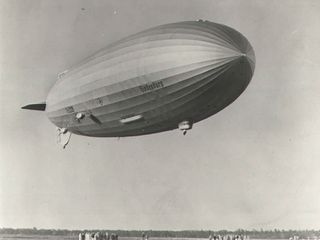
This is part of a SPACE.com series of articles on the Most Amazing Flying Machines Ever, the balloons, airplanes, rockets and more that got humans off the ground and into space.
Huge airships once embodied the future of air travel as they carried passengers across the world's oceans. That dream exploded when the zeppelin Hindenburg, the largest aircraft to ever fly, burst into flames during an attempted landing in New Jersey and collapsed into a smoldering ruin within just half a minute.
The cigar-shaped Hindenburg stretched the length of three football fields at almost 804 feet — more than three times longer than a Boeing 747 jumbo jet. That made it perhaps the most impressive of the rigid airships that used propellers for steering and filled up buoyant cells with hydrogen or helium gas to float through the sky. Such rigid airships stand in contrast to the inflatable designs of hot air balloons and blimps.
Zeppelins made by the German company Luftschiffbau Zeppelin carried out the first strategic bombing missions during World War I. The United States also experimented with turning rigid airships such as the USS Macon and USS Akron into flying aircraft carriers during the 1930s.
Flying across oceans
After World War I, airships began providing the first commercial transatlantic flights during the 1920s and 1930s. Passengers flocked to the zeppelin service as a quicker and cheaper way to cross the world's oceans compared to buying passage on ships. Even New York's Empire State Building had plans to allow dirigibles to dock with its spire (a plan scuttled by gusty winds).
A sister ship of the Hindenburg, the Graf Zeppelin, set the record for flying more miles than any airship. Its 590 flights covered more than one million miles (1,609,344 kilometers) included 144 ocean crossings during 10 years of service. It also flew around the world in just 12 days in 1929.
The Hindenburg made just 63 flights after its construction in 1936. But it could carry more than 70 passengers in style with its own dining room, a writing room, a lounge with a grand piano, and plenty of windows on the sides for viewing the scenery below.
Passengers even enjoyed having their own post office aboard the Hindenburg — the airship represented the largest flying post office ever, according to the U.S. National Postal Museum . The Hindenburg also provided the first regularly scheduled air post service between Europe and North America.
A fiery end
The Hindenburg's end came when it prepared to land at Lakehurst, New Jersey, on May 6, 1937. Flames erupted as the airship settled in near its mooring mast, and the huge airship was consumed within just 32 seconds. Luckily, 62 of the passengers and crew survived by jumping out the windows to the ground — the death toll came to 35 people on board and one member of the ground crew.
Historians still debate what brought about the downfall of the Hindenburg and the end to people's confidence in hydrogen-filled airships. Many have pointed to the flammable hydrogen gas as the reason why the airship went up in flames so quickly. A competing theory that implicated incendiary paint on the outside of the airship was largely discredited by a 2005 paper.
Whatever the case, the golden age of airships was over. Fixed-wing aircraft continued their rise as they dominated the skies for both war and commercial flights.
But lighter-than-air blimps or hybrid airships could still end up flying into the future. The U.S. military has experimented with using both blimps and airships as high-flying surveillance platforms over battlefields, and planetary scientists envision robot blimps soaring on Mars or other worlds someday.
The Greatest Moments in Flight
- The First Hot-Air Balloon
- The First Powered Airship
- The Wright Brothers & the First Flight
- World's First Commercial Airline
- Charles Lindbergh & the First Solo Transatlantic Flight
- Breaking the Sound Barrier
The Most Amazing Flying Machines Ever
- The First Airplane: Wright Flyer
- The Red Baron & Aerial Weapons of World War I
- The First Fighter Jet: Me 262 Schwalbe
- SR-71 Blackbird: Supersonic Spy Aircraft
- Saturn V Rocket & Apollo Spacecraft
Image galleries:
- Airplanes of Tomorrow, NASA's Vision of Future Air Travel
- Amazing X-Planes from the X-1 to XV-15
Join our Space Forums to keep talking space on the latest missions, night sky and more! And if you have a news tip, correction or comment, let us know at: [email protected].
Get the Space.com Newsletter
Breaking space news, the latest updates on rocket launches, skywatching events and more!
Jeremy Hsu is science writer based in New York City whose work has appeared in Scientific American, Discovery Magazine, Backchannel, Wired.com and IEEE Spectrum, among others. He joined the Space.com and Live Science teams in 2010 as a Senior Writer and is currently the Editor-in-Chief of Indicate Media. Jeremy studied history and sociology of science at the University of Pennsylvania, and earned a master's degree in journalism from the NYU Science, Health and Environmental Reporting Program. You can find Jeremy's latest project on Twitter .
Virgin Galactic to launch 7th commercial spaceflight on June 8
China launches Chang'e 6 sample-return mission to moon's far side (video)
X-ray spacecraft reveals odd 'Cloverleaf' radio circle in new light (image)
Most Popular
- 2 Where will the annular solar eclipse on Oct. 2, 2024 be visible?
- 3 Boeing Starliner rolls out to launch pad for 1st astronaut flight on May 6 (photos)
- 4 The history of the Jedi Order in 'Star Wars'
- 5 Star Wars Day 2024: 'Star Wars: Tales of the Empire' premieres today on Disney+
THIS SITE USES COOKIES
We use cookies to ensure you get the best experience on our website. Find Out More .
- Search Search
- Jet Portal Login
- News & Blogs
- ACS Websites
- Private Jet Charter
- Change Language
- ENGLISH (US)
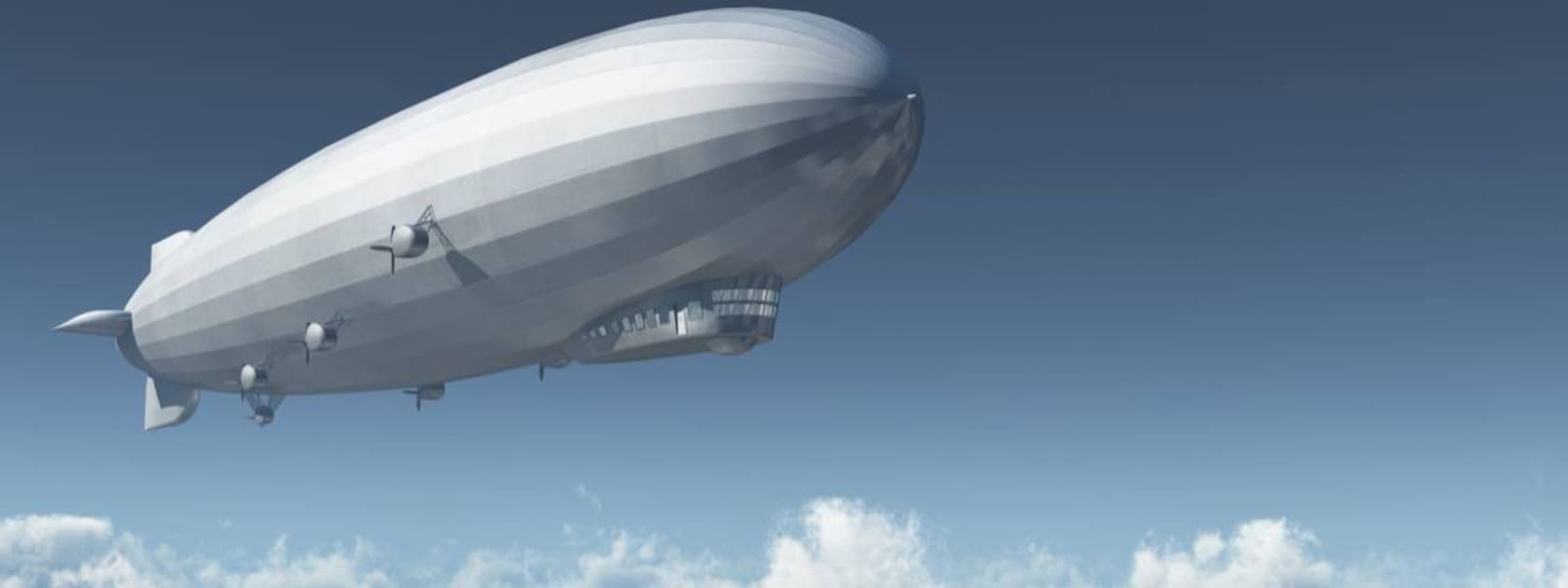
Claire Ellis
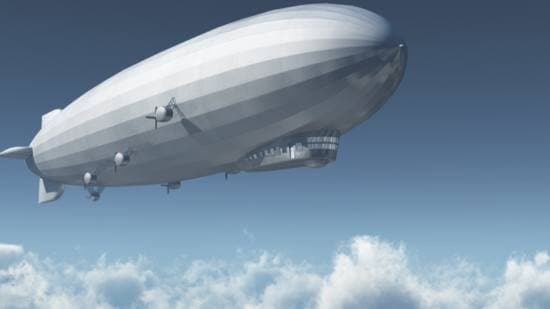
The History of Airships and Airship Travel in Commercial Aviation
Airships were thought to be the future of commercial aviation until the Hindenburg disaster. But could they be making a comeback? We take a look at the history of airships, from passenger flights to military and advertising blimps, and glimpse at a future that could include private charter flights aboard them some day.
What is an airship?
Also known as a “dirigible balloon” or “blimp”, the classic airship is a large gas balloon that rises into the air and can be steered using engine-driven propellers. Similar to hot-air balloons, they’re powered by gases like hydrogen and helium which are lighter than air. Airships come in three broad types: rigid and semi-rigid designs use metal frames to keep the balloon’s shape, while non-rigid balloons are inflated by gas alone. Airships have most commonly been used throughout history as:
Passenger airships – The US, Britain, and Germany developed large, rigid airships for passenger flights, which were popular in the 1920s and 1930s. While the US had access to helium, other airships used highly flammable hydrogen; and many exploded in-flight, bringing private flights to an end.
Military airships – Germany used its famous Zeppelin airships to carry out bombing raids in the First World War, inspiring the British Royal Navy to create their own B-Class airships for detecting German submarines. Since then, airships have mainly been used as aerial surveillance for military forces.
Advertising blimps – Commercial blimps have been used for advertising since 1925. Since they can hover over one space and be seen from afar, they’re particularly effective for advertising at outdoor events, and retain their “wow” factor to this day.
The early history of airships
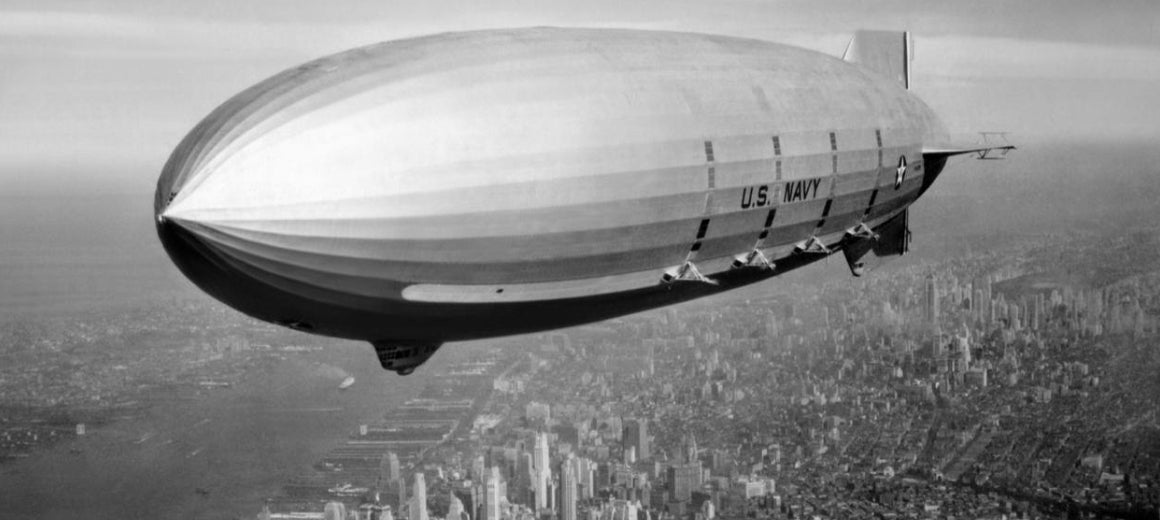
The airship’s story starts in France, following the invention of the hot-air balloon in 1783. Inspired by the creation, engineer Jean Baptiste Meusnier designed an elaborate dirigible with a 276ft-long elliptical balloon powered by three propellers, featuring a boat-like basket attached to the balloon by ropes.
His design was never built, but shortly after in 1785, French inventor Jean-Pierre Blanchard and American Dr John Jeffries crossed the English Channel in a hydrogen balloon. During the two-and-a-half-hour flight, the pair had trouble steering the balloon, which was also overloaded, and dipped dangerously close to the water. To lighten the load, Blanchard and Jeffries threw out their cargo and even stripped off their clothes.
In the following years, airship design developments came thick and fast. In 1852, French engineer Henri Giffard flew the first steam-powered hydrogen-balloon airship with steering. However, a key turning point came with the creation of the Zeppelin airship in 1895, which was patented by Count Ferdinand von Zeppelin and built by aviation pioneer David Schwarz.
The rise of Zeppelin and Goodyear airships
The Zeppelin was a rigid airship, featuring a long, thin, tough-skinned balloon filled with hydrogen gas. Small crew and passenger compartments were suspended beneath it, and there were two 15-horsepower engines, which allowed the airship to fly at 25 miles per hour. Zeppelins were mainly used for scenic passenger flights, but 20 were built to bomb Britain during the First World War, and were successful owing to their speed and ability to carry heavy loads.
Over in the US, 1925 saw the first flight of the Goodyear Pilgrim, a 110ft-long, 45ft-high helium airship. The Pilgrim was powered by an 80-horsepower engine and was the smallest airship in the world, capable of carrying two passengers as well as the pilot and mechanic. The Goodyear was popular with luxury pleasure cruise passengers but later used by the US Navy and Army for surveillance. Today, many people know Goodyear airships as advertising blimps.
The Hindenburg disaster
Airship travel took a dramatic turn in May 1937, when the world’s largest passenger Zeppelin, LZ 129 Hindenburg, exploded while landing in New Jersey, killing 13 passengers, 22 crew members and one person on the ground. The devastating crash was caught on camera by television crews and, along with a string of other airship fires, the Hindenburg disaster was largely responsible for ending private flights on passenger airships.
Just a year before the crash, the Hindenburg had successfully flown across the North Atlantic, becoming an icon for airship travel. The vessel was known for its luxurious interior, similar to five-star cruise ships and the opulence of today’s private jet charters . The Hindenburg had 34 double-berth cabins capable of accommodating 72 passengers, as well as lavish dining rooms and lounges. There was also a writing room, bar, promenades for spectacular aerial views and, unbelievably, a smoking room.
In the wake of the Hindenburg crash, airships were mainly used by the military for surveillance purposes and to carry cargo to remote areas. In 1984, for example, the US Navy funded a project to develop airships with turboprop engines for coast-guard missions. This was later discontinued owing to budget cuts. Elsewhere, though, Westinghouse and Airship Industries continued their work on airship designs – and developed the Sentinel 1000, which had its maiden flight in 1991.
Future of airship travel
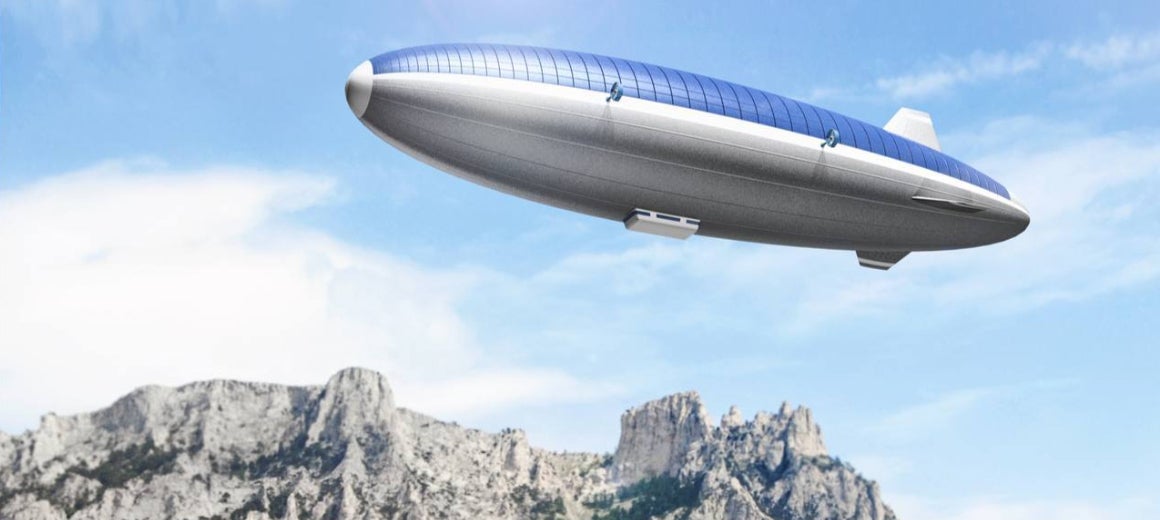
Where are we now? What’s the current state of the industry? Are airships making a comeback? Here are some of the ways airships are currently being used or may be used in future:
Delivering aid relief – Airships can reach remote areas because they don’t need a runway, and can be lowered and tethered without touching the ground. The Aeroscraft, for example, is a rigid-shell airship that can deliver cargo without having to land. In 2017, UK airship developer Hybrid Air Vehicles test-flew its Airlander 10, which is part helicopter, plane, and airship. It’s the world’s largest aircraft at 302ft long and is perfect for carrying cargo to disaster areas.
Scientific monitoring – In 2013, Goodyear and Zeppelin Luftschifftechnik joined forces to create a fleet of super-fast, quiet Goodyear blimps. These models have been used in various scientific projects and experiments.
Eco-flights – As environmental concerns grow, sustainable air travel is rising in popularity. Given their low fuel costs and emissions, airships could make a comeback, similar to the rise in popularity of drones. Battery-powered airships can be entirely emission-free and are virtually silent. Who knows: some day airships might join the list of charter aircraft that would be perfect for a luxury vacation or your next company team-building event!
Communication and surveillance – Airships are a possible option for low-cost border surveillance, security and communication. For example, the Long Endurance Multi-Intelligence Vehicle (LEMV), developed by Northrop Grumman for the US Army, can offer 21 days of continuous air surveillance.
Leisure flights – Modern airships benefit from technical advances and use of helium rather than flammable hydrogen. This means they could become popular for passenger flights again (although who knows how ticket prices will compare to your average private plane rental). In fact, as of 2017, Zeppelin is running 12 scenic tourist routes across Germany and Switzerland, and plans to introduce flights in China.
Private charters – Welcome to the future! If you’re a private jet enthusiast, then you’d better add “a future airship flight” to your bucket list! And it’s just around the corner. The previously mentioned UK firm, Hybrid Air Vehicles, is forecasting a 2024 launch of passenger journeys that promise travelers an experience that’s more like a journey on board a cruise ship or yacht, including lounges, viewing decks, master suites, health spas, and offices. So if you thought chartering a jet was the pinnacle of luxury, a higher peak might just be coming into view!
Carve out your own luxury on a private plane
As commercial aviation evolves, it seems the story of the airship is set to continue, and who knows when this aircraft may become an alternative to chartering a plane. In the meantime, for some exclusive air travel of your own, check out Air Charter Service (ACS): we can provide you with a private jet quote in no time at all. If you’d prefer to speak to one of our local travel and concierge experts, contact us to hear how we can turn your next trip into an luxuriously comfortable and ultimately convenient travel experience that meets all your plane rental requirements.
MORE ARTICLES
RELATED ARTICLES
- Inquire Now
- DEDICATED ACCOUNT MANAGERS
- NO OBLIGATIONS
- 30+ YEARS EXPERIENCE
- AVAILABLE 24/7
- I consent to Air Charter Service using my information to contact me by telephone and email about my inquiry and / or related products and services.
- I accept the Privacy and Cookie Policy .
This is what it was like to fly in the 1930s

While mankind's foray into flying began in the early 20th century, the modern air travel industry as we know it didn't truly grow its roots until the 1930s. As metal planes returned home from post-war posturing, a boom in passenger interest and sufficient technology to reach a slew of international destinations made the 1930s the start of something big. But like any major technology, commercial flight didn't come without growing pains. If you think you have a lot to complain about now when it comes to air travel, take a look at what it was like to fly in the 30s.
The birth of a global sensation. Just 6,000 Americans traveled commercially by airplane in all of 1930, according to Smithsonian National Air and Space Museum . Only four years later, that number would multiply by 75 times — 450,000 passengers flew in 1934, a number that would be dwarfed once more in another four years, when 1.2 Million Americans traveled by air. The 1930s were truly the decade that commercial air travel became a worldwide sensation.
The transition from wood to metal planes changes the world. In the aftermath of World War I, the victorious nations found themselves with quite a significant number of planes — both fighter and support vehicles — on hand. And just like that, the commercial air travel industry, ahem , took off. New, metallic planes weren't just more durable during wartime ; they also withstood the dramatic changes in climate that a vehicle might experience when traveling between, say, Boston and the Caribbean. Metal-bodied planes didn't just enable longer routes, they enabled air travel along longitudinal lines, where climates change from arctic to temperate to tropical to arid, and then back again.
Higher! Faster! A decade of full throttle flying. The transition to metal planes enabled aircraft to push past the limitations that had remained mostly set in stone since the advent of flight. The first commercial flight in 1914 hovered at a cruising altitude of just 5 feet in the air . In the 1930s, planes began to hit the 200 mph mark, and settled into a cruising altitude of about 13,000 feet .
Not for the faint of heart. British Airways Empire Class planes in the 1930s were equipped with three state-of-the art flying lavatories, but it was widely understood that their actual usage was to be avoided at nearly all costs. Just because we as humans suddenly could fly at 13,000 feet didn't mean that we had necessarily worked out all of the kinks just yet. According to Gizmodo, planes would regularly drop hundreds of feet mid air with no warning. Today's gentle alerts from the cabin to return to your seat and buckle up as the plane may experience some coming turbulence were born out of the horror of this era's actually turbulent flights.
Not if , but when you get sick. While experiments with oxygen enrichment of cabin air date back to the early 1920s, widespread adoption of standardized cabin pressurization didn't hit the airline industry until the 1940s , according to the American Institute of Aeronautics and Astronautics. This meant that oxygen tank-assisted breathing was a regular occurrence on flights in the 30s, and air sickness bowls could be found under each seat.
Extreme temperature fluctuations were also an unfortunate fact of flying at the time. Air conditioning and heating wouldn't alleviate these discomforts until the end of the decade. We have blankets on flights today because of the absolutely necessity for them in the 1930s.
It cost an arm and a leg (or half a car). A roundtrip ticket from coast to coast cost about $260 in the 1930's . Some context: the average automobile at the time cost just double that. Flying was an exciting new thrill, but only for the few who could afford it.
Pack a book to read (Or maybe just write one of your own). Our great-grandparents would be embarrassed at our tendency to bemoan the hardships of a 15 hour, non-stop flight . Today's 12-hour flight from London to Singapore would have taken 8 days in 1934 , with 22 separate layovers to refuel in exotic locales like Athens, Gaza, Baghdad, Sharja, Calcutta and Bangkok. While we may cringe at that sort of time-intensive itinerary today, it sure beat the then month-long trek by boat that was really the only alternative.
All roads lead to Cairo. While London Heathrow, Dubai and Atlanta hog the limelight when it comes to major hubs here in the present, in the 1930s it was all about Cairo . Uniquely positioned as a nexus between Europe, Africa and Asia, you would have been hard-pressed to travel anywhere between the three without touching down in Cairo along the way.

COMMENTS
Commercial Airlines initially struggled to get off the ground, but with help from the government, who awarded airlines contracts to deliver the mail, they soon began to flourish. Despite the Great Depression, air transportation experienced phenomenal growth and change from the late 1920s through the 1930s, before U.S. entry into World War II intervened.
Tagged 1920 airplanes, 1920s passenger planes, air travel in the 1920s, aviation in the 1920s Rob V. He holds commercial single and multi-engine instrument ratings, and is a licensed CFI / CFII for both single and multi-engine aircraft.
The most important difference is that air travel in the 1920s was much less comfortable than it was today. Flights were not climate-controlled or noise-controlled, and simple amenities such as in-flight toilets were not added until 1928. The culture around flying was also very different. It was rare, expensive, and not very efficient; people ...
As the decade of the 1940s ended, the era of commercial flight between the 1950s and 1960s was born and became known as the 'Golden Age of Air Travel' and the 'Jet Age'. By 1950, the trans-Atlantic route became the most traveled in the world, and its growing trade produced high profits and intense competition between major international ...
But despite the advances in air travel and the aspirations of businessmen who hoped to get in on the ground floor of a new multimillion-dollar business, airlines in the 1920s that promoted passenger-only routes lost money. Profitable passenger airlines would not be realized until the 1930s. —Rich Freeman. Sources and References. Allen, Oliver.
Here's a look back at what traveling was like 100 years ago. Commercial flights have been taking to the skies for more than a century. In the early 1920s, aviator Alfred W. Lawson built a series ...
^ Century of Flight: Commercial Aviation 1920 to 1930. Retrieved 2014-07-04. ^Nick Komons, Bonfires to Beacons: Federal Civil Aviation Policy under the Air Commerce Act, 1826-1938 (Washington, D.C.: U.S. Department of Transportation, 1978), 67 (as cited in Crouch, p.249.). ^ Airline Handbook Chapter 1: Brief History of Aviation. Retrieved 2014 ...
However, it wasn't until the 1920s that commercial flights carrying paying passengers started to become commonplace with the introduction of the multi-engine airplane, the Lawson C-2, which was specifically built to carry passengers. ... Commercial air travel was booming, and major airlines were fiercely competitive, offering passengers more ...
Flight naturally became even more of a sport in the early 1920s, and it also encouraged aviators to push the limits of flight (transatlantic challenges), but many others saw its commercial potential. As early as August 1919, Aircraft Transport & Travel began its aeroplane service from London to Paris.
The 1950s are considered the golden age of air travel. Passengers dressed up and enjoyed inflight meals of prime rib and lobster. Passengers relaxing in lie-flat seats in the 1950s. Douglas Miller ...
November 6, 2019. Flight map of Air India destinations from 1962. Courtesy of Air India. On January 1, 1914, the first scheduled passenger flights began soaring through the skies between St ...
T he First World War (1914-18) hastened the development of aeroplanes which were then in their infancy, so that by the early 1920's they were much more reliable and capable of flying longer distances and carrying heavier loads. This made possible the carrying of passengers and freight on a commercial basis. New Planes, Dirigibles and Flight Records. The ability to travel long distances quickly ...
This exhibit is now closed. Americans were wild about aviation in the 1920s and '30s, the period between the two world wars that came to be known as the Golden Age of Flight. Air races and daring record-setting flights dominated the news. Airplanes evolved from wood-and-fabric biplanes to streamlined metal monoplanes.
In the early days of the 20th century, an exciting new mode of travel became possible. Anyone with enough money could take to the skies on a commercial flight. Trips that would take weeks by sea ...
United States Origins Areas covered by commercial air routes in 1925. Harry Bruno and Juan Trippe were early promoters of commercial aviation.. The Air Commerce Act of 1926 began to regularize commercial aviation by establishing standards, facilitation, and promotion. An Aeronautical Branch was established in the Department of Commerce with William P. MacCracken Jr. as director.
The story of commercial air travel begins before the 1920s, in 1914, when the world's first scheduled passenger service set off between Tampa and St Petersburg, piloted by Tony Jannus.
Flying across oceans. After World War I, airships began providing the first commercial transatlantic flights during the 1920s and 1930s. Passengers flocked to the zeppelin service as a quicker and ...
Home / Explore / Stories / Commercial Aviation At Mid-Century. In 1955, for the first time, more people in the United States traveled by air than by train. By 1957 airliners had replaced ocean liners as the preferred means of crossing the Atlantic. The era of mass air travel had begun. Air transportation changed dramatically during and after ...
The early history of airships. The airship's story starts in France, following the invention of the hot-air balloon in 1783. Inspired by the creation, engineer Jean Baptiste Meusnier designed an elaborate dirigible with a 276ft-long elliptical balloon powered by three propellers, featuring a boat-like basket attached to the balloon by ropes.
Air travel in the 1920s and 1930s was not confined to journeys on commercial airlines. Wherever flying had taken hold, and especially where flying clubs had been established, people flew privately for pleasure in small, light aircraft. Some journeys tracked commercial air routes across continents.
The first commercial flight in 1914 hovered at a cruising altitude of just 5 feet in the air. In the 1930s, planes began to hit the 200 mph mark, and settled into a cruising altitude of about ...